
O. S. Pratt
The Project Gutenberg EBook of The Horse's Friend, by O. S. Pratt
This eBook is for the use of anyone anywhere in the United States and most
other parts of the world at no cost and with almost no restrictions
whatsoever. You may copy it, give it away or re-use it under the terms of
the Project Gutenberg License included with this eBook or online at
www.gutenberg.org. If you are not located in the United States, you'll have
to check the laws of the country where you are located before using this ebook.
Title: The Horse's Friend
The Only Practical Method of Educating the Horse and
Eradicating Vicious Habits
Author: O. S. Pratt
Release Date: September 1, 2020 [EBook #63098]
Language: English
Character set encoding: UTF-8
*** START OF THIS PROJECT GUTENBERG EBOOK THE HORSE'S FRIEND ***
Produced by Julia Miller and the Online Distributed
Proofreading Team at https://www.pgdp.net (This file was
produced from images generously made available by The
Internet Archive/American Libraries.)

O. S. Pratt
THE ONLY PRACTICAL METHOD
OF
EDUCATING THE HORSE
AND
ERADICATING VICIOUS HABITS,
FOLLOWED BY A VARIETY OF VALUABLE RECIPES, INSTRUCTIONS IN FARRIERY, HORSESHOEING,
THE LATEST RULES OF TROTTING, AND THE RECORD OF
FAST HORSES UP TO 1876.

By Prof. O. S. PRATT.
TENTH THOUSAND.
Illustrated by over One Hundred and Forty Elegant Engravings.
BUFFALO:
PUBLISHED FOR THE AUTHOR.
1876.
Entered according to act of Congress, in the year 1875, by
O. S. PRATT,
In the Office of the Librarian of Congress at Washington, D. C.
Entered according to the act of the Parliament of Canada, in the year 1876, by
O. S. PRATT,
In the Office of the Minister of Agriculture.
The Electrotyping, Printing and Binding, by
The Courier Company,
Buffalo, N. Y.
The Drawing and Engraving, by the
Bureau of Illustration,
Buffalo, N. Y.
To His Excellency, Ulysses S. Grant, President of the United States; to the members of the two houses of Congress, and to the gentlemen connected with Foreign Legations, who have belonged to my private classes, in connection with the thousands in all the principal cities and towns of the United States and Canada, who have been members of my various classes, this work on The Education of The Horse, is respectfully dedicated. Cheered by their presence, and encouraged by their approbation during the eight years in which the author has been engaged in diffusing a knowledge of his system of Equine Education, their generous appreciation continues to fill the present with treasured memories of the past, amongst the most prized of which is that of the friendship it has been his happiness to secure from gentlemen distinguished alike in the walks of politics, religion, science, literature and art.
The Author.
| Portrait of O. S. Pratt, | Frontispiece. |
| The old homestead, | 16 |
| My first store in Batavia, | 22 |
| My second and enlarged store, | 26 |
| Gold-headed cane, | 51 |
| Gold-mounted whip, | 61 |
| Portrait of Mrs. Pratt, | 78 |
| Washington gold medal, | 82 |
| Bridgeport Academy, | 94 |
| Nahant Beach residence, | 100 |
| Lewiston Academy, | 108 |
| Music box, | 120 |
| Silver tea-service, | 130 |
| New method of haltering a wild colt, | 160 |
| To educate to the words “Come here”, | 164 |
| How to lay a horse down, | 168 |
| How to get a horse up that throws himself, | 172 |
| To educate a colt not to be afraid of his heels, | 176 |
| To educate a colt to drive before being harnessed, | 180 |
| To educate a colt to move his body and head, | 184 |
| Improved method of bitting a colt, | 188 |
| Educating the colt to ride, | 192 |
| Instructions to ride the colt, | 196 |
| To halter-break a colt, | 200 |
| To educate a horse not to kick in the stable, | 204 |
| To educate a horse not to paw or kick in the stable, | 208 |
| To educate a horse not to get cast in the stall, | 212[v] |
| To educate a colt to lead behind a wagon, | 216 |
| To educate a horse bad to catch, | 220 |
| To educate a horse not to rear, | 224 |
| To educate and prevent a horse from cribbing, | 226 |
| To educate and break a halter-puller, | 232 |
| To educate a horse not to kick when line gets under his tail, | 236 |
| To educate a horse not to kick, | 240 |
| To educate a horse bad to groom, | 246 |
| Bits used in educating horses, | 250 |
| To educate horses not to fear objects when driving, | 256 |
| To educate a horse not to fear an umbrella, | 260 |
| Second lesson, | 264 |
| To educate a single-footed horse to trot square, | 268 |
| To educate a pacing horse to trot, | 272 |
| To educate a horse to trot, | 276 |
| To educate a horse not to kick while in shafts, | 280 |
| To educate a lazy horse and infuse life into him, | 286 |
| To start a balky horse, | 290 |
| To educate a balky horse, | 294 |
| To educate a horse not to kick while being shod, | 298 |
| To educate a horse while standing bad to shoe, | 302 |
| Double-hitch Bonaparte bridle, | 306 |
| Controlling a horse bad to shoe, | 310 |
| To educate a horse not to fear the cars, | 314 |
| To educate a horse to back at the word of command, | 318 |
| To educate horses or cattle not to jump fences, | 322 |
| To educate a cow not to kick while being milked, | 326 |
| To educate a cow to let her milk down, | 330 |
| Practical results of foregoing education, | 334 |
| To educate cattle to lead behind a wagon, | 338 |
| To educate a tender-mouthed horse, | 342 |
| To educate horses not to fear a buffalo robe, | 345 |
| Patent steel and hoof-expanding shoe, | 362[vi] |
| To educate a horse to mount a pedestal, | 366 |
| To educate a horse to walk on his hind feet, | 370 |
| To educate a horse to push a vehicle, | 376 |
| To educate a horse to be vicious, | 378 |
| To educate a horse to walk on his knees, | 382 |
| To educate a horse to drive a boy off the pedestal, | 386 |
| To educate a horse to sit down, | 390 |
| To educate a horse to bore for oil, | 394 |
| A sure method of making a horse bad to catch, | 398 |
| To educate a horse to take a handkerchief from his side, | 402 |
| To educate a horse to kiss a boy, | 406 |
| System of educating dogs, | 410 |
| Another illustration of educating dogs, | 414 |
| Curing colic in horses, | 418 |
| The only practical way to give a horse medicine, | 422 |
| New method of telling the horse’s age, | 426 and 427 |
| To prevent horses from interfering or overreaching, | 440 |
| Paring the hoof, | 451 |
| Long foot before treatment, | 452 |
| Long foot after treatment, | 453 |
| Coffin-bone, | 454 |
| Fitting a shoe to remove pressure from the heel, | 456 |
| Instructions respecting the feet, | 457 |
| Contracted foot after treatment, | 458 |
| Expanding the foot after it has been pared out, | 461 |
| Lateral quarter-crack before treatment, | 462 |
| Quarter-crack under treatment, | 463 |
| Straight quarter-crack under treatment, | 464 |
| Quarter-crack after treatment, | 467 |
| Toe crack before treatment, | 468 |
| Toe crack after treatment, | 473 |
| Four engravings showing thrush and pumice foot, | 474 |
| Hoof-bound, under treatment, | 475[vii] |
| Overgrowth of hoof, | 479 |
| Overgrowth of hoof—front view before treatment, | 480 |
| Overgrowth of hoof—front view after treatment, | 481 |
| Navicula—enlargement of metacarpal bone, | 482 |
| Showing how to find enlargement of metacarpal bone, | 488 |
| A foot that is deprived of the free use of the back tendons, | 490 |
| Ossified growth of upper and lower pastern joint, | 491 |
| The sensitive frog, | 492 |
| Section of the pastern and other bones, | 494 |
| CHAPTER I. | |
| Introduction—Early Life—Thirst for Knowledge—First Attempts in Business—Success—Marriage, | 11 |
| CHAPTER II. | |
| Enlarging Business—Attachment to the Horse—Visits to Batavia of Rarey and Hamilton—My own System—Coming before the Public—Early Success, | 24 |
| CHAPTER III. | |
| Visit to Montrose—Large Class at Scranton—Diploma—Wilkesbarre—Enthusiastic Reception—Complimentary Notice—Testimonial, | 35 |
| CHAPTER IV. | |
| Across the Mountains—Easton—Hamburg—Lancaster—Testimonials—Westchester—Diploma—Philadelphia—Class of 2,523—Cane, | 41 |
| CHAPTER V. | |
| York—Port Deposit—Baltimore—Success—Diploma—Getting Whipped—Class of 3,500, | 56[ix] |
| CHAPTER VI. | |
| Washington—A Large Class—The President a Pupil—The White House—Halls of Congress—Diploma—Dr. Newman’s Address—Gold Medal, | 67 |
| CHAPTER VII. | |
| Annapolis—Delaware—New Jersey—New York State—The Great Emporium—Chicago in Flames, | 84 |
| CHAPTER VIII. | |
| Bridgeport—Fall of Academy—Providence—Boston—Class of 3,000—Lynn—Purchase of a Residence—Portland—Bangor, | 95 |
| CHAPTER IX. | |
| Lewiston—Educating the Horse “Anfield”—Testimonial—Concord—Manchester—A Steam Engine in the Ring—Lowell—Lawrence, | 104 |
| CHAPTER X. | |
| Tour in Canada—Montreal—Class of 1,000—Victoria Bridge—Cathedral—Quebec—Ottawa—Kingston—Detroit—Diploma—Valuable Testimonial—Simcoe, | 113 |
| CHAPTER XI. | |
| Toronto—“British Ensign”—Diploma—Silver Tea-Set—Hamilton—Belleville—Diploma—Picton, | 124[x] |
| History of the Horse, | 141 |
| Directions for Feeding and Fitting Horses, | 154 |
| System of Educating the Horse, | 161 |
| Intelligence of Animals, | 345 |
| Trick Horses, | 363 |
| Educating Dogs, | 411 |
| Miscellaneous, | 419 |
| Training Steers, | 428 |
| Treatise on Horseshoeing, | 431 |
| Dunbar System of Horseshoeing, | 445 |
| Recipes, | 496 |
| Record of Fast Horses up to 1876, | 513 |
| Revised Rules of Trotting Course, | 521 |
INTRODUCTION—EARLY LIFE—THIRST FOR KNOWLEDGE—FIRST ATTEMPTS IN BUSINESS—SUCCESS—MARRIAGE.
In the social interchanges of life it is always pleasant to possess some knowledge of the antecedent history of the ones we meet; to know who and what they are; while to one who feels that there is something in his own career not unworthy of notice, there is a satisfaction in recounting the steps by which his success has been attained; especially, if in gaining it he has been called to contend with difficulties and vanquish obstacles which opposed his progress. Such narratives may prove helps and encouragements, as they show what energy and perseverance have achieved, and thus stimulate others to stronger and more successful endeavors.[12] This was taught by the greatest of our American poets in his well-known lines:
Although few men may lay claim to greatness in its military, political or literary sense, there is something in every earnest life which will interest and instruct other men, and which may prove an assistance to some, who, with failing hearts are engaged in life’s stern battle. With this brief explanation of his design, the author of the following pages trusts to receive the favorable attention of his readers as he proceeds to recount the leading incidents of a somewhat eventful career.
I was born in the town of Darien, Genesee County, in the State of New York, on the seventh day of December, A. D. 1835. There, amidst the quiet and elevating influences of nature, the bright days of my infancy and childhood[13] were passed, until my boyhood’s days were over, and my fifteenth year of life was reached.
My father owned the farm on which we lived, besides being the proprietor of several mills, and, like many other purely practical men, he had a higher appreciation of material than of intellectual advantages. As a consequence, he was more desirous that I should early engage in the active business of the farm, than that I should employ hours, which might be made profitable in work, in studies which paid no immediate profit.
At the age of eight years I was often sent after the cows, barefooted, and a distance of nearly a mile through the woods, coming home after the shades of night had fallen, and being obliged to trace my way by following the cows in the narrow path made by them. Day after day, in my great desire to secure an education, I would beg my father to send me to school, but always he had work for me to do, and thus my endeavors were foiled. But such was my determination to secure an education, that I resolved,[14] at all hazards, to go to school, and often did I jump from my bed-room window and run a distance of half a mile to the school-house. My greatest ambition was to be a merchant, and I knew that I must procure at least a limited scholastic education to enable me to succeed in my anticipated calling. But, while I was laying my youthful plans for the future, my father would lay plans for work, and often, on returning at night from school, I would hide in the barn till after dark, dreading the punishment which awaited me for having gone to school in place of working.
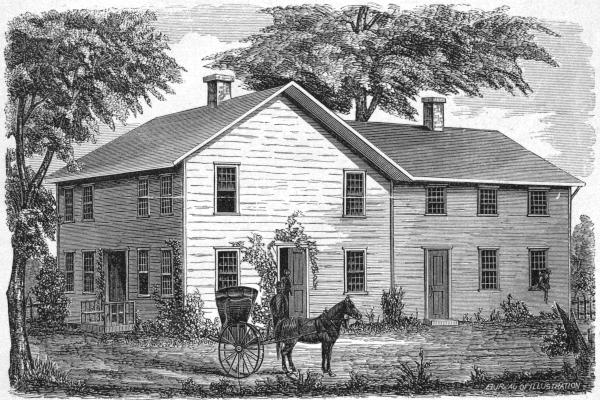
THE OLD HOMESTEAD, DARIEN, GENESEE CO., N. Y.
At the age of ten years I have taken a team, gone alone into the woods and loaded saw-logs on a sleigh, using the horses to draw up the logs. As my father owned a saw-mill as well as a farm, it seemed to him necessary that every effort should be put forth to keep both branches of business going; therefore, no time was allotted to his children for securing an education. Many times have I approached him, timidly and with tears, humbly requesting to be allowed to go to[17] school, when, instead of responding to my desire, he would send me to the saw-mill to work; and at the age of twelve or thirteen I ran the mill alone, though, while doing so, I have had to mount on the lever and load it with extra weight, as I was not heavy enough to raise the water-gate. Thus I labored on from month to month, until I was fourteen, in the meantime going but little to school. Many times I would lay plans to run away, believing that I could do for myself, and make my own mark in the world.
Money, in those times and in that region, was not plentiful, and I was early taught its value, a lesson of great practical value to a youth who has to hew his own path through life. Many times I have traveled miles on a special errand for a neighbor, or for some traveler, and received as compensation a single penny. Money, so hardly acquired, was not to be expended lightly, and I saved my little earnings till the accumulated sum amounted to four dollars. This seemed to me like quite a fortune. I now felt myself to be a capitalist, and, naturally, the desire to use[18] my riches to advantage led me to seek some profitable investment which would increase my wealth. My earliest speculation was the purchase of a gun; but after the first pleasure of its possession had passed, I saw my mistake in having expended money for something that would yield me no increase, and began to look around for an opportunity to retrieve my error. Soon a chance occurred for me to trade the gun off for a cow. I saw there was “money in it,” and closed the bargain, thus turning my first mistake into a profitable investment. Having become the owner of a cow, my ambition was awakened to increase my stock, and I kept my attention fixed in that direction until I was the sole proprietor of three cows. I had now entered on my fifteenth year, and having learned one day, in conversing with my father, that his intention was soon to sell his farm and stock, and remove to the Far West, I proposed to him to allow me to carve my own way in the world. I felt ambitious to strike out for myself, and “paddle my own canoe.” To this my father consented,[19] when, after selling my cows and receiving the money, with all my fortune in my pockets, I bade farewell to the parental roof and its many pleasant associations, looking for the last time upon the
and taking that decisive step by which I was to become the architect of my own fortune.
Having an uncle who resided in the town of Byron, I turned my steps in that direction, and for the ensuing winter found a home beneath his roof. During that season I devoted myself to study, attending the village school under the superintendence of Mr. Bennum, whom I greatly esteemed, and whose many acts of kindness linger in my memory to the present hour.
On the opening of spring my thoughts turned towards commercial life, and I devoted my time to becoming better acquainted with various business avocations, intending to adopt some profitable employment. After reflecting well, I took the money I had accumulated and with it purchased[20] a horse, wagon, and harness. Then, through the kindness of a dear friend, who became responsible for me, I was loaned one hundred dollars, and with this as my working capital I commenced traveling over the country, buying produce and shipping it to Buffalo and New York.
I continued in this business until the year 1855, when, having arrived at the age of twenty, I began to think of enlarging my operations. Influenced by this desire, I directed my course to the beautiful and flourishing town of Batavia, where I secured a store and became a dealer in all kinds of produce, shipping it, as before, to Buffalo and New York.
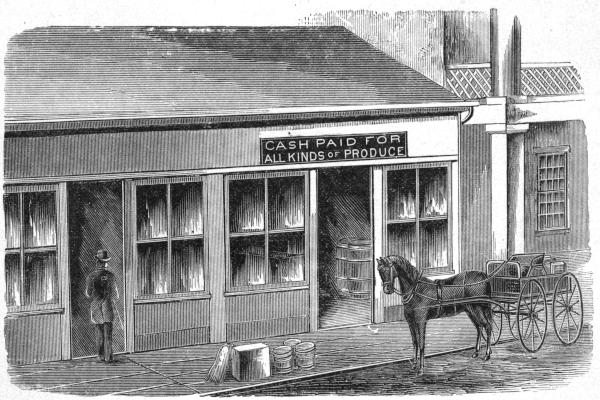
FIRST STORE IN BATAVIA, N. Y.
The cut here given is an accurate representation of my first place of business, and speaks for itself in regard to the size and general appearance of the place. It was, however, as it proved, insufficient for the business which flowed in upon me and increased so greatly that soon I found it necessary to secure larger and more commodious premises. At the time of doing this I determined[23] to still further extend my business by opening a wholesale and retail grocery and provision store. Fortune smiled on my endeavors, and all evidences encouraged the belief that I was on the direct road to wealth.
Having thus attained a good position in business, my mind began to make excursions in another direction. The wisest of men has said that “Whoso findeth a wife findeth a good thing,” and, having a natural liking for “a good thing,” I found my thoughts led to the important subject of marriage, until I finally determined to try the experiment of trading in the matrimonial market. After thus deciding, it took me but a short time to reach the important object contemplated, for, it would seem, I was specially directed in my course. I formed the acquaintance of Miss Northrop, an estimable and accomplished young lady, the only daughter of the late Dr. Northrop, and soon the fair one was led to the hymeneal altar and became the wife and partner of O. S. Pratt.
ENLARGING BUSINESS—ATTACHMENT TO THE HORSE—VISITS TO BATAVIA OF RAREY AND HAMILTON—MY OWN SYSTEM—GOING BEFORE THE PUBLIC—EARLY SUCCESSES.
Having now made myself a home and feeling permanently settled, I desired to still further increase my business, but finding my capital somewhat too limited for the amount I wished to transact, I sought assistance from an esteemed friend, Elandus Dotey, Esq., banker. The aid I sought was given with a cheerfulness that added to its value, and enabled me to carry into execution the plans which I had formed. The accommodations I received frequently amounted to from ten thousand to twenty-five thousand dollars, thus placing ample means in my hands for extended operations and enabling me to do a large and remunerative business in which I continued up to the year eighteen hundred and sixty-seven.
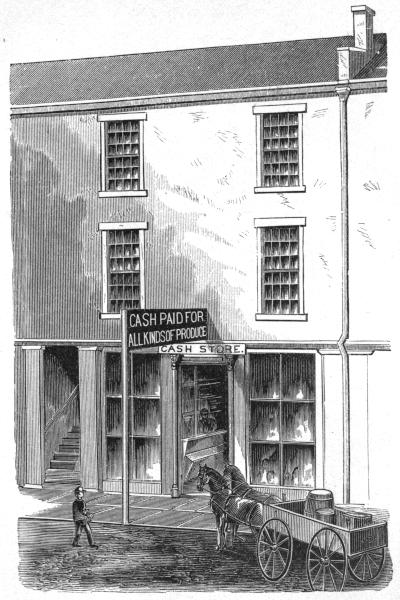
BRICK STORE.
During these business years in Batavia my attachment for that noble animal, the horse, gradually increased, and learning that a horse trainer by the name of Rarey, intended visiting the town, I was one of the first to seek for and obtain what knowledge I could from him; but finding his system to be not at all practical, I applied myself to the investigation of the subject, and began experimenting with a view to the discovery of a better, simpler and more certain system.
Some years later it was rumored that a gentleman named R. P. Hamilton, who was self-announced as “the great renowned horse trainer,” would give instruction on the subject. He soon made his appearance, and, with others, I attended his lectures. Mr. Hamilton advanced some valuable ideas which I gladly adopted and added to my former knowledge, and when I had grasped all that was valuable in his instructions, and united it to the results of my own experiments, I felt assured that, ere long, I should reach the height of my ambition and develop a system of[28] educating the horse far in advance of anything then known, and by which my name would be handed down to coming generations as one who, more than any other, had befriended that noble but greatly abused animal. Often in my retired moments my thoughts would go forward to the time when I should be able to present my perfected system to the public, and as I looked down the vista of time to the period when I should announce my system, my mind pictured to itself the success I since have realized. I was fully conscious of its value to the world, and thousands have since then freely acknowledged the practicability and excellence of my system of educating the horse.
In the autumn of eighteen hundred and sixty-seven I felt myself sufficiently master of my new and unequaled system to commit myself unreservedly to its public advocacy: so, after selling out my stock in trade, I made my preparations to travel for the purpose of bringing it before the world. Previous to leaving Batavia I had purchased from a perambulating horse[29] dealer my favorite horse, “Tom Thumb,” then partly trained.
Feeling now tolerably well equipped, I came before the public with my new and perfect system, confident that it needed only to be known to be welcomed with pleasure by every intelligent friend of the horse. In the month of January, eighteen hundred and sixty-eight, I made my debut at the town of Geneva, erecting, at considerable cost, an academy for the exhibition of my system of training. My success was immediate; friends and well-wishers clustered about me; the hand of encouragement was extended on every side, and in a little while my class in that place numbered seventy-five members. The reader can scarcely conceive the feelings of gratification that were excited in my breast by such prompt and flattering success. It confirmed my own judgment of the superiority of my system, and inspired a full confidence in its success.
After leaving Geneva, I visited the pleasant town of Waterloo, where I built another academy[30] and formed a class of about eighty members, whose hearty appreciation of the ideas embodied in my system of training afforded me great pleasure.
Leaving that place, I next proceeded to the beautiful village of Penn Yan, where also I built an academy and met with brilliant success, my class numbering over ninety members.
Such gratifying success, and at so early a period, was very encouraging to me. Both myself and my system were new to the public, and, coming before them almost unheralded and without the prestige of great names to give it support, its progress and the general approval it met, could be attributed only to its own merits, which were everywhere conceded.
The next point visited by me was the beautiful and highly picturesque village called Watkins, so well and widely known to pleasure-seekers as an attractive summer resort; its famous “Glen” having an almost national reputation for romantic beauty. Here I formed an interesting class of about sixty persons, many of whom gave unmistakable[31] evidences of confidence in the superiority of my rapidly spreading system for rightly educating the horse.
Cheered by my continued success, I pursued my journey to the city of Ithaca, where I built an academy much larger than any I had previously erected. Here I remained about a week, and had the pleasure of forming a class of one hundred persons.
Finding it somewhat inconvenient to build academies in many places, I now purchased canvas for a movable tent, which I had constructed, and this I carried from place to place, erecting academies only where my tent was insufficient to accommodate the audiences. On the fourth of July I pitched my tent at the city of Elmira, and soon had the satisfaction of enrolling the names of one hundred and fifty persons, who eagerly sought information, and expressed the greatest gratification with the instruction they had received.
After this, I continued my tour, exhibiting and lecturing in many towns and villages during[32] that summer and the autumn following. My success was everywhere of the most gratifying character, and exceeded my most sanguine expectations.
In bringing my system to the attention of the public, I employed that great engine of power, the Press to call attention alike to the cruelty of most of the previous modes of training the horse, and the superiority of my new and rational system. As an illustration of this, it may not be out of place to give a single one of my many addresses to the public through the medium of the press:
Professor O. S. Pratt to the Public.—Probably not one person in a thousand has any adequate idea of the wonderful intelligence displayed by the noblest of the brute creation, the horse. Patient, affectionate, sensitive and faithful, possessing wonderful powers of endurance and a capacity for education far exceeding any animal extant, a study of his characteristics is ennobling, and commands the attention of every intelligent person. But how often do we see him abused, through ignorance, compelled to draw tremendous loads for hours on a stretch, whipped, clubbed, and cursed, until patience ceasing to be a virtue, and through sheer exhaustion, panting, trembling, and discouraged,[33] he stops to breathe, and men call him balky, apply the whip again, put sand in his ears, gravel in his mouth, twist his tail, and goad him to desperation by a system of barbarous inflictions unworthy of even the first stages of civilization. Trotting over slippery pavements, imperfectly shod, twitched to the right or left as a sudden emergency seems to demand, he stumbles and falls. No compassion is excited by this mishap. Hastily assisted to arise, and reharnessed, crack goes the whip. O, lash him, cut him, until the great ridges of swollen flesh stand out upon his back to testify to man’s superiority over the brute. Left standing for hours while the master attends to business or pleasure, impatient to change his position, he starts before the man is comfortably seated in the vehicle; crack again goes the whip, until his nerves are strung to their highest tension.
Crazed almost beyond endurance, he leaps forward, suddenly a bolt gives way, something strikes his heels, he becomes frightened, and then, “O! he’s a runaway!” Confined in a dungeon, poorly ventilated, called a stable, improperly fed, driven fast, compelled to draw heavy loads, with very little attention paid to his requirements, it is a wonder that he lives even a year. The question naturally arises, Why is this? Simply because the great masses of humanity are ignorant of the disposition of the horse. They do not understand how to manage or educate him. They do not think and therefore do not care. Now any one who succeeds in ameliorating the condition of this noble animal, is a public benefactor, deserving of the highest praise. Prof. O. S. Pratt has made this the study of his life. Slowly,[34] but steadily, he has progressed in his investigations respecting the management of the horse, until the press, the pulpit and the public acknowledge him to be the “Great Horse Educator of the World.” In fact he rules the horse by a system so comprehensive, and at the same time so simple, that a child of ordinary intelligence can understand it. His pupils are numbered by the thousand in almost every State, and they all endorse the system heartily. No matter how badly the horse has been abused, no matter how disagreeable his disposition may be, no matter if he kicks, strikes, bites, or is a runaway, in a few minutes the most delicate lady or timid child can manage him with ease by using Prof. Pratt’s system. Ladies and gentlemen throughout the land! nearly every one has had a friend or relative injured or killed by some unmanageable horse. It is within the power of every person to prevent a like occurrence. “Knowledge is power.” Do not neglect the opportunity of acquiring this knowledge. We ask it in no selfish spirit. We urge it that a recurrence of the accidents that are every day filling our land with sorrow may be prevented.
VISIT TO MONTROSE—LARGE CLASS AT SCRANTON—DIPLOMA—WILKESBARRE—ENTHUSIASTIC RECEPTION—COMPLIMENTARY NOTICE—TESTIMONIAL.
As the winter had now set in I found it necessary, on reaching the beautiful town of Montrose, to lay aside my tent. At this place I received so enthusiastic a reception that I was induced to erect a large academy, of capacity sufficient to contain at least one thousand persons. I remained at Montrose about three weeks, my efforts meeting with such appreciation that my class numbered five hundred and two persons, amongst whom were many who became my warm friends, and whose cordial greetings and good wishes attended me on my departure from the town.
My course next led me to the flourishing city of Scranton, at which place I received a cordial reception, and formed the acquaintance of many noble-hearted men. I at once entered on the[36] duties of my profession, and early found that my system was appreciated, the class which I here gathered numbering four hundred and four members. On the last day of my stay in Scranton my class presented me with what I may justly call a diploma, in the following complimentary language:
The undersigned, citizens of Scranton, Luzerne County, Pa., take this method of assuring all whom it may concern of the practicability, as well as the certainty, with which the most vicious and dangerous habits so common to the horse can be overcome by Prof. O. S. Pratt’s system of training, in evidence of which we cite but one or two of the numerous cases which have come under our observation as members of his class: A kicking horse, owned by Jos. Utley, of Greenfield, and brought twenty-two miles, was handled about twenty-five minutes, after which he was driven from the arena with the vehicle rattling behind his heels. This horse would bite, strike and kick. A vicious mule, that could not be shod, and had to be brought to him by force, being chained between two other mules, after being handled by the Professor about forty minutes, was perfectly subdued, and his feet could be handled with safety. On the last day of his exhibition here, a horse ran away near the amphitheatre, who proved to be a most ferocious kicker. The owner was induced by a number of his class to let the Professor handle him, and after twenty minutes’ training he was driven[37] out of the tent, the whole length of the street, with the cart rattling against his heels, without manifesting the slightest disposition to repeat his unruly conduct.
These, and numerous other evidences, we think, are sufficient to entitle Prof. Pratt to the encouragement and patronage of all interested in the management of the horse.
This testimonial was followed by the names of seventy-six prominent members of the class, headed by the mayor of the city, Hon. E. S. M. Hill, and embracing many of the leading citizens of Scranton.
After leaving that thriving city, I passed over a beautiful country for a distance of twenty-five miles, until I reached the town of Wilkesbarre, situated in the Susquehanna Valley. Through this city flows one of the most beautiful of all the charming rivers which adorn our land. The pencil of the artist and the pen of the tourist have often been employed in sketching its picturesque charms and extolling its matchless beauty. At this important town my success surpassed any previously attained. The exhibitions of my power over the horse, and of my simple[38] yet certain method of instructing and controlling him created wide-spread interest and excitement. Ministers, doctors and lawyers, together with others of the most respectable classes of society, thronged my academy. The press resounded with the praises of my system, and with many who learned my plan of educating the horse the interest rose to enthusiasm. A leading paper of the place, referring to my consenting to prolong my visit, used the following language:
Prof. Pratt announces that he will remain in this place two weeks longer, agreeably to the wishes of the very large class which he has formed here. The Professor’s success in this county has been of a most gratifying character, and yet not more than has been fully deserved. In Waverly his class numbered one hundred and twenty-nine in five days; Scranton furnished a class of four hundred and one in thirteen days, and Wilkesbarre, thus far, has given him three hundred and twenty-three seekers after information in relation to the horse and his management. The Professor is a perfect adept in the art which he assumes to teach.
As that article announced, in view of the popular interest, I prolonged my stay in Wilkesbarre,[39] and I have the pleasant recollection that over FIVE HUNDRED persons there secured the knowledge of properly educating the horse, and before taking my leave I was presented with a diploma that would have cheered the heart of a statesman. The following, from A. Ricketts, Esq., will show how even incredulity was convinced, and strongly-rooted prejudices were overcome:
Wilkesbarre, Pa., April 23, 1869.
Dear Sir: Permit me to introduce Prof. O. S. Pratt, teacher of doubtless the best system of horse-training yet discovered, and to add my unqualified recommendation of the same to any of you that may care to know how to be master of the horse. When Prof. Pratt first came here, I, in common with others, passed and repassed his amphitheatre daily, thinking no more of it than that it was something pertaining to horse-jockeyship, and therefore did not think it worth while to turn aside to see the “free exhibition” he advertised; but one day the representations of a friend induced me to purchase a ticket for his instructions. I was at once so impressed with the utility of the system that I advised all my friends to become members of his class. The satisfaction expressed by all gave me full reason to be glad that I had adopted this course, which, by the way, was adopted on the principle of doing to others as I would[40] they should do to me. I thought I had found a good thing, and wished others to share it. It is upon the same principle that I write this letter, for I know of nothing so well calculated to prevent cruelty to this excellent animal, the horse, as the general diffusion of the knowledge of his proper management. The simplicity and practicability of Prof. Pratt’s system are among its chief recommendations, being such that any ordinary man of common-sense can practice it as well as the Professor, and without costly appliances. Our best and leading men here became members of his class, and I have heard but one opinion, and that of approbation.
You will find Prof. Pratt courteous and gentlemanly, and, should you become a member of his class, I doubt not you will agree with me that the trifling cost of his tickets is a very small consideration for the benefits received.
Very respectfully,
A. Ricketts
ACROSS THE MOUNTAINS—EASTON—HAMBURG—LANCASTER—TESTIMONIALS—WESTCHESTER—DIPLOMA—PHILADELPHIA—CLASS OF 2,523—CANE.
It was now my purpose to pursue my journey eastward, in order to do which it was necessary for me to cross a wild and mountainous tract of country, fifty miles in extent; but, inspirited by my success and the good fortune which hitherto had attended my way, I entered on the journey with a stout and hopeful heart, attended by my men and horses. Before traveling many miles we reached the foot of Pokeno Mountain, and as I gazed upon the distant heights which stood out against the sky, I could see that the elevation extended a distance of at least ten miles. Up the rough road and along steep acclivities we pressed on until, when the summit was reached, I found a keen appetite had been awakened by the mountain air and exercise, and I sought for some abode of man where we might[42] secure rest and food for man and beast. Keeping up the search, after a few miles, I discovered a rude old log house, quite in keeping with the wild region through which we were passing. Approaching the door, I knocked for admission, when it was opened by an old veteran of seventy winters, who invited us to enter. After making known my wants, he assured me that they should be supplied as best he could, and at once he summoned the hostess who, though like himself, advanced in years, moved across the rustic floor with almost youthful agility, manifesting a disposition to relieve our hunger without delay. We partook of the repast she spread with appetites quickened by the pure mountain air, and, when the meal was over, after rewarding them for the hospitality they had displayed, we resumed our journey through dreary solitudes and along the rough mountain roads until, at length, we reached the city of Easton, in the State of Pennsylvania.
This beautiful little city is situated near the Delaware River, and is an enterprising and[43] flourishing place. The inhabitants are chiefly Germans, or descendants from that stock. Here we pitched our tent and met with good success, my class numbering over one hundred persons.
From Easton we continued our journey, through valleys and over hills, reaching Harrisburg, the capital of Pennsylvania, quite late in the evening; the silver moon shedding her light upon us as we moved along, made our journey pleasant and lighted our way to the city. Here again we planted our stakes, pitched our tent and announced our intention of giving a public exhibition and of imparting instruction to those who desired, and once more I met with a hearty response from the public. It was at the time of the annual State Fair, and thousands from all parts of the commonwealth had gathered. Taking advantage of the occasion to display the results of my system of training, I built a platform, elevated about ten feet above the ground, led my horses up a rude stairs, made for the occasion, and exhibited my trained animals to the gaze and admiration of thousands of wondering[44] spectators. Here I formed a class of over one hundred and fifty.
My next effort was made at Lancaster, a city of no small magnitude or interest, as I there formed a class of nearly two hundred, the major portion of whom were Germans, or of German descent. On the last day of my stay in that city I received a testimonial from a leading banker of the place, which I give below:
Lancaster, Pa., October 16, 1869.
Prof. O. S. Pratt:
Dear Sir: I take pleasure in testifying to the success of your system of controlling vicious horses as applied to my colt. Since you handled and drove him without backing-strap, I have driven him twice without his showing the least fear or disposition to return to his dangerous habit of kicking.
I believe you have perfectly taught him to work without kicking, and that he will not forget the impression your treatment made on him. Your system is so easily learned and can be so quickly applied, that it is the owner’s fault if his balky, runaway, or kicking horse, ever forgets what you, or any member of your class can teach him in half an hour.
Every one who owns or drives a horse ought to join your class.
Yours,
B. J. McGraun,
President First National Bank.
I next stopped at a nice country town called Westchester, the inhabitants of which seemed alive to the great cause I had espoused, as my class there numbered two hundred and fifty. I was happily surprised, just before leaving, by receiving a diploma which greatly cheered, at the same time that it stimulated, me to add more and more to my store of knowledge.
Having now had two years’ experience in the practice of my system, my confidence in it, and its superiority over any other known system, was so thoroughly established that I had no fear of submitting it to any test nor of subjecting it to any criticism. I, therefore, decided upon visiting the great city of Philadelphia. I fortified myself as best I could, and on the 28th of November, 1869, I made my debut there. Whatever solicitude I might have felt would have been speedily removed by the cordial and flattering reception I received from the people of the Quaker City. One academy being insufficient to accommodate those who flocked to listen to my instructions, I built a second, and as the[46] time rolled on and my success constantly enlarged, I felt as if the summit of my ambition had been almost attained. The limit of time I had fixed for remaining was one month, but as the end of that period drew near I was strongly solicited by many friends to extend my visit, to which, as the interest was daily augmenting, I consented. Month after month passed, during which time my class was constantly increasing until, by the close of the fourth month, it had swelled to the number of four thousand eight hundred and eighty-six members! At the end of that time my preparations were made to depart, but I was not allowed to leave before receiving the most conclusive and gratifying evidence of the high estimation which my system had secured and of the friendship I had been so fortunate as to win.
The evening of the 21st of February, 1870, had arrived; a free exhibition of the power and beauty of my system was in progress in the great tent, when, most unexpectedly to myself, Elmer Ruan Coates, Esq., a well-known citizen and[47] poet of Philadelphia, entered the ring. This seeming intrusion on the business of the evening somewhat surprised me, while, as I turned towards him, every eye in the vast assembly was fixed on the well-known poet who, cane in hand, advanced towards me. A brief moment of suspense ensued, during which the question which ran through every mind was “what does it mean?” Then, amidst the profound silence which prevailed, Mr. Coates held up to view the magnificent, gold-headed cane he carried and, in an eloquent address, presented the elaborately-chased and beautiful testimonial as a memento given by my Philadelphia class.
The gratification which I experienced in this unexpected compliment may be conceived by my readers but can scarcely be described by my pen.
Mr. Coates began his address by saying that
All nations, in all ages, have delighted to honor the meritorious. The analytic mind of Greece was promoted to the Academy and Groves of that classic land while bright[48] intellects gave their homage as they gathered the gems of thought and poesy which enriched their varied lore.
The school-boy-quoted Roman, if a victor, passed under the triumphal arch, bowing to popular plaudits. If a poet, he was laureated; if philosophic, oratoric, or mechanical, he had his meed of honor from proper sources. Even the Tartars were grateful, and Tamerlane, the great Usbeck, was elevated in proportion to merit.
The American Indian who exhibits military strategy, is chosen chief pro merito, and leads the painted warriors. The highly-cultured United States never forgets the truly great. Here the statesmen, poet, orator, lawyer, divine, artist, man of science or mechanism, is both courted and remunerated. Our worthy dead live in hearts, monuments, statues, statuettes, and oil. The living, acting man of the day is recipient of both newspaper glory and material recognition.
Taking me by the hand, he continued:
My friend, a full consideration of gratitude has timely and most heartily determined your large class to offer this El-Dorado-headed cane. Sir, we recognize you as the greatest equestrian educator in the world. Your humble servant is proud of his recent acquisition. You have enabled the palsied old man to ride in safety; you allow the old lady to drive minus the fear of a broken neck; the young lady or horse-loving master can now indulge saddle pleasures, knowing the animal thoroughly subdued by some member of your class.
Every vicious trait a horse can possess is thoroughly cured by your unequaled skill. You are a practicalist, a utilitarian, an educator in one of the most necessary and recreative branches of polite culture. Indeed, a logical lawyer could raise a fine issue relative to the comparative merits of your skill and that of the statesman. Disparaging no sphere, I would say that the live, practical, successful man in any avocation, is the person we need and the individual we will honor.
Your grateful class, at this date numbering two thousand five hundred and twenty-three, are of my sentiments, and now delegate me to tender this beautiful present—not as a quid pro quo, but merely as a memento. My dear sir, I trust it will be very long ere you require this as a physical staff, but when that period does come, may it equally subserve the mental and heart-man and aid in happy retrospect of Philadelphia, Philadelphians, and your admiring class, a class that mainly hails you as both a high-toned, social gentleman and the horse educator of the age.
As Mr. Coates closed his address the great tent resounded with applause. It was an hour and a scene never to be forgotten by me. But as the applause subsided every eye turned to me for the expected response. I had received the cane from the hands of the gentleman who had so fittingly and eloquently presented it, but,[50] as I bowed in acknowledgement, my heart was too full for many words. The papers of the following day, in describing the event, spoke of my voice as having been “somewhat tremulous with emotion,” and it may well have been so, all I could say was to express the surprise and gratitude I felt as follows: “What! gentleman, can it be that, after your many kind attentions, I am to receive a further testimonial of your regard, and another reminder of pleasant times passed with you—times that certainly I never can forget. Words cannot express my feelings on this occasion, therefore I sincerely return you thanks.”
Again the great tent rang with thunders of demonstration, and the affair, so gratifying to all, terminated amidst feelings so warm and kind that in one heart, at least, they were almost overpowering. The cane bears the following inscription: “A tribute to merit. To Professor O. S. Pratt, from his Philadelphia class, numbering 2,523.”
The cut, which follows, will give but a partial idea of the beauty of this testimonial, which I[51] prize as much as being expressive of the friendship I was so happy as to secure, as I value it as a testimony to the superiority of my system. It will be seen that it is accompanied by a card, signed by leading members of my class, urging me to revisit Philadelphia and pledging their aid and influence in making such a visit successful.
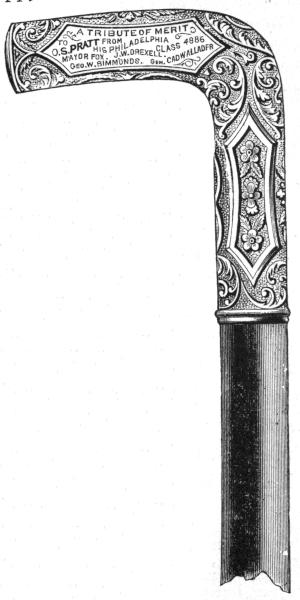
A TRIBUTE OF MERIT TO O.S. PRATT FROM HIS PHILADELPHIA CLASS 4886
MAYOR FOX, J.W. DREXELL, GEO. W. SIMMONDS, GEN. CADWALLADER.
Prof. O. S. Pratt, the Horse Educator:
Dear Sir: The undersigned, members of your horse educating school, have learned with deep regret that you are forced, by various engagements, to leave Philadelphia in a few days. The knowledge we have received by your lucid and simple system of educating the horse is invaluable to us and all who have been pupils in your class. We think that your system of educating the horse is far superior to any known before. It prevents cruelty to animals, and is effective in all cases if rightly applied and persisted in. Your system is as yet far too little known in Philadelphia. We, therefore, request you to open your[52] school in Philadelphia again during the fall and winter months, and we do assure you that we will do our utmost to make your school a successful one.
By urging you to revisit Philadelphia, we express the wishes of a great number of our fellow-citizens who are anxious to become members of your class.
Other testimonials I received from individuals, a single one of which is given below; it is from a well-known gentleman of wealth whose name is as familiar in business as it is in social circles, W. F. Potts, Esq., and was addressed to friends of his own:
Philadelphia, Sept. 14, 1870.
Messrs. Morley & White,
Gent’n: My coachman and myself attended Mr. Pratt’s lectures, last winter, in this city, and I think it paid me well.[53] I bought a young horse this spring, as bad a kicker as I ever saw, and by putting him through a course of Pratting I am using him every day. I do not know what some persons could do, but I know what I have done; it is well worth all I paid.
Yours, etc.,
Wm. F. Potts.
I was greatly pleased with the ancient Quaker City as well as its noble-hearted people. The neatness and quiet pervading so large and populous a city produce a pleasing effect on the visitor from abroad. The beautiful parks, with their grand old trees and delightful walks, which are to be met in all quarters, form a very pleasing feature in that city. The bright flowers, filling the air with fragrance; the leafy branches arching over the nicely-arranged walks, with the merry songs of the birds which sport amidst the foliage, combine to invite the tired pedestrian to rest his weary feet, as they charm the eye, the ear and sense alike.
To the patriot and the lover of relics of “the times that tried men’s souls,” when amidst the battle-storm our fathers planted the fair tree of[54] liberty, Philadelphia offers special attractions, and hours may be pleasantly and profitably spent in the well-known “Independence Hall.” Here time seems almost turned back on its track as one stands amidst the relics of those days of old. We see the very chair once occupied by him whom we have learned to revere as “the Father of his country”—the illustrious Washington, and the thoughts are borne backward to the time when, seated in the chair before us, his hand held the destinies of a nation in its grasp. Near by we see the pew in which that great man sat and listened to that gospel whose power and principles controlled his life. It is taken from the old Gothic church which the General attended and is preserved amongst the relics of those revolutionary times. Mementos are there also of the period when the Declaration of Independence was signed and the eye rests on the autographs of the illustrious signers. There is also the great bell which rang out the glorious notes of freedom and on which is inscribed that grandest of words, “Liberty.” After[55] having became cracked, it was taken down from its tower and placed on a table in the hall. The National motto, “E Pluribus Unum,” is arranged in a circle at the top of the bell. But pleasant as it is to linger amongst these reminiscences of the past, I must leave the good old Quaker City with the single remark that my recollections of the place and its people are all of the most pleasant kind.
Early in the spring of 1870, I entered the city of York. The roads were bad, making traveling, outside of the city, difficult and unpleasant, so that few came in from the surrounding country. Notwithstanding this, I met with encouraging success, and during the three days of my stay I formed a class of one hundred and thirty members. Amongst my pupils was an old man who had numbered a hundred and five years of life. After studying my system he declared that, during the short period of my stay, he had received more valuable instruction relating to horse education than in all his previous life.
I next pitched my tent in the beautiful village, Port Deposit, and was gratified by receiving a good “deposit” from the hands of the people,[57] as nearly one hundred of them joined my class. It was at this place that I achieved a victory which spread my name far and wide. A horse, notoriously vicious, was brought for me to educate. He was an animal who, as I was credibly informed, had killed his former owner, eaten the leg nearly off his son and fearfully mangled the arm of the groom. I applied my system in all its force, knowing that he would require decided treatment to subdue him, and, to the amazement of the spectators, in a little while the ferocious steed became gentle as a lamb. He stood in the presence of that gazing multitude entirely subdued. When the excitement had somewhat subsided, some of the leading and influential citizens were so impressed with the value of my system as to exert themselves in getting up a testimonial which, after being numerously signed, was presented to me, and which I have since had the pleasure of exhibiting to thousands. The following description of the horse referred to and of the success with which I trained him may prove interesting to the reader:
Port Deposit, Md., August 31, 1870.
We, the undersigned, residents of this place and vicinity, were induced to enter Prof. Pratt’s class for instructions in educating the horse. At first many of us doubted the superiority of his system, especially from the low price he charges for instructions, believing it impossible to learn so much in a short space of time for so little money; suffice it to say, we went in and all were more than satisfied. Illustrative of which we give a brief description of the “Biting Horse,” owned by Mr. Snyder, near this town. This horse is a brown stallion, 15½ hands high, closely built, and an animal of great endurance, for which he is highly valued by Mr. Snyder, who purchased him of a farmer in New Jersey for a very low price on account of his most pernicious habit of biting, the horse having bitten out two ribs of the farmer and broken the leg of the son. Whilst in possession of his present owner he has bitten off the arm of his groom, who brought him into the Professor’s pavilion. We saw and conversed with this groom. The horse had on a strong iron muzzle, a pine stick was inserted in the mouth, which he seized with madness; upon its removal he gritted his teeth most fiercely. In twenty minutes or less, Prof. Pratt had the muzzle off, his hand in the horse’s mouth pulling out the tongue. In a few minutes after he drove the same horse in the street without holdbacks. When he said “whoa,” the horse stopped. When he said “go,” the horse went. Thus proving to two hundred that his system is no fraud, but of all others “excelsior.”
The scholars in this place numbered in three days 87, among whom were the following named gentlemen:
W. E. England, pastor M. E. Church, Port Deposit, Md.; J. B. Ramsay, cashier Cecil National Bank; Edward West; N. W. Nolan; Eli Cosgrove, ex-sheriff Cecil County; F. M. Alexander; Wilbur Kidd; Thomas D. Foran; Anthony S. Davis; J. Tome, president Cecil National Bank; Wm. M. Long; Thos. E. Davis, etc.
Baltimore, the Monumental City, noted for its beautiful parks, pleasure grounds and monuments, was my next field of labor. After viewing the city over and receiving introductions to many of its influential citizens numbers of whom afterwards became warm friends, I betook myself to labor.
As on some former occasions, I found it necessary to build two academies, and so erected one in the old and one in the new town. At first there seemed a backwardness on the part of the people, and a week passed without the manifestation of much interest; but soon the indifference gave way and from that point the interest increased daily until, before the close of the seventy days I remained in Baltimore, I had the[60] great pleasure of enrolling the names of three thousand five hundred of her citizens as members of my class.
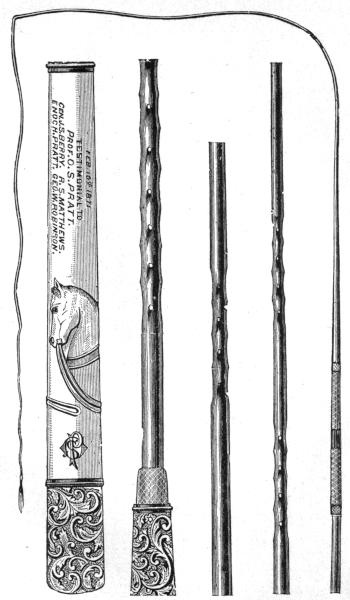
WHIP PRESENTED BY BALTIMORE CLASS.
My stay in Baltimore was especially marked by kindnesses from numerous members of my large class, many of whom it would give me pleasure to name, associated as numbers of them are with pleasant seasons of enjoyment, but lest I should become prolix, I will content myself with saying that most unexpectedly to me my class presented me with a flattering address accompanied by an elegant whip mounted with gold and inlaid with pearl—a gift both beautiful and useful. How it occurred is described by the pen of another as follows:
How Professor Pratt was Whipped by the Baltimoreans.—The Amphitheatre of Prof. Pratt, the Horse Educator, at the corner of Green and Pratt streets, was crowded on Thursday night, by an appreciative audience, to witness the education of a number of horses. Near the close of the free exhibition, an interruption occurred by a Mr. Murdock, introducing F. P. Stevens, Esq., a member of the Baltimore Bar, who made the following eloquent and pithy speech, in presenting an elaborate whip to Prof. Pratt: “On behalf of[63] the members of your class in this city, numbering over 3,000, I have been requested to present to you, on parting with us, some memento of our high regard for you personally, and of our estimation of your most admirable system of Horse Education. That the instructions you have imparted to us have been valuable and useful, no one of us who own horses would hesitate to testify, not only your instructions as to the Management, Education and Treatment of the Horse, but in developing to us in the numerous Lectures, the disposition and nature of the noble animal; that your course of instruction has been popular among us, the numerical strength of the class announces you, and I take great pleasure in presenting you this token of friendship and good will and hope that you may ever recur with pleasure to your visit to the Monumental City, and as soon as your engagement will permit, we may have the pleasure of seeing you again.”
Committee.
Class numbers 3,504.
During the continuance of my classes in Baltimore, I received many favorable notices from the press of that city. As showing the popular feeling[64] I may be allowed to give an article from the Baltimore Sun, one of the most able and widely circulated journals of the entire South. It appeared, as will be seen, before my class had reached its full dimensions.
Horse Training at Prof. Pratt’s Amphitheatre.—The exhibitions of Professor Pratt’s skill in training refractory horses continues to interest a large number of the people of Baltimore. Every night his Amphitheatre on Linden avenue is filled with an appreciative audience, including a large number who are members of his school. During one of our recent visits the Professor, after some remarks in reference to his systems, introduced the little educated pony called “Dollie Dutton,” well up in a few tricks. On her exit “Fire Fly,” mate of the Professor’s “Tom Thumb,” made his appearance, at the crack of a whip. “Fire Fly,” made excellent time with his heels in the air, and by the word, walked on his hind legs. The attempt by three persons to ride the horse the longest afforded much amusement to the audience, as not one of the three could remain on a minute. “Gray Eagle, Jr.,” Marshall Goldsborough’s thorough-bred stallion, which had not received over ten minutes’ instruction, acted in a manner which gave credit to the Professor and his system. Prof. Pratt then exhibited a massive gold-headed cane, richly mounted and appropriately engraved, which was presented him on the night of February 22d, 1869, in Philadelphia, by his class which numbered 4,886, among[65] whom were Mayor Fox, General George Cadwalder, J. W. Drexel, banker, who were on the committee of presentation, and who gave the testimonial as a token of the appreciation of his efforts with the horse and a proof of the value of the system to them. After a lecture explanatory of his plan of education which lasted nearly an hour, the Professor ordered a horse to be brought in which was afraid of a robe. In less than fifteen minutes after he came in, he was walking over the robe, had it thrown over his head and in his face, but the scare was gone. His education in robes being pronounced completed, he was taken away and a horse that would not back brought in. He however, soon proved very tractable, backing while in and out of harness at the words. The next Animal to claim the Professor’s attention was a large stiff-neck mule furnished by Mr. S. S. Blair, of the Northern Central Railway. As was expected the mule was far more difficult to handle, yet in less than three minutes after he was subjected to proper treatment and followed the Professor, and after the system was entirely applied he was mounted and ridden off by an attendant, going quietly as any one could desire. Thus closed an evening at Professor Pratt’s. On conversing with this worthy gentleman, we learn he is from Buffalo, N. Y. Has been giving the system to the public five years. He probably handled more horses than any other man living. Was in Philadelphia five months, having there a class of 4,886. In less than three weeks’ sojourn among us he has secured over 1,000 members to his class, and we saw such men as M. B. Clarke, Henry Tyson, Drs. McNamus and Whitridge, George Robinson, George Small, Gen. W. E. Ross, J. Riddlemoser, Jr., Gen. J. S. Berry,[66] J. Howard McHenry, R. Stockhart Mathews, all of whom highly endorse Prof. Pratt’s system of educating the horse. Mr. Mathews, who has seen Rarey, Rockwell, and others, says this is far superior to all of them.
After closing my labors in Baltimore, I took a few days of rest. My mind was in search of new knowledge to add to and improve my system, and to that object I devoted my time while relieved of more active duties. I thoroughly revised my system of educating and mode of treating the horse; after which I invited the criticisms of a number of men of intellect and experience, to whom I submitted my views and asked them for their candid verdict, when, to my great satisfaction, they expressed their unqualified approbation. If anything had been needed to confirm my opinion of the perfection of my now completed system, such an endorsement might justly have done so; and, as the succeeding chapters will show, my triumphant successes in the largest cities and before the most exalted personages of the land, demonstrated the justice of that favorable verdict.
WASHINGTON—A LARGE CLASS—THE PRESIDENT A PUPIL—THE WHITE HOUSE—HALLS OF CONGRESS—DIPLOMA—DR. NEWMAN’S ADDRESS—GOLD MEDAL.
In the latter part of the year 1871 I determined to visit the capital of the nation—that renowned emporium of knowledge and wisdom—the city of Washington. Fortified by previous success, I determined on such an effort here as should signalize my profession, and effectually silence those who sought to stigmatize my system and lessen confidence in myself by speaking lightly of both. Themselves pretenders to knowledge, and ignorant of what I taught, I have found them ever ready to insinuate that all is “humbug” which does not emanate from their would-be fruitful brains. And now I ask a careful attention to the narrative of my unexampled success while sojourning in this city, in connection with the character and intelligence of the[68] gentlemen who united in endorsing me, and in commending my system.
I entered Washington about the middle of February and speedily secured a site on which to erect an academy. The place selected was on Pennsylvania avenue, and the building I erected was of capacity sufficient to contain three thousand persons. I announced a public exhibition, and on this, the first day of opening, the place was filled to the utmost. At the close of the exhibition I invited those of the audience so disposed, to unite in forming a class. A large number responded to this call, and, as I entered on my work, I was encouraged by finding the numbers increasing by hundreds. This nerved me to the utmost, and at length, in sixty days, my class had reached the gratifying number of two thousand five hundred and five persons!
President Grant intimated his desire to take private lessons, and requested me to organize a class to meet in the forenoon of each day. This I did, and I soon had the honor of imparting instruction to such a class of distinguished men as[69] have rarely, if ever beside, been gathered together for a similar purpose. The President invited some special friends to join him in acquiring the knowledge he desired, and soon I numbered in my class men distinguished in the pursuits of arms, politics, literature, and theology, many of whom would rank with the foremost men of the world. Amongst them were President Grant, General Sherman, Surgeon General Barnes, General Fremont, General Porter, General Babcock, General Mechler, Judge Advocate General Holt (the highest position in the army), General Eli Parker, Count Catacazy, the Russian Minister; Count Turenne, of the French Legation; P. H. Le Poor, French Legation; H. S. Le Strange, of the British Legation: Commodore Ammen, Commodore Pickering, Senator McDonald, Senator Stockton, Hon. W. H. Hooper, Rev. Dr. Newman, Chaplain to the Senate; Senator Sprague, Governor Cooke, and many others of high rank and standing.
As is well known, in the national capital may be found learned and talented men from almost[70] every nation, and as there are gathered objects of interest to all, a brief sketch of what met my eyes may not prove out of place.
First of all is the renowned “White House,” the home of the honored head of our nation, and now occupied by President Grant and his family. It has been said that
and a similar declaration might be made of the occupant of the Presidential chair; few have found it to be an easy seat. The servants of a public jealous of their rights and privileges, and exposed to the adverse criticism of selfish and disappointed opponents, even the most generous and well-meant movements of those filling that high position are liable to misconception and ridicule. There may be no personal dislike, yet the public, ever on the qui vive for news of those in high life, are seldom disposed to scrutinize a spicy story, whoever it may strike. In this land every man who deserves them has his friends, and none, however deserving, are without some enemies.
The external appearance of the “White House” somewhat disappointed me; yet it is a magnificent structure, with massive pillars in front, while the interior does credit to the good taste of those in charge.
The Red Room, being generally selected for the receptions held by the President and his wife, is very handsomely furnished in velvet and drapery, the color of which corresponds with the name of the room. I must, however, express my preference for the Blue Room; its light shade of satin damask, with gold, is so chaste and elegant that one could scarcely dream of a fairy-land more beautiful; and at “morning receptions,” from two till five P. M., the guests being received in this room, it is rendered doubly beautiful by the elegant toilettes of our American and foreign ladies, who crowd it with the beauty and fashion of the metropolis.
The large East Room, which occupies that entire end of the building, is elegantly furnished, while the walls are hung with life-size portraits, in oil, of Washington, Abraham Lincoln, and[72] others who have formerly filled the highest national office, but who now have passed away.
It was my pleasure to pass an evening, with my wife, in the private parlor of President Grant and family, who gave me a cordial reception. Among those who shared in this social interview were Rev. Dr. ——, L.L. D., from England, his wife and daughter, and our much-esteemed friends, Rev. Dr. N—— and wife, of the Metropolitan Church, D. C.
We were shown through some of the pleasant apartments of the Presidential mansion, and, among others, the private dining-room. In this the arrangements for meals are perfect and tasteful. A small bouquet of choice flowers, selected from the conservatory, which abounds with rare exotics, is placed at the side of every plate at dinner, and, that no interruption may interfere with the arrangement of the table, a plate is always provided for a casual visitor.
On entering Washington, the first building to attract the eye of a stranger is the Capitol, which is built on a prominent height, and forms the[73] most conspicuous object as one enters the city; especially is this so when the magnificent dome is lighted; one then gazes with delight on the beauty of its perfect architecture.
On entering the Capitol by its massive marble portico, the visitor first views the reception rooms, then passes to the rotunda, the walls of which are adorned with paintings, many of which are commemorative of important events in the early history of America, and some of a later date. Statuary also meets the eye, and prominent amongst it is the life-size statue of the martyred President, Abraham Lincoln, from the chisel of Vinnie Ream. As one looks on this work, which has been so severely criticised, he will feel the injustice done her, and be likely, with the writer, to believe that the attacks were prompted by the fact that it was a lady who secured the contract. I enjoyed the pleasure of a visit to the studio of the gentle sculptor, where we found the lady, surrounded by specimens of her wonderful skill in this noble art.
To return to the Capitol—that general resort of strangers—one must visit the dome, and thither we go, laboring up—up—till it seems almost as though the top would never be reached, though pleasant company served to beguile the time as we mounted the hundred and eighty feet of ascending steps. When, at length, we reached the top, and stood in the presence of the paintings which completely decorate the upper portion of the dome, all else was forgotten, and it seemed as though we had passed into another sphere, away from all the cares of ordinary life! Books can be obtained, explaining the historical paintings, and in the study of these, days might be profitably employed. The brief time a visitor can give is far too short, to satisfy the eye, which desires to still gaze on, reluctant to depart. From the outer side of the dome a view of unparalleled beauty is presented: Georgetown, General Lee’s old homestead, in the distance, and the Potomac River, together with the elegant public buildings, are among the many objects included in the panoramic view.
As we descend again, and come amongst the sights and sounds of daily life, a sudden awakening to reality occurs. We now pass to the wings on either side of the main building devoted to the use of the two Houses composing our American Congress. On visiting the House of Representatives, when in session, the visitor is directed to the gallery which surrounds and looks down upon the hall; and, should he be a favored one, he is shown to a seat in that portion of the gallery reserved for the diplomatic corps, friends of members and distinguished visitors. There one can sit at ease, apart from the crowds which fill the other portions, and may listen to the speeches of representatives from every State in the Union, as they deliberate on the laws by which the country is to be governed; may note the voting, and sometimes hear the exciting contest as the dignity of debate is lost in some partisan wrangle.
The Treasury Building is a beautiful edifice, and is always the scene of busy life, the activity extending from the topmost floor to the furnace[76] in the cellar, where the mutilated currency is burned. It is in this building that the paper money of the country is prepared, after which it is sent to the banks for circulation. It is customary for visitors to exchange a note for one that has never been in circulation, to be kept as a souvenir.
The elegant Smithsonian Institute, with its numerous objects of interest, and the Agricultural Buildings, with their beautiful grounds, offer their attractions to the visitor, while the Patent Office, with its multitude of models, showing the inventive genius of our countrymen, is of equal interest. Here, while admiring the ingenuity displayed by the inventors, we learn by the number of rejected models how many have spent perhaps the best years of their lives only to reap disappointment at the last.
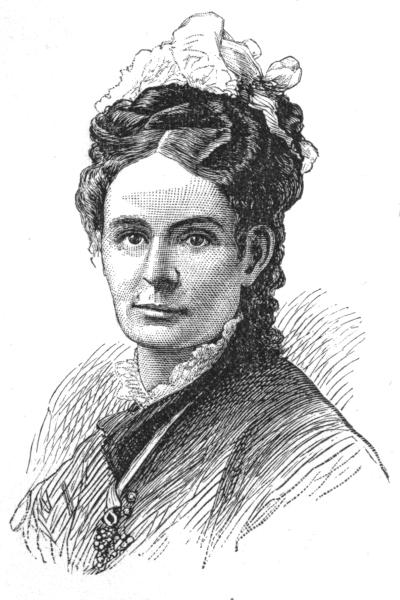
While in Washington I was favored with several gratifying testimonials. The first one was at the great National Carnival, where I received the prize for the best four-in-hand turn-out, a gold-mounted whip. The second testimonial was[79] a life-size portrait of President Grant, which was presented to me at one of the gatherings of the society attending the Metropolitan Memorial Church, and was accompanied in its presentation by the following address by Rev. J. P. Newman, D. D., the eloquent and distinguished pastor of the church:
Ladies and Gentlemen: Mine is a pleasing task. The ladies of this church desire me to present this elegant portrait of our honored President to Prof. Pratt, whose public spirit and great liberality prompted him to give the proceeds of his academy for one week towards the purchase of a chime of bells for this church. We much regret that sickness has detained the Professor from being present on this occasion, but we are happy to know that Mrs. Pratt is here.[1] The donation on his part is the more commendable because he came here a stranger, yet such is his appreciation of the beautiful and useful that he cheerfully gives his large sum for an object which will be, when achieved, the pride of the Capital.
His mission is eminently humane, for he not only educates the horse to obey the intelligence of his master, but also educates the master to treat the noblest of beasts with humanity.
[1] Her many friends will doubtless be gratified by finding, on the opposite page, a portrait of this lady—the life-long companion of the author.
The address, which was received with loud applause, was, in my absence, responded to by the Member of Congress from Batavia.
The third testimonial I received was presented on the day of closing my lectures, which had been so regularly attended by the citizens, officials, and members of the foreign legations, who deemed it proper to encourage my enterprise by presenting me with a diploma, engrossed on parchment, over their own signatures, and which was accompanied with a gold medal. The following is a copy of the diploma presented by the Washington class, the original of which is now in my possession, on parchment:
To Prof. O. S. Pratt:
We, the members of your Washington class, appreciate the value of the very necessary knowledge which you have imparted to us during your sojourn in the national metropolis; and we are convinced that your method of educating the horse, and reforming his vicious habits, is the only true system. As a mark of our estimation of the service rendered us, we beg your acceptance of the accompanying[81] testimonial, and our sincere wishes for your continued success, health and happiness.
On the next page the reader will find a correct cut of the gold medal which accompanied the diploma.
On the following day the Metropolitan Church arranged an excursion to Mount Vernon. The day was beautiful, and the company all that could be desired. The sail down the lovely stream, with its wooded banks, was delightful. On our arrival at the spot the laugh was hushed, for we felt ourselves on sacred soil as we neared the[82] tomb of Washington. After lingering for a time by the dust of the illustrious dead, we ascended the hill on which stands the house which was once the home of the Father of his Country. The furniture having been removed, we saw little more than the halls, a few relics enclosed in a case, and the marble mantel, which has been so much coveted by strangers on account of its rare carving, representing a farm-yard scene. This choice relic has been defaced in several places by unscrupulous visitors, who have broken off pieces to carry away as relics. We also visited the spot where Washington and Lafayette met, under a tree, to reconcile their difficulties.
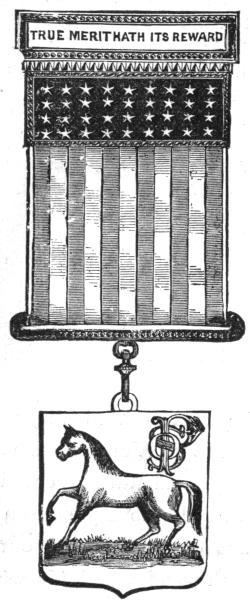
During our return to the city, which we reached the evening of the same day, speeches were made on the boat by the Mayor, ministers and bankers. We arrived in time to take the cars on our way to Long Branch, at which popular resort I passed most of the summer in visiting and recreation, before again resuming the duties of my profession.
ANNAPOLIS—DELAWARE—NEW JERSEY—NEW YORK STATE—THE GREAT EMPORIUM—CHICAGO IN FLAMES.
After my period of relaxation, I re-entered the active duties of my profession feeling greatly invigorated. I visited the pleasant city of Annapolis, the capital of Maryland, where I met a cordial reception from many whose warm appreciation of my system of educating the horse was coupled with marks of personal friendship. Here, as in other places on former occasions, my endeavors were crowned with a gratifying success. It is at this place that the United States Naval Academy is situated, an institution which sustains the same relation to the navy that West Point bears to the army of our country. In the extent of its bounds, covering, as it does, an area of about twenty acres, and in the completeness of its appointments, this academy is unequaled in the United States. Here I was introduced[85] to General Bovey, who is a lover of that noble animal, the horse, and is the owner of some of the finest that America can boast. He manifested much interest in my welfare, and kindly invited me to dine with him; after spending a long and pleasant hour in his society, I took my leave, and when, shortly after, I left Annapolis, I bore with me a grateful recollection of the many kindnesses I had received from the inhabitants of that beautiful city.
I will here claim the indulgence of the reader while I give a brief sketch of my journey from this point to New York. It was about the middle of May, 1871, when I started on my tour, intending to arrive at New York in the month of October. In passing through the State of Maryland, I found it a beautiful, level country, with a soil of great fertility. It is well known to have been one of the slave States, and, as a result, the population is made up largely of colored people, many of whom I found to be very, very poor; their houses, within and without, bespoke wretchedness and want, and many of them[86] seemed on the verge of starvation. Often was my heart moved to compassion as I viewed their dilapidated clothing, many of them being almost naked, while in their countenances want and misery were depicted. As I passed the settlements and, prompted by pity, gave them some donations, I saw their faces brighten as I placed the money in their tawny and wrinkled hands, while their expressions of thankfulness more than rewarded me for the gifts bestowed. In passing through this State I formed many classes, meeting with even better success than I anticipated.
Leaving Maryland, I entered the little State of Delaware, renowned for the extent of its orchards and the excellence of its peaches, which fruit forms the most profitable crop of the State, and is unequaled by any grown elsewhere. The country here also is level, but in many parts so sandy as to weary the traveler, whose animals often labor through sand to the depth of six inches, while the scorching rays of the sun, reflected from the sand, add much to the discomfort of a journey through this State.
At Dover, the capital of the State, I formed an interesting class, of which the Governor and many distinguished citizens became members. The buildings in Dover are mostly of wood, there being none of stone and but few of brick.
After leaving Dover I crossed Delaware Bay, and entered the State of New Jersey. This, also, in its more southern portions, may be described as a level country, but the lands there are clothed with dense forests of pine, where human habitations are rarely met, and even the sound of the woodman’s axe is seldom heard. These “pine barrens” are in places destitute of traveled roads, and the one journeying through them sees his course marked out by “blazed” trees. I wended my way along until I reached the city of Trenton, the capital of the State, where I formed a class. Thence I passed to the city of Rahway, then to Elizabeth, and afterwards to the town of Long Branch, forming interesting classes at each place. The last-named place is well known as a favorite and much-admired watering-place, being the summer resort[88] of thousands who annually seek its pure sea-breezes, and regale themselves in the pleasures it abundantly affords. I visited many other places in the State, forming classes and receiving the congratulations of numbers who appreciated the knowledge it was my aim to impart.
Passing some twenty miles across a pleasant though sandy country, I reached the village of Red Bank, at which place I took the steamboat, and, after sailing through the magnificent Bay of New York, passed up the Hudson River to Sing Sing, at which place I met with success, and formed a class composed mainly of the first citizens of the town. I devoted my first leisure to visiting the State Prison, which is situated in the suburbs, on the bank of the Hudson, and, after being conducted through the different departments, I was permitted to see a record of the names of the inmates and the crimes for which they were incarcerated, and I record it as my conviction that many there have laid a foundation for after crime by early cruelty to the noblest of all animals save man. One step of[89] cruelty leads inevitably to others, and thus the disposition may have grown that has led, finally, to the crime which deprived them of liberty and condemned them to years of servitude in that dreary abode of felons.
Retracing my steps down the Hudson, I next pitched my tent at Peekskill, which is situated on the east bank of the river, and where I met a gratifying reception, and succeeded as at other places.
Before leaving the place, I strolled about a mile back from the river, and saw there the farm and summer residence of Rev. Henry Ward Beecher, the great biblical expounder and platform orator, who has since passed through an ordeal far from pleasing or profitable, though there are indications that from all he will yet come out as “gold tried in the fire,” and perhaps to shine as a star of still brighter lustre.
My next visit was to the city of Poughkeepsie, where, at my first public exhibition, I was greeted by the presence of a large number of influential citizens, whose appearance there augured well[90] for my success. I was pleased with my brief visit to this place, as my class soon swelled to the number of three hundred and fifty. I here formed the acquaintance of Prof. Eastman, of Eastman College, who solicited me to give an exhibition, on the grounds in front of his splendid mansion, to the Sabbath-school children of the city. I consented, and gave an exhibition which was received with delight by a multitude of youth of both sexes.
I now determined to direct my course down the beautiful Hudson to the great commercial emporium of the country, the city of New York. There I built an academy, at a cost of nearly three thousand dollars, capable of accommodating about four thousand persons. I opened, with brilliant prospects, about the middle of October, 1871, and as the days rolled by I had ample evidence of the appreciation of my efforts in the daily increase of my class, until, on the 15th of January, 1872, I had the pleasure of numbering on my register the handsome amount of three[91] thousand names, representing amongst them many of the first men of the city.
I had intended to remain in New York until the opening of spring, but about this time an event which spread consternation through the land blighted my fair prospects. Along the wires of the telegraph, flashed eastward with lightning speed, came the doleful tidings that Chicago, the Queen City of the West, was in flames! As message after message came, telling of the progress of the devouring element, all hearts were filled with sympathy, till the final tidings came that for many square miles the once beautiful city was a vast plain of smouldering ruins, and that thousands of human beings, thus rendered homeless and penniless, were in almost a starving condition. At once the hearts of the people of New York were moved to compassion. Business was well-nigh suspended. The single topic which engaged all minds was the great disaster which had befallen a sister city, and how to devise means for relief to the destitute and suffering. In this absorbing feeling the interest in[92] my lectures naturally abated; so much so, that I closed my academy and joined with my countrymen in the active measures which were at once inaugurated for extending relief to the needy. I attended the meetings held for that purpose, and heartily co-operated in sending the greatly needed aid to suffering humanity. I remained in New York till the excitement had somewhat abated, and then decided on visiting some of the New England States; but, before leaving the Great Emporium, I received a diploma attesting the high value placed on my instructions by those who had received them.
BRIDGEPORT—FALL OF ACADEMY—PROVIDENCE—BOSTON—CLASS OF 3,000—LYNN—PURCHASE OF A RESIDENCE—PORTLAND—BANGOR.
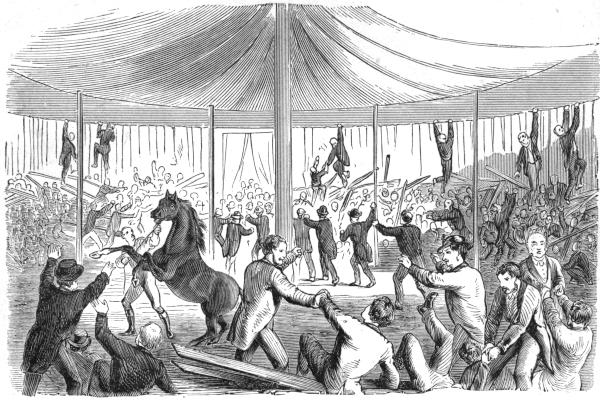
BRIDGEPORT ACADEMY.
On entering New England, my first stop was at the beautiful town of Bridgeport, somewhat celebrated as the home of the renowned sensationalist, P. T. Barnum, who has, during quite an eventful career, acquired and lost many fortunes. As the winter had not yet passed, I here erected an academy, which became the scene of an incident which will forever remain fixed on my memory. The people of Bridgeport turned out nobly, filling my academy to its utmost capacity, when, hearing a noise, I looked in the direction whence it proceeded, and, to my horror, saw the seats falling, with their occupants, precipitating them to the ground! Of course all for a time was confusion and affright, but, strange to say, not one of the immense crowd was injured by the accident.
After the excitement had somewhat subsided, I proceeded to form a class, which numbered about three hundred, who seemed delighted with the knowledge they acquired under my instructions.
When my labors had ended I took an opportunity to view the town, and was greatly interested in visiting some of its principal manufactories. Amongst these one of special note is the immense establishment for the manufacture of the Howe Sewing Machines, said to be one of the largest in the world.
I subsequently visited Providence, the capital of Rhode Island, where I found it necessary to build another academy, which I erected very near the public thoroughfare of the city. At this place my most sanguine expectations were realized, as I met with signal success; nearly one thousand persons became members of my class, and the financial results were greatly beneficial to me, as at this time my expenses were great. My troupe consisted of some eight men and twelve horses, the expenses of which were[97] large, besides the cost of extensively advertising, that I might give wider publicity to a system which had gained general favor wherever it was known.
The far-famed city of Boston was my next resting-place. Here, as at other places, I found it necessary to exhibit in an academy, and, having fitted it up, I entered on my work with renewed hope and energy, believing, from the usefulness and practicability of my system of educating the horse, that a failure was impossible. Nor was I disappointed; the shrewd minds of the Bay State saw the value of the knowledge I imparted, and, cheered on by growing favor, I put forth every effort, and was rewarded by the most gratifying success, as my class reached the large number of three thousand persons.
With the close of my labors in Boston the winter had passed away, and I decided on a trip reaching northward as far as Portland, in Maine, making short stops at the several towns between Boston and that place, first stopping at a beautiful[98] town called Lynn, where I purchased a nice family residence, a good representation of which is given in the cut.
In this charming town and its vicinity there is much to attract and please the visitor. Among the favorite resorts is a delightful watering-place known as Nahant Beach, to which, during the summer, thousands come to enjoy the invigorating breezes of the ocean. Here the invalid seeks the coveted boon of health, while the healthy come to reinvigorate their systems. Mrs. Pratt and myself christened the place the “green spot of earth,” as often, attended by our servants, we drove in our carriage around the beach, for the time forgetting the toils of the past, and almost fancying ourselves in the land of Paradise.
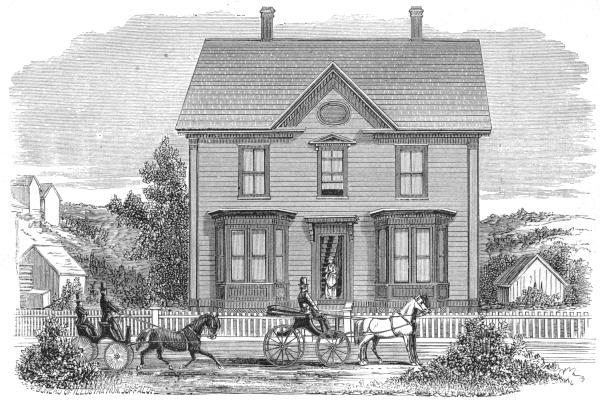
NAHANT BEACH RESIDENCE.
I may be allowed, at this point, to give a letter addressed to me by a well-known gentleman, a citizen of that pleasant town.
Lynn, July 12, 1872.
Prof. O. S. Pratt.
Dear Sir: I regret your departure from our city. I have received a great benefit by joining your school. Your system of educating horses is far ahead of any now in use. I[101] belong to Rockwell’s class. In nothing has there been greater improvement. Its advantage is its simplicity. In no exhibition during your short stay have I failed to find some new point. There is no deception, no trickery, no unfairness. What you say I’ve found you willing to back up with your money; your goods are no humbug. Why will people be so skeptical. People ask me every day, “Can you do it?” My answer is, “Yes.” Why sir, I would not take five hundred dollars for what I’ve learned of your system.
If people would be more willing to join your class and get the system, we should have less accidents by that noblest of animals, the horse. When you were educating Lannan’s horse the other evening, a skeptic stood by my side. I said, “Pratt will drive that horse to-morrow.” Says he, “I’ll bet a hundred dollars he won’t.” He put his hand in his pocket, attempting to draw his wallet. I caught his hand, saying to him, “If you’ve friends enough here to raise $5,000, it shall be covered, that he will drive him to-night.” I am not a betting man, though. The gentleman went into his boots. You have not a pupil, I know of, but is willing to back you, as far as able, in anything you say you will do with any horse.
God speed you in the right.
Yours truly,
Charles D. Tilton.
After the pleasure season had passed, I again betook myself to my profession, and, once more upon the road, I stopped at several towns, giving[102] public exhibitions and forming classes, until I reached Portland, which place I entered about the first of August, 1872. Here we set our stakes and spread our canvas, giving, as usual, public exhibitions, and organizing a class of about two hundred persons. Many vicious horses were here brought to me, that on them the merits of my system might be tested, all of which I handled to the satisfaction, and, I may safely say, the admiration of the class who witnessed their education.
Next, placing my troupe and animals on a steamer, I passed by sea to the city of Bangor, the most populous in the State of Maine. Here I made arrangements with the officers of the Agricultural Society, by which I secured the Fair Grounds, where I erected a spacious pavilion, and at once commenced operations. It was soon evident that I had secured the favor of the people, as I was largely patronized. While there I made arrangements with Dr. Tewksbury to handle his imported stallion, “Anfield,” who was notorious for his vicious propensities, extending[103] even to the shedding of human blood, he having fought many battles, and always had come off victorious. Although my fame had spread far and wide, and I had educated many vicious horses, yet, had I not possessed implicit confidence in the virtues of my system, I would have declined; but, prompted and encouraged by my previous successes, I decided to handle him on my arrival at Lewiston, Maine, which would be about the first of September.
While at Bangor I received a letter from the President of the Society for the Prevention of Cruelty to Animals, as follows:
Bangor, Me., September 28, 1872.
Prof. O. S. Pratt.
My Dear Sir: I am happy to acknowledge your superior system of Horse Education, which deserves the commendation of all who desire the improvement of that beautiful and useful animal. Your system does not inflict torture or cruelty, but subdues and teaches him, and in my opinion it is only to be seen and learned to be universally adopted.
I take much pleasure in recommending it to the notice of all who have the care and management of horses.
Very respectfully,
J. D. Warren,
Pres. Soc. for P. of C. to Animals.
LEWISTON—EDUCATING THE HORSE “ANFIELD”—TESTIMONIAL—CONCORD—MANCHESTER—A STEAM ENGINE IN THE RING—LOWELL—LAWRENCE.
Continuing my tour, I exhibited at many places in the State until I reached the city of Augusta, where I remained two days, and met with marked success. Anxious to reach Lewiston by the time I had fixed, I passed rapidly, through many towns and villages, only remaining a day in each place, and arrived at Lewiston on the eighth of September. It was here, as the reader will remember, that I was to handle the notorious “Anfield.”
After building an academy, and giving a public exhibition, I announced my intention of controlling that vicious animal. The citizens turned out en masse, but, as the horse was led into the ring, the whole audience seemed terror-stricken, wondering, no doubt, whether or not I would[105] share the fate that others had; but speedily their terror gave place to admiration, as they saw the powerful animal succumb to the resistless energy and efficacy of my system, for, within one short hour, the lion-like brute became meek and quiet as a lamb, greatly to the astonishment of the multitude, who gazed with wonder on the transformation. I give below the testimonial subsequently presented to me, in which this feat is described:
We, the undersigned citizens of Lewiston and vicinity, hereby certify that we are members of Prof. O. S. Pratt’s school for instruction in the proper education of the horse; that from a careful and thorough examination of his method, as succinctly demonstrated by him in his admirable lectures and apt illustrations, we unqualifiedly pronounce Professor Pratt’s system as most practical, and far superior to any ever before known.
His power over the most vicious and ferocious horses is at once wonderful and instructive, as verified by his handling of the stallion “Anfield,” in Lewiston, on Thursday evening, October 17, 1872, before an audience of 1,000 persons.
“Anfield” is an eleven-year-old dark bay stallion, and standing sixteen or seventeen hands high, and is owned by Dr. S. H. Tewksbury, of Portland, Me. He is reported to[106] have killed one man, and was a bad biter, striker, and somewhat given to kicking. He had never been harnessed.
He was led into the academy on the above night, secured by iron rods and with a heavy muzzle over his mouth. He manifested an ugliness truly characteristic.
Prof. Pratt, applying the rules of his system, at once so comprehensive and yet so simple, within twenty minutes had contemptuously thrown away the iron rods, muzzle, etc., and exhibited to his audience one of the most tractable of horses, who would follow him when commanded, stopping at the word “whoa,” and, being harnessed, was driven around the ring in a vehicle continually hitting his heels.
Prof. Pratt’s Lewiston class numbers, at the present time, three hundred and sixty members.
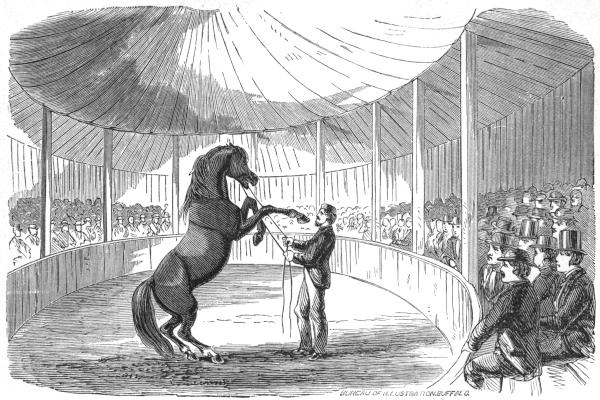
LEWISTON ACADEMY.
We most cheerfully commend the system of Prof. Pratt to the public generally, assuring them that, in our opinion, it is the inauguration of a new and happier era for that noblest of the brute creation—the horse.
Lewiston, Me., October 2, 1872.
Passing through a beautiful country, and forming a number of classes on the way, we at length reached Concord, the capital of New Hampshire. I there obtained the large building used by the mechanics for the exhibition of their manufactured articles on the days of the regular Fair. This I fitted up and used for my lectures. The news of my success at other places had preceded me, and I found the citizens ready to respond to my invitation to form themselves into a class. This class was a large and profitable one, adding much to my financial resources in the business. The city of Manchester was the next place I visited. Its magnificent water-power and busy manufactories, amongst them[110] some of the largest producers of carpets and cloth in the United States, make it a place of great importance. It was here that I achieved a victory never before known to the public—that of educating the horse not to fear either the steam engine or the cars. Having had placed at my service the steam engine manufactured by Amos Keig, I had it brought into the ring. In a short time the engineer got up steam, and set it in motion. Horses by the half-dozen were brought in to be educated, and, as my success was shown in removing all fear of that terrifying object, language almost fails to describe the enthusiasm excited, and the eulogies pronounced on my system. As this was the first opportunity that had presented itself for me to show the power and beauty of that portion of my system, I was greatly cheered and gratified with the success attending my efforts, especially as the papers of the city heralded my success in no uncertain tones, and proclaimed the almost incalculable benefit which would accrue to society from the adoption of my system.
Traveling southward about fifteen miles, I reached the city of Lowell, where I built an academy, and had the pleasure of enrolling in my class a large number of the influential citizens of that place, who were as much delighted with my system as I was with my successful efforts.
The next place of interest to be named is the city of Lawrence, renowned for its mills and manufactures. Here may be seen a building nearly a mile in length, erected along the bank of the famous water-power, and used exclusively for manufacturing purposes. At this city, also, I built an academy, remaining a few days, and meeting warm-hearted friends, who gave me a large class.
By this time I had fully equipped myself with all appliances needed to confront and convince the most skeptical, so that no person could successfully assail my almost perfect system of equine education, which, by the force of its own merits, had thus far won its way, and was daily gaining new favor in the eyes of the public.
My next effort was made about the first of March, 1873, in the city of Worcester, where, from the commencement, the interest daily increased during the whole period of my stay, and abundant success crowned my endeavors.
Some leading citizens of Springfield now wrote to me, requesting that I should visit their town, to which I consented, and, on reaching the place, I found a wide-spread eagerness to secure the knowledge I possessed. I built an academy, and was much gratified by securing an appreciative class.
Leaving the old State of Massachusetts, I directed my course to Hartford, in the State of Connecticut, where, as in former places, I found it necessary to build an academy, which, on the first day of my exhibition, I had the pleasure of seeing filled to its utmost capacity, and, when I turned my attention to forming a class, my endeavors met with a hearty response.
TOUR IN CANADA—MONTREAL—CLASS OF 1,000—VICTORIA BRIDGE—CATHEDRAL—QUEBEC—OTTAWA—KINGSTON—DETROIT—DIPLOMA—VALUABLE TESTIMONIAL—SIMCOE.
Hitherto my labors had been confined to my own country. I had traveled many hundreds of miles, visiting its great cities, its smaller towns and thriving villages, and everywhere, even from the highest in the land, I had met a cordial reception. But now I formed the purpose of crossing the St. Lawrence River, which divides, on the north, the American from the British possessions, and of making a tour through a large portion of the Dominion of Canada. Believing that I had more stock and other property than I would require, I sold by auction many articles, and, placing my remaining stock and appendages on several cars, I forwarded them to their destination. Reaching St. Albans, I was solicited to remain there a few days, which I did, and had[114] no cause to regret my decision, for the people gave me a liberal patronage.
Continuing my journey from St. Albans, I arrived at the important commercial city, Montreal, about the first of May, where I met a cordial reception. At once I commenced the erection of an academy of capacity sufficient to hold at least two thousand persons. Soon the tidings of the great successes I had achieved in my profession spread far and wide through that populous and wealthy city, and, as a result, during the few days I remained, I had the pleasure of enrolling nearly one thousand names.
In this ancient city there are many beautiful and interesting objects which attract the attention of a visitor. A few of the most prominent are all that I can mention. Of these the great Victoria Bridge is one. A massive structure of iron, tightly closed at the sides and nicely roofed, it spans the St. Lawrence River just at the outskirts of the city. Windows, at certain intervals, admit the light and air. Carriages and pedestrians are excluded, the railroad company[115] having the sole right to use the bridge. The French Catholic Cathedral is to many an object of great attractiveness, and thousands ascend its circuitous flights of stairs to the top of the tower, from which the eye may take in the entire city, with its many public parks and pleasure grounds far exceeding in number those usual to a commercial city. The mountain, about three miles distant from the heart of the city, is a favorite resort. A beautiful and almost level road runs round it, along which, at almost every hour of the day, carriages may be seen coursing. Many other pleasing sights might be named, but I close my reminiscences of the beautiful city by the remark that nowhere, in all my travels, have I seen more elegant and costly private dwellings than are those which grace Montreal.
Through the solicitation of friends, I was induced to visit Quebec, the ancient capital and late seat of the Canadian government.
As it is approached, the forest of masts which meets the eye, peering up in every direction, might suggest reminiscences of some cedar[116] swamp, with its multitude of tapering trees, but, upon closer inspection, the eye is delighted with the magnitude and beauty of the shipping which crowds the port. Some of the finest vessels that plow the ocean are here to be found. On entering on my work, I met with no difficulty in interesting the minds of the citizens in my subject. They turned out nobly to my public exhibitions, and rewarded my exertions by giving me a large and interesting class.
Leaving Quebec about the middle of May, I ascended the St. Lawrence as far as the beautiful town of Brockville, exhibiting at many towns on my way. Here I determined to forward my horses and stock by rail to the city of Ottawa, the capital of the Dominion and the seat of government, where annually the assembled wisdom of the country meet to legislate for the great Canadian Dominion; nor need one cross the ocean to the mother country, nor even visit the adjoining republic, to meet with both orators and statesmen, many of whom grace the Canadian Parliament, the halls of which often ring with eloquence, as, in the discharge of their responsible[117] duties, the statesmen of the Dominion discuss the great topics of the day. Although my stay in Ottawa was brief, I had the satisfaction of forming there a class of three hundred persons.
Passing westward, I held public exhibitions and formed classes in many places, until I reached Kingston, rightly named the Old Limestone City. Here I spent a few days very pleasantly, and had the pleasure of forming a satisfactory class. The strong bulwarks and splendid fortifications of this city give it a military air, and afford ample protection from an invading force.
At this point I embarked on one of the Mail Line of steamers, with my stock and equipments, and passed up Lake Ontario to Burlington Bay, and thence to the city of Hamilton. As I had been frequently solicited to visit Detroit, and having determined on spending the ensuing winter in Hamilton and Toronto, I did not at this time attempt to form a class, but took the most direct route to Detroit city, exhibiting at a number of places on my way.
Detroit is situated on the river bearing its name, which divides the American and Canadian possessions. Its commerce is quite large, and,[118] to one standing on the banks of the river, a pleasing and animated picture is presented. The rapid stream, in places running with a current of from five to eight miles an hour, is difficult of navigation for sailing vessels, and one sees the sailing craft, loaded with grain and lumber, towed by large and powerful steam-tugs, built expressly for that purpose, while the smiling banks on the Canadian side, crowned by the buildings of Windsor, mirror themselves in the farther waters.
It was in December, 1873, that I reached Detroit, remaining there a few weeks, and during that time forming a class of over twelve hundred members. Before taking my leave of that pleasant and enterprising city, I received from my class a diploma, which I prize more highly than gold, while, to increase my delight, I was, most unexpectedly to myself, made the recipient of an elegant cabinet music-box, the value of which could not be less than five hundred dollars. The following is the diploma, as signed and presented to me, followed by a cut of the elegant testimonial:
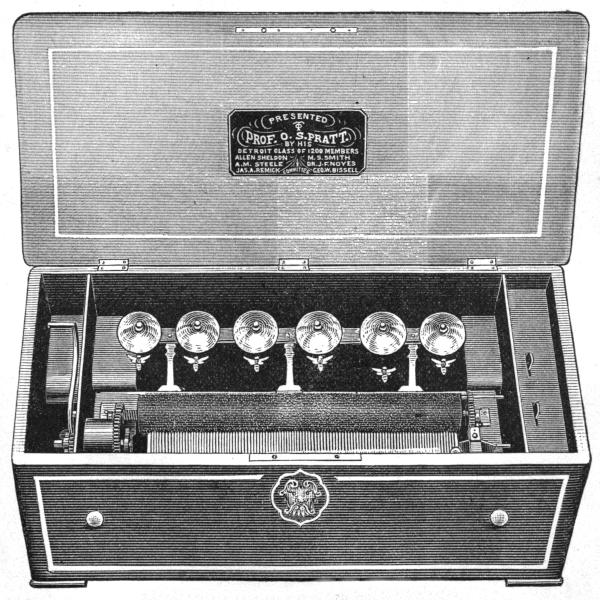
MUSIC BOX FROM DETROIT CLASS.
Having attended Prof. O. S. Pratt’s lectures to his class, and also having seen the practical application of his system as given by him every afternoon and evening at his academy, and believing it to be far the best ever seen in this State, so clear and practical that the merest novice can understand and use it, and yet so comprehensive that the most skillful horseman can be instructed by it, we deem it of the utmost importance that all persons owning, using, or at all interested in horses, should avail themselves of Prof. Pratt’s knowledge on that subject. He educates the man to educate the horse, the only practical method to be of permanent benefit.
Passing from Detroit, I again set foot on Canadian soil, exhibiting at a town named Sarnia, situated on the Detroit River, and after that at many other places until I reached the pleasant little town of Simcoe. There I received a cordial welcome from many lovers of the horse, and found no difficulty in forming a class of one hundred and ninety, who not only appreciated my system, but embraced an early opportunity of presenting me with a diploma testifying that appreciation. It was read in my hearing on its being presented, and the reader may well believe that I was greatly gratified and cheered by the sentiments therein expressed.
Simcoe, February 24, 1874.
Having attended Prof. O. S. Pratt’s lectures to his class and also having seen the practical application of his system, as given by him every afternoon and evening at his academy, and believing it to be far the best ever seen in Canada, so clear and practical that the merest novice can understand and use it, and yet so comprehensive that the most skillful horseman can be instructed by it, we deem it of utmost importance that all persons owning, using, or at all interested in horses, avail themselves of Prof. Pratt’s knowledge on that[123] subject. He educates the man to educate the horse, the only practical method to be of permanent benefit.
Part of Simcoe class numbering 227 in ten days.
TORONTO—“BRITISH ENSIGN”—DIPLOMA—SILVER TEA SET—HAMILTON—BELLEVILLE—DIPLOMA—PICTON.
Winter was now drawing nigh, and, as I was desirous to reach Toronto, the Queen City of the Province of Ontario, as soon as possible, I made but a short stay at Brantford and other towns on my way. Arriving at Toronto about the last of November, 1874, I secured possession of the Riding Academy, and fitted it up at considerable cost, after which I gave public exhibitions, which awakened an increasing interest. I remained there sixty days, my class becoming larger daily, until, at the close of my labors, my register showed the names of nearly thirteen hundred members, many of whom were amongst the most influential citizens of the place. During my stay I handled some two hundred horses, each of whom had been addicted to some bad habit.
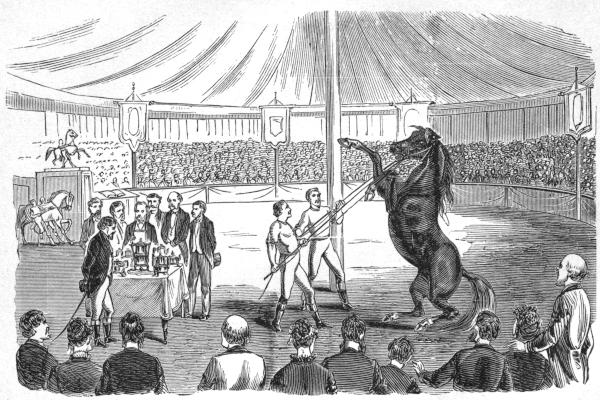
Toronto Academy—PRESENTATION OF TEA SERVICE AND ILLUMINATED ADDRESS.
Many members of my class were desirous that I should exhibit the power of my system to educate horses not to fear the steam engine, and, that I might meet their wishes, I procured a steam fire engine, which I caused to be placed in my academy. During my stay there I educated some hundred horses to the perfect satisfaction of their owners, and the evident gratification of my class. Amongst others, I may name as a signal triumph of my system the case of the stallion “British Ensign,” owned at Richmond Hill, who, from his vicious habits of long standing, was thought to be incurable, and, as a last resort, I was solicited to handle him. This was at the close of my labors there, and, the day being announced, the members of my class gathered in force to witness my last effort in their city. The horse was led into the ring by two men by means of iron rods securely fastened on each side of his mouth. From the account given of this animal, one would almost expect that a man could tame a lion of the desert as easily as him; but, strange as it may seem, within[126] ten minutes he followed me around the ring as meekly as a lamb, and within forty-five minutes I was able to drive him before a vehicle, without reins or side-straps, greatly to the surprise of the throngs who had assembled to witness the spectacle.
The power and efficacy of my system was so completely demonstrated that the leading journals of the city made favorable mention of my unparalleled success, while my class signalized their sense of the value of my system for properly educating the horse by presenting me with an illuminated address, the elegant execution of which reflects credit on the artist, while the courtly language and graceful sentiments are worthy of the distinguished gentlemen whose names it bears. Not satisfied with this, they accompanied the address with a costly tea-service of silver, the intrinsic value of which was at least three hundred dollars. Long will the recollections of my Toronto class cluster about my memory, and fill my mind with pleasing emotions. The following is the diploma presented[127] by the Toronto class, the original of which can be seen in my possession, on parchment:
Toronto, January, 1875.
Dear Sir: The undersigned, on behalf of the members of your numerous class in this city, desire to testify their appreciation of the valuable instructions you have imparted to them. The unwearying assiduity with which you have endeavored to make those instructions comprehensive and entertaining, and their high estimation of your admirable system of educating and managing the horse. The knowledge imparted to us during the many lectures and exhibitions of your unexampled method of treating that noble animal may be of incalculable benefit to many of us. We do not hesitate to say that numbers of accidents occur daily (many fatally) through an insufficient knowledge of managing the animal you have made so perfectly subject to your will, and we advise every one whose business or profession require frequent, if not constant, use of the horse to embrace an early opportunity of acquiring a knowledge of your system. Farmers, whom business occasionally calls into our cities, and the immediate neighborhood of our railways, we especially urge the necessity of learning your simple and effective method of control, a method easily understood by the instructive faculties of the horse as by the reasoning faculties of men.
We trust that your sojourn in the Queen City of the West has been both pleasant and remunerative, so far at least that will at no distant day induce your return.
In conclusion, we beg your acceptance of the accompanying Tea-Service. Hoping that it may recall favorably to your recollection those who constituted your class in Toronto and who unanimously wish you every success in your laudable and humane profession.
Signed, on behalf of the class, numbering 1,254 members.
Before closing my notice of Toronto, I would refer with grateful words to the kind, and even laudatory, notices which my system and myself received from the ably conducted press of that city, and, I might add, of the whole Province, as the following extracts will evince.
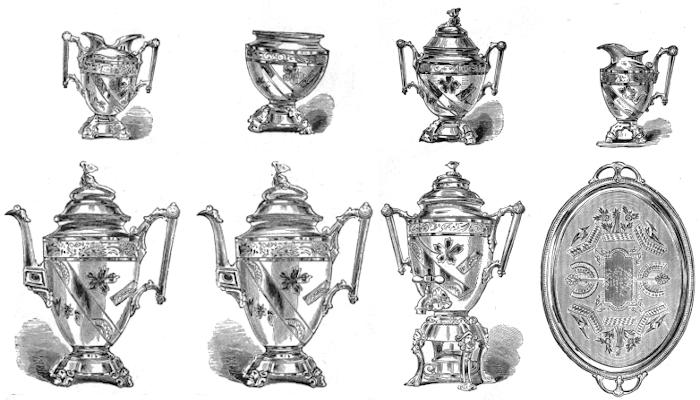
TEA SERVICE FROM TORONTO CLASS.
The Toronto Mail thus speaks:
Horse Education.—To-day we place before our readers illustrations of several of the numerous articles, with the text of the numerous addresses, presented to Prof. Pratt, the horse educator. By close observation, an accurate knowledge of the construction of the horse and its habits, and above all by a recognition of those sound common-sense principles advanced by the best teachers of the human kind. Mr. Pratt has been enabled to build up a system which for its thoroughness and adaptability is unexcelled in the present day. That this is not an unwarranted assertion is proved incontestably by the testimony of the leading horsemen of the United States and Canada, though Mr. Pratt has been but a short time in the Dominion. Wherever he has established classes, a just tribute has been paid to his great services both to man and beast. In Baltimore 3,590 pupils surrounded him, and he left with the thanks of the citizens, and was presented with a magnificently mounted whip. Detroit rallied 1,200 members, who gave the Professor a musical box to sweetly play the song of their appreciation. The Washington class of 2,500 members, presented a gold medal, and that of Philadelphia, of 4,886 members, a gold-headed cane. Toronto has not been behindhand, for, as already announced, the class here made a presentation of a beautiful tea-service and illuminated address. The Toronto class now numbers 1,254 members.
The Toronto Globe, in brief but well considered words, declares:
Prof. Pratt’s lectures on the treatment of animals are invaluable to farmers and all owners of horses and cattle. We only wish every farmer and farmer’s boy in Canada could attend one lecture.
The Canada Farmer, the leading agricultural paper of the Province, in describing a visit to my exhibitions and lectures, remarks:
We have seldom passed an evening so pleasantly, or with so much real profit, and our advice to every farmer and farmer’s son in the country is, to take a course of lessons if possible, but at all events to attend one of Professor Pratt’s public exhibitions. We feel perfectly satisfied that a couple of hours spent in witnessing one of these performances will impart a better idea of the nature and management of the horse than is possible to obtain by any course of reading on the subject, and in this respect alone one such entertainment is worth fifty times the amount charged for a life-membership.
I next visited the city of Hamilton, where I was welcomed by many warm friends, who took an active interest in my welfare and seemed delighted with my system, which, at this time, had gained great favor with the Canadian people.[133] Here I formed a large and profitable class, and secured the friendship of many, from whom I have since met a cordial reception.
Leaving Hamilton, I directed my course to the town of Whitby, where I formed a class of one hundred and twenty-five; next visiting Oshawa, where my class reached the number of one hundred and forty; then to Bowmanville, where a class of a hundred rewarded my efforts; from there to Port Hope, where one hundred and fifty joined the class I opened; thence to Belleville, where I enrolled about one hundred names. After having left the latter place for about a week, I was followed by a messenger, dispatched to me by my class, who bore a diploma highly eulogizing my system. It was as follows:
Belleville, May 11, 1875.
Prof. O. S. Pratt.
Dear Sir: We, the undersigned, express our satisfaction of the tuition we have received from you in the education of the horse and most cheerfully recommend your art to all who own, have or use horses, as being the best known and exhibited.
The manner in which you handled all the vicious horses brought to you here, completely subduing them in a very short time, gave us the greatest satisfaction.
Your liberality and gentlemanly deportment have secured numerous friends.
Trusting you will meet with the same success in other places that attended you here, and hoping you may be long spared to propagate your noble system of horse training, we are, etc.
(Signed),
From Belleville I went to the town of Picton, where I found many admirers of that noble animal, the horse. Though the place is not large, the people flocked to my exhibitions, and gave me a class of one hundred and forty members, while, after I had left their town, and was engaged at the village of Wellington, twelve miles distant, a deputation from Picton waited on me, and presented me with the following diploma, which will speak for itself:
Picton, May 17, 1875.
Prof. O. S. Pratt:
We, the members of your class, formed in the town of Picton, are unwilling to allow you to take your leave without warmly expressing the great satisfaction that has been ours since your arrival among us. Your plain, lucid and highly interesting lectures, combined with your gentlemanly deportment, has been such as to leave a lasting and beneficial impression on our memories. Your manner of handling vicious and untutored horses has been highly gratifying to us, and the rapid progress made by you clearly proves the superiority of your system. Your book, so replete with instructions, illustrating what we have seen practically demonstrated, will, we believe, greatly benefit us in the practice of your system in future years.
Believe us, dear sir, to bespeak for you unequaled success in your future efforts.
Yours, etc., etc.,
After forming classes in several places in the old loyal county of Prince Edward, and meeting with good success, I crossed the beautiful waters of the Bay of Quintie, arriving at the town of Napanee about the first of June, 1875. There I formed a class of one hundred. Pursuing my journey, I traveled north and west, exhibiting at many places, until I reached the town of Peterborough, where I remained a short time, and formed a class of one hundred members. Departing thence, I visited many towns and villages, forming classes in each, on my way[137] to Lindsay, at which place I enrolled the names of seventy-eight members.
From Lindsay I went to Fenelon Falls, quite a newly-erected town, yet I found many there to whom my visit was a pleasure, as I soon obtained a class of some sixty members.
Passing on westward, I continued to meet with success, forming classes in some few small villages until, on the 9th of September, I entered the beautiful town of Barrie. There I found warm friends, and many lovers of the horse, who met me cordially, and gave me a class of one hundred and thirty-five members.
I next shaped my course northward, to the old town of Penetanguishine, on the eastern shore of Georgian Bay. The larger portion of the inhabitants are French Canadians, many of whom are unable to speak our language. I was informed by some of the old inhabitants that the town was first settled a century ago; but, notwithstanding this, their progress has been slow, as at present the population is but about one thousand. My class in this place numbered about[138] seventy persons, who seemed highly pleased with my system of educating the horse.
At Penetanguishine I took passage on the steamer Waubuno for Collingwood. The boat is commanded by Captain Peter Campbell, a courteous gentleman, who possesses the power of so adapting himself to his passengers as to make a trip with him pleasant in both the enjoyment and the retrospect, while the romantic scenery which meets the eye of the voyager who ascends the bay is so beautiful that, were it not for the severity of the winters there, one might easily be tempted to select his home amongst the beauties of nature which adorn the shores of Georgian Bay.
On arriving at Collingwood, I gave an exhibition that created a strong interest among the citizens, and resulted in my forming a good class, who manifested both satisfaction and delight with the instructions I imparted.
After exhibiting at small towns on the way, I arrived at the truly beautiful and lately-incorporated town of Meaford, on the fifth day of October.[139] A drenching rain was falling, which seemed to indicate that my prospects of success would be blighted by the inauspicious storm; but, as the day swept on towards noon, the parting clouds allowed the golden sunbeams to flow through, and, by two o’clock, the whole aspect of the scene was changed. I gave a public exhibition, and formed a class of nearly one hundred members.
From Meaford I traveled over bad roads until I reached Owen Sound. Here I did not find as many lovers of the horse as I anticipated, yet I was pleased before the close of my labors by meeting a good degree of success.
Georgian Bay, near the southern bend of which is Owen Sound, is a beautiful sheet of water, broadening out as it leaves Lake Huron, with which it is connected, and forming what seems like a land-locked lake in itself. Large steamers leave this port for Lake Superior, and many tourists deem this route one of the most pleasing of all on the upper lakes. Ere long, it is asserted, a communication will be opened from[140] this point to Winnipeg and the far-off Province of Manitoba.
Having thus brought my narrative down to the present time, I would add a few words to the reader who may have kindly followed me through the scenes I have recorded. In what I have written one object has been to show the strong and unqualified endorsement my system of equine education has everywhere received from the men best qualified to judge of its merits, while, at the same time, the narrative is a fitting, and I hope not an uninteresting, introduction to the system itself, which, with other matter relating to the general subject, will be fully and clearly taught in the following portions of the book.
And now, with a hearty appreciation of the unvarying kindness he has received from his patrons in all portions of the land, the author begs leave to respectfully dedicate this work to those whose aid, appreciation and friendship have so often cheered him in his efforts.
From the earliest ages this noble animal has been the friend and companion of man. Prized for his beauty, loved for his docility, and valued for his strength, he has ever been regarded as the highest in value and importance of all domesticated animals. In the remotest ages, as far back as authentic history discloses anything of the life and pursuits of man, we find that the horse occupied a prominent position in his service. Painters have pictured on their canvas the majesty and grace of the spirited animal. Poets have celebrated his strength and beauty in their verses, and even inspired writers have introduced amongst their most glowing descriptions the horsemen and chariots which formed a chief feature in the pomp and magnificence of those early days.
In the most ancient hieroglyphs we find him present, and always so represented as to show that, even in the remote antiquity from which they date, he had been brought into complete and serviceable subjection. In the oldest Egyptian paintings the horse is seen only in the war chariot, and in the descriptions of the siege of Troy only the charioteer appears, from which it has been supposed that the first horses used by the Greeks were too small to be conveniently ridden. But in the lately-discovered paintings in the palace of Nimrod, at Nineveh, disinterred by Layard, and supposed to be more than three thousand years old, horsemen are exhibited both in the chase and war.
But further back than even those distant times, in the ages where authentic history merges into the shadowy light, amidst which myth and fable mingle with the real, we find this noble animal figuring, but then exalted into a semi-human sphere. The Centaurs, who inhabited the passes of Mts. Pelion and Ossa, and the great plains of Thessaly, in Upper Greece, were probably a[143] race resembling in many respects the Tartars of this age, and are supposed to have been the first who brought the horse into subjection to man. They were fabled as being half horse and half man. They are represented as perfect horses in all respects below and behind the withers and the chest; there, at the insertion of the neck, began a human body, the hip-joints articulating into the shoulders of the lower animal, and the abdomen of the man passing gradually into the chest of the horse. Above this the human form was perfect, with the erect bearing, chest, shoulders, arms, neck and head of a complete man. They were reputed to be possessed of extraordinary mental as well as physical powers, and to be as superior to ordinary men in wisdom and art as they were in fleetness and strength. They were evidently a tribe of horsemen whom the ignorance and superstition of that early period elevated into a superior race, in the supposition that the horse and man were united in one. Everything points to them as being the first who succeeded in breaking and using the horse.
Coming down to the times of authentic history, we find the Parthians to have been amongst the most renowned for their skill in training and using the horse. Their feats of horsemanship in battle showed a complete mastery of the animal, which, in their battles with the Romans, rendered them so efficient as mounted archers.
Frequently, in ancient paintings, the mounted steed is represented without a bridle, and the Numidian cavalry are said to have guided and restrained their horses without it; an assertion by no means improbable, as a Comanche Indian of the present day will frequently jump on the back of a wild and untrained horse, and guide him by the simple expedient of covering with his hand the eye of the animal on the side opposite to that in which he wishes to direct it.
In modern times the horse has been so closely associated with man that he appears in every phase of society, and it is only when his numerous uses are considered that we realize how greatly the human family is his debtor. The knight of the days of chivalry would have been[145] impossible but for the trusty steed which bore him so gallantly in the lists at the tourney, and amidst the deadlier strife of the battle. Before the plow and at the harrow he has multiplied the productions of the earth a hundred-fold beyond what human strength alone could have secured. Laboring before the loaded wagon, he has been a steady drudge for man. Harnessed to the elegant equipage or to the humbler “cab,” or bearing along the dusty highway the stage-coach of the traveler, he has performed a thousand offices indispensable to human comfort and advancement. It is not too much to claim for him that civilization itself would have been shorn of something of its present fair proportions but for the valuable services rendered by this noble animal.
Yet, with all his acknowledged value, the horse has been too frequently the victim of neglect and cruelty; often ill-fed, poorly sheltered, and harshly treated, till, in many cases, the innate nobleness of his nature has been obscured by vicious habits, contracted through the mismanagement[146] or abuse to which he has been subjected, and perpetuated by ignorance and prejudice. Naturally, the horse is usually gentle and confiding; he is quick to perceive, and possesses an excellent memory, which qualities render him capable of being educated easily, and to an extent far greater than is generally supposed. Added to this, he is capable of deep and lasting attachment.
What the horse may have been in his natural state is not known, as none at present exist in that condition. The horses which at the present day are found in a wild state in Northern Asia and America, are known to be the descendants of individuals formerly domesticated. On the prairies of the West, the pampas of South America, and the plains of Tartary, they live in troops, roaming at large, without fixed place of abode, seeking the richest pasturages by day, and resting at night in dry and sheltered situations; these large troops, which have lived independently for many generations, entirely exempt from the influence of man, probably afford a tolerably[147] correct idea of what the primeval animal was. They are generally smaller, yet stronger, than the domesticated animal, with rougher coats, stronger limbs, and larger heads. Even when adult, the wild horse is readily domesticated, and may be broken to any use without great difficulty, thus proving the natural gentleness and docility of his nature. They are captured by the lasso, bitted, mounted, and broken within an hour by the daring and skillful Gauchos.
The Arabians, long renowned for their attachment to the horse, early showed the extent to which intelligent training could develop his finer qualities, and render him the most docile and obedient of animals. Something in that country or its climate is especially suited to the development of the horse, and, although introduced there long after his domestication in other eastern countries, he rapidly attained a degree of excellence which surpassed all others, until the horses of Arabia and the adjacent portions of Asia and Africa became the most celebrated for speed, courage, spirit, intelligence and docility of[148] any of the equine race. Small in size, he has a beautiful, lean, bony head, with a very broad forehead, a tapering muzzle, and large, well-opened nostrils; his mane is very long, thin and silky. It is from the Arabian horse, crossed with the Barb, that the best stock of England and America has sprung. Although much of the superiority of these horses is attributable to peculiarly favorable conditions of the country where they originated, yet many of their excellent qualities may be traced to kindness and intelligent training by which those qualities were first developed, and through which they have been transmitted until they have become characteristics of the race.
The Arabian understands the value of his horse, appreciates the nobility of his nature, and treats him accordingly. They kiss and caress them; they adorn them with jewels, and amulets formed out of sentences of the Koran, as a preservative against evil and accidents. “In short,” says a modern author, “they treat them almost like rational beings, which are ready to sacrifice[149] their lives for their master’s benefit.” In the desert he is the familiar comrade, tentmate and playmate of his master, as docile and intelligent as a dog. Rev. V. Monro relates an anecdote of an Arab, “the net value of whose dress and accoutrements might be calculated at something under seventeen pence half-penny,” who refused all offers made to purchase a beautiful mare on which he rode, declaring that he loved the animal better than his own life. The French author, Dr. St. Pierre, quotes a remarkable instance of the attachment an Arabian feels for his horse: “The whole stock of a poor Arabian of the desert consisted of a most beautiful mare. The French Consul at Said offered to purchase her, with an intention of sending her to his master, Louis XIV. The Arab, pressed by want, hesitated for a long time, but at length consented, on condition of receiving a very considerable sum, which he named. The Consul, not daring, without instructions, to give so high a price, wrote to Versailles for permission to close the bargain on the terms stipulated. Louis XIV gave orders[150] to pay the money. The Consul immediately sent notice to the Arab, who soon after made his appearance mounted on his magnificent courser, and the gold he had demanded was paid down to him. The Arab, covered with a miserable rag, dismounts and looks at the money; then, turning his eyes to the mare, he thus accosts her: ‘To whom am I going to yield thee up? To Europeans, who will tie thee close, who will beat thee, who will render thee miserable. Return with me, my beauty, my darling, my jewel, and rejoice the hearts of my children!’ As he pronounced these words, he sprung upon her back and scampered off towards the desert.”
It is not surprising that such a high appreciation of and fondness for this noble animal, united to an intelligent training, has resulted in the production of a race of horses unrivaled in excellence. But among Europeans and Americans the treatment of the horse has been usually so harsh, and the mode of training so deficient in intelligence, as to greatly lessen his value, even where a brutal ignorance has not brought into[151] activity every vice latent in his nature. Of the numerous faults ascribed to the horse a very small portion are chargeable to his natural disposition, the remainder being the direct result of vicious training, or rather of the absence of training, and the substitution of something which, under that name, first produces and then fosters the faults for which the animal is punished; while often the punishment is ineffectual, because the animal has no conception of why it is made to suffer.
Education is as essential to the horse as it is to man, and in each case it must proceed on the same general principles. Man, if uneducated and untrained would degenerate into barbarism, and the horse, unless brought under subjection to an intelligent will, will remain wild and ungovernable. In each case education is the process by which the higher and better qualities are developed and the lower and evil are restrained. The first grand lesson to be learned by each is that of subjection to authority; the child is taught that by his parent; the horse must learn[152] it from his trainer. But, after that, knowledge is required, and this must be imparted by methods adapted to the nature that is to be cultivated. The object of the practical portion of this book is to show in what that knowledge consists and how it may be communicated to the horse, and so impressed upon his memory that it will never be forgotten. The author has the fullest confidence that the methods of breaking and training the horse, herein taught, will, if early applied, prevent his acquiring any of the faults which, under former systems, have proved so numerous; while the treatment recommended for correcting bad habits, already formed, will prove effectual in even the most stubborn cases, and with the most intractable dispositions. The reader will not be asked to accept any unproved theory, but will be instructed in a system which, although subjected to the severest tests, has never failed to accomplish the desired results. And that it never will fail, the author feels assured, it being firmly based on reason and experience. That it may require patience and self-control on the[153] part of the instructor the author does not deny; but so does the instruction of a child, the breaking of a dog to the gun, or even the training of a vine to its trellis; but the satisfactory results which are certain to be attained will furnish an ample reward.
1. To Raise a Trotter so that He will Last a Long Time.—A horse that is going to display great excellence as a trotter will not attain his speed at four years, nor at five, but will reach his highest excellence when the well-bred horse of seven years has been long gone from the turf. Nothing in nature, soon matured, lasts long.
In fitting a running horse, the case is different, as his constitution is not the same; the colts of blooded horses are inclined to mature earlier than any others, and, being of leaner and wiry build, they can stand more feed at an early period than a lower-bred horse.
There are good reasons, which I fully endorse, for not feeding growing colts much grain. If the colt is weaned, I would recommend from one to two quarts per day, varying the quantity according to his size, as one with a large, loose[155] frame will require more than a close-built colt, which keeps in good order and fills out as he grows up. Good pasturage, however, is the main requisite. Give no corn to colts while they are young. Late in the fall give your colt all the hay he can eat, and be careful to have his oats clean and of good quality. When his first winter comes, let the colt have a good place to run, and be well-housed at night. Never turn such colts out with old horses, calves and heifers; should you do so, you may expect a shivering, scrawny colt, scarcely able to put one leg before the other; while, by avoiding this error, your colt will be as gay and frisky as when standing by its mother.
When weaning, a warm bran-mash, now and then, with a few oats mixed in, will be beneficial; it will do the whole system good, and improve digestion. Give colts and horses all the water they can drink, but do not give it often. Never give a colt physic unless it is sick; to prevent sickness, diet when symptoms of indisposition appear.
Yearling colts should have three quarts of oats per day; their other food must be abundant and good. When two years old in the spring, give four quarts of oats per day; when three years old give six quarts, and when four years old give eight quarts daily.
2. To Mouth and Bit a Colt.—The bitting must not be continued long at a time, from five to twenty minutes is sufficient, great care must be observed not to overdo the colt as short lessons, often repeated, make a better impression and are more lasting. When the colt becomes fatigued his temper will begin to rise, and I am satisfied that two-thirds of horses viciously inclined are made so by improper handling when young. In handling a two-year-old trotter the utmost care, as well as gentleness and firmness, must be exercised. It was not customary, in former times, to handle colts until they were four years old, but later experience has shown the advantages of beginning at an earlier age. A colt can be taught at two years old, and be made to trot at three if the handling is properly done.[157] But a danger to be especially guarded against is the impatience of the owner who, when he finds that the young colt can trot a little, always desires to see him do it more or a little faster. If he pushes the colt in such a way he will soon have one that will do nothing. The only proper and safe way is to proceed gradually, but continually; the colt should be kept at it gently, so as to retain all he learns, which he will do if he is not forced off his feet.
Then break him to ride; mount and dismount, but do not straddle him till he gets accustomed to your getting off and on; then ride him for a few moments, but not so long that he will get leg-weary. I recommend less walking for trotters than was formerly employed.
3. To Educate Him for the Road.—In doing this the skeleton is preferable, to keep the weight off his back. Take your horse to some track; if there is none, then upon the road; do not speed him along at the same rate; but in short “spurts,” when he will extend himself without injury. If he seems tired, let him up a[158] little. You must watch for such indications, as this is a critical time in the education of your horse. This jogging should not exceed from two to four miles a day, with “spurts” of not over a quarter of a mile. You should carefully ascertain whether or not he improves, as at this age his improvement should be constant. Perhaps, at this time, you may see him break his gait, showing that he has had too much work for his age and has become sore. Then suspend your driving and when he gets well apply my trotting rig as shown in the engraving. The colt then, finding something on his mouth and legs to keep him steady, will alter his way of going. Though he is to be taught to go without being pulled hard, it should still be remembered that the colt or horse will often want to get his head down and feel the bit. The driver should then support him, with as little pull as possible, yet enough to accomplish that purpose; the horse with good mouth will always feel the driver’s hand.
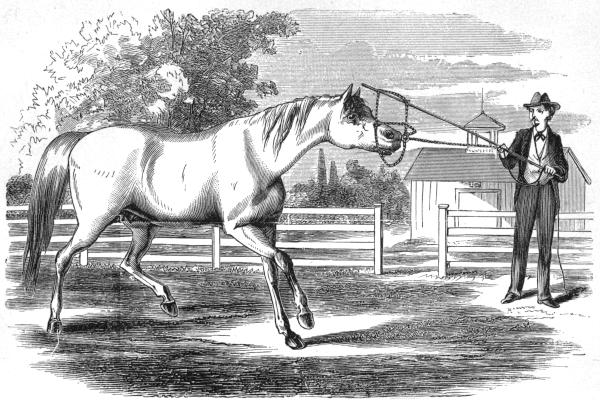
NEW METHOD OF HALTERING A VICIOUS OR WILD COLT.
Having directed my attention for many years to compiling a system of educating the horse, and traveling over twenty-five States of the Union, together with nearly all the cities and towns in the Provinces of Ontario and Quebec, during the past eight years, it is highly probable that few, if any, men are better prepared to impart instruction or to give direction with regard to the management of the horse than myself. Therefore, without being egotistic, or overrating my ability, I can but say that, if the reader will adopt the various ideas found in my work relating to the colt alone, he will have gained knowledge sufficient to more than repay him for the amount paid for the book.
I deem it advisable to give special directions to those who raise colts, not only as to their[162] manner of treatment and education, but, knowing full well the difficulty sometimes attending the first haltering of wild colts, I have prepared the foregoing plate as illustrative of my method, and now proceed to give directions which, if strictly followed, will insure success.
Take a pole about ten feet long; drive a nail near the end, then drive another about fifteen inches from it; now take a rope halter, and hang the part that goes on the top of the head on these nails; then enlarge the nose-piece, by means of the slip-noose, sufficiently to allow it to slip on easily, observing to hold the halter stale in your hands with the pole; approach your colt with great care, and allow him to smell of the halter, and, in a few minutes, he will yield to your advances, and allow you to place the halter on him without much difficulty. Make the shank or stale of the halter about three times the ordinary length, for, as soon as he finds himself caught, he will use his best exertions to get away from you.
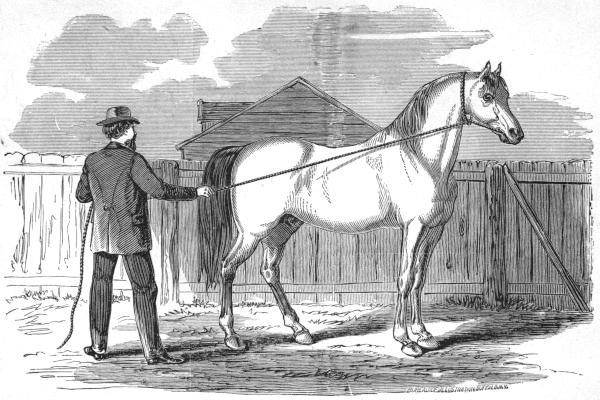
TO EDUCATE THE HORSE TO THE WORDS “COME HERE.”
Place a Camanche bridle on the horse, made as follows: take a small cord about sixteen feet long, tie the end around the neck firmly, so that it cannot slip; then double your cord, placing it under the neck, from, the shoulder to the mouth; step back at the side of your horse, and say “Come here;” at the same time give him a sharp jerk, and he will swing around to you; when he comes, caress him with your hand on the shoulder; now repeat the same on opposite side, remembering to caress each time; do this four or five times, and you will find that your horse will obey and fully understand the words “come here.” Always speak the words with a distinct and commanding tone of voice.
I desire that the reader may understand that obedience in the horse is accomplished by pain; so, when you inflict pain, accompanied by a word, the horse is made to understand that the words[166] mean pain; and, rather than suffer pain, he cheerfully obeys the word.
Persons have practiced the foregoing idea and succeeded in accomplishing their purpose and have, no doubt, been highly gratified that their horse was so intelligent, yielding a quiet obedience to their efforts in a very short time; now had the owner known that a foundation for a complete education was properly laid, how easily could he have built a superstructure thereon that would have been permanent and beneficial during the life of the animal. Men are often conceited and think that because they have experienced no difficulty in the past in breaking and handling their horses, therefore all will be sunshine in the future. I would advise a careful perusal of my work, and, by so doing, those of the character above described will have their conceit supplanted as they gain the knowledge of a practical system of properly educating the horse.

HOW TO LAY A HORSE DOWN.
Place a rope or rein around the horse’s body, forming a surcingle; pass the other end under the tail and bring it back, tying it to the part around the body, thus forming a surcingle and crooper; also put a ring, say an inch in diameter, in the surcingle on the back; then strap up the nigh fore-leg as follows: take a quarter-strap, pass it two or three times around below the fetlock, then through the keeper; bring the leg up and buckle close to the belly; place around the neck a quarter-inch strong rope, loosely, fixing the knot so it will not slip; bring the end down the near side of the head, through the mouth, and back on the off-side through the ring in the surcingle; now take a position on the nigh-side of the horse, commencing to pull gently, allowing him to struggle a short time, after which he will lie down quite easily, without sustaining any injury.
By adhering strictly to the instructions given, every person will readily see, that the object in laying the horse down is to give him to understand that you are master; and, after repeating this two or three times, he will be perfectly satisfied of the fact. While down, place a small pole between his legs, moving it about; if he shows fear or resists, give him a sharp pull on the cord in his mouth by way of correction. In other words, punish him for doing wrong, and caress him for doing right, thus making him understand the difference between right and wrong.
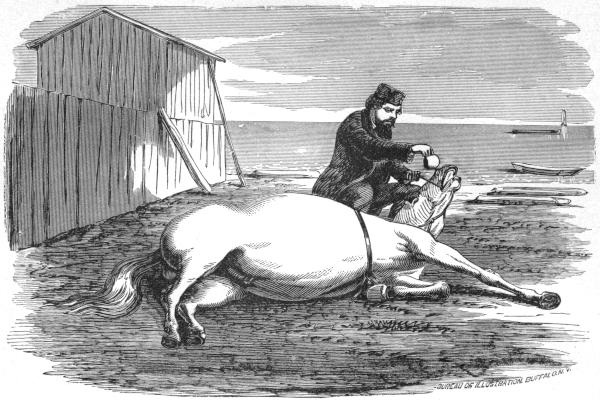
HOW TO GET A HORSE UP THAT THROWS HIMSELF.
Animals are often sulky, and quickly acquire the habit of lying down. Balky horses, when urged to go, will lie down and refuse to get up, and an ox will sometimes lie down in the furrow when before the plough. When the habit is thoroughly settled, it becomes very annoying to the owner or driver, who often resorts to severe means, but fails to accomplish the end desired; therefore, to prevent violence and ill-treatment, I give the easy and simple remedy subjoined, which, when adopted, will be found to be practical and never-failing:
Raise the animal’s head up, as illustrated in the foregoing plate, and pour into his nostril a small quantity of water, not to exceed a pint, from a pitcher or cup, and you will be amused by the pleasing result: the animal will rise to his feet as quickly as it is possible for him to do so;[174] he believes himself to be drowning, and will extricate himself with all speed.
Simple as is this expedient, it is yet unfailing in its efficacy; and that which most commends it to the acceptance of kind-hearted men is the absence of all cruelty in its application. No pain is caused, but the unusual sensation, together with the necessity for air on the part of the horse, banishes his former feeling of sulkiness or anger and the yields to the almost irresistible impulse to spring to his feet and free his nostrils of the water.
If any one who has never applied this remedy should doubt its power, he only needs to try the experiment in a mild way on himself, when he will realize its power upon the horse.
I believe it would be impossible to devise another method so free from pain, so harmless to the horse, and yet so thoroughly efficacious as is the one we have here given.
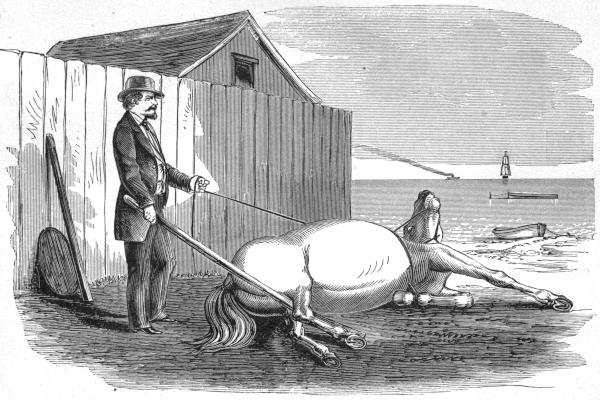
TO EDUCATE A COLT NOT TO BE AFRAID OF HIS HEELS.
Too much importance cannot be attached to the manner of educating a horse’s heels, as it is in that point his greatest means of defense and resistance lies, and most men make the mistake of breaking one end of the horse, while they allow his hind parts to go uneducated. The instructions I am about to give will, if properly followed, insure success.
After laying your colt down, commence to handle his hind parts and heels, being careful to hold the cord firmly in your left hand, so that, if he attempts to get up, you can control him; then strike him gently with a stick, and, if he should show fear, which he naturally will, punish him in the mouth; then place the stick between his legs and commence moving it around, and, if he makes no resistance, remember to caress him; almost as much is accomplished by caressing as by punishing.
The above instruction is equally applicable to a kicking horse, but in his education he will require more lessons before the habit will be entirely removed; still, kindness and a little patience will soon accomplish all you desire.
Men in general exercise too little patience in the training of their colts, and they frequently expect to accomplish more in a short space of time than can possibly be performed. Yet the time really required, when measured by days, is so short as to be really surprising. Let us suppose that in training a colt one were to spend two hours a day for ten days, which is the longest time that could possibly be needed; compute the time at ten hours to the day, and the whole amounts to but two days, at the end of which he would have a well-educated animal. I doubt if a farmer or horse-raiser could employ his time more profitably in any other way than in thoroughly educating his colts, as he thus enhances their value, for there is no sensible man who would not give ten dollars more for a properly educated animal than for one improperly trained.
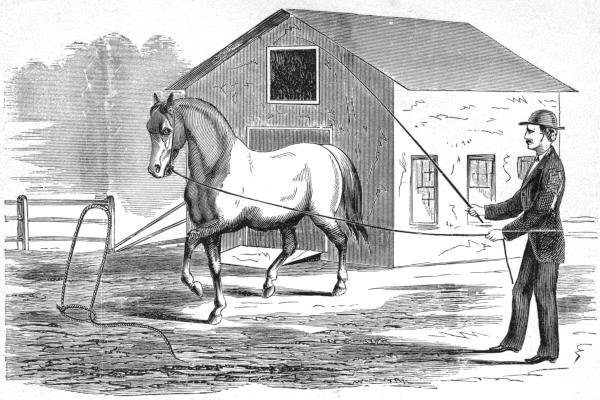
TO EDUCATE A COLT TO DRIVE BEFORE BEING HARNESSED.
Place on him the Bonaparte bridle, as shown in engraving, with your cord in the left hand and whip in the right; the cord referred to should be about eighteen feet long; now drive him around a circle to the right about fifteen minutes; then drive him to the left about the same time. You have now educated your colt to drive, and may with safety put on your harness, observing to put the reins through the shaft tugs at his side; then commence driving him carefully for some fifteen minutes on a walk, turning him to the right and left as before directed. Do not use the whip more than sufficient to give him a knowledge of its use. Never drive a colt without blinders. It is better to first hitch him to a sulky or a cart, and do not put on breechings, but allow the cross-bar frequently to come against his heels, so that he may never be afraid, or learn to kick. Never forget, when your colt is obedient, to stop him, and walk up to and caress him.
I am unwilling to pass on to another illustration without more fully impressing on the minds of those who raise or break colts the necessity of kind and careful usage in educating their animals. Never approach your colt quickly. Never, pull the halter or bridle off quickly. Always handle the colt’s ears with great care. Never punish him on the body with anything but a whip, and with it as seldom as possible, as many colts become sulky and show signs of balking when severely whipped. It is better that you should give your colt two or three lessons each day, as heretofore directed, at intervals of say two hours apart: by this means you do not overtax his brain, nor cause him to get weary. In this, as in many other cases, the wisest course is to “make haste slowly.”
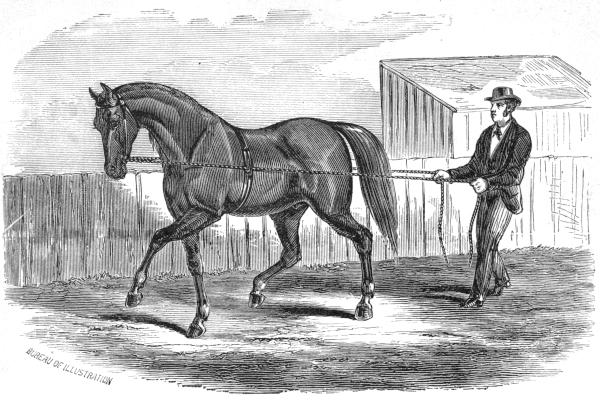
TO EDUCATE A COLT TO MOVE HIS BODY WHEN HE MOVES HIS HEAD.
Place on your bridle, then your harness; carry your reins through the shaft tugs; take your position behind the horse (see engraving); now commence to drive, turning him round frequently, first to the right, then to the left, and he will quickly understand to move his body when he moves his head. By this means you are educating to the shafts, and educating not to be afraid of his heels, thus thoroughly breaking your horse at both sides and both ends.
After your colt has been driven two or three times, as above described, educate him to obey the word “whoa:” let him walk along smartly, then speak plain, with audible voice, and say “whoa;” at the same time pull on the reins with some force; when he stops, caress him; repeat this a few times, and, in the short space of fifteen minutes, you will have taught him the use of the word. Now your horse is educated to drive and stop at the word of command.
The next thing in order is to teach him to back. To accomplish this, grasp your reins firmly, and with a determined effort; speak firmly, making use of the word “back,” at the same time pulling with all your might; if he obeys the first time, step up and caress him; if not, increase the power by inviting one or more of your friends to assist on the reins, being fully determined to accomplish your purpose. As soon as he obeys, don’t fail to caress him, and by this process you will educate your horse to the word, which he will never forget.
Your colt being educated, you may now hitch him up to a vehicle, observing to drive him very slow, only on a walk, and after thus driving him a few times, you can with certainty say that you have a thoroughly educated horse, whose value will be greatly increased, compared with the old or any other system of breaking the colt. Always observing to drive your colt with blinders, only using the whip enough to let him know the use of it. Be kind to your animal, never using harsh means, and he will reward your kindness by implicit obedience.
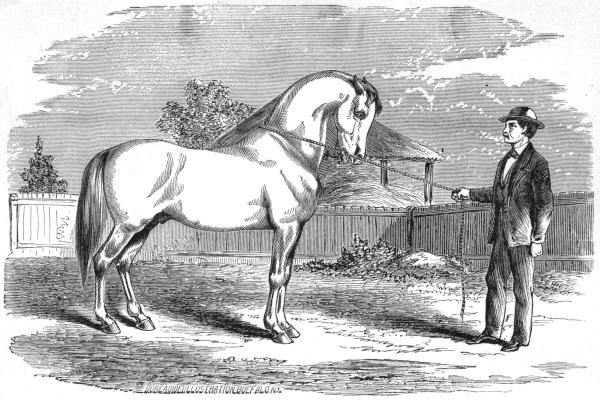
IMPROVED METHOD OF BITTING A COLT.
Use the Bonaparte bridle, placing a loop on the lower jaw; carry the cord back on the neck, bringing the end of the cord down through the loop on the jaw; then draw the horse’s head up in an easy and graceful position, and tie a bow-knot. Should the horse attempt to rear and go over backwards, give a little pull to untie the cord, and the horse is saved from any accident. The object aimed at in bitting a horse is to give an easy position, with a high and graceful carriage of the head, and, in our efforts to do this, we must be careful not to give him a dead bearing on the bit, or make him what is usually known as a “lugger.” All the bitting rings which we have examined, and especially those of English make, are objectionable, as having a tendency to produce this result. The rig which we here give you is entirely free from this objection, and is better calculated to produce the desired result of ease and gracefulness than any ever before[190] presented to the public. Our rig, instead of bearing on the jaw-bones whenever the horse presses his weight upon the bit, producing a calloused jaw and indifference to the bit, contracts the side muscles of the cheek on the molar teeth, with a pain the horse cannot endure; he lifts his head, the bit falls on the side rein, and the mouth is at once relieved. Practice has shown that horses bitted with this rig soon acquire the habit of gently and gracefully raising the head with that occasional toss, or upward and downward motion, and playing with the bit, which is the perfection of beauty in a carriage horse, while standing in the harness.
It is not possible for a horse with our rig to become a “lugger.” This bit never bears upon the jaw-bone with more than a light pressure, and when he attempts to rest his head upon the bit, the pressure on the teeth causes him to desist and elevate his head. He soon dreads to rest upon the bit, and of his own free will, without the force of the rein, carries it up with freedom and ease.
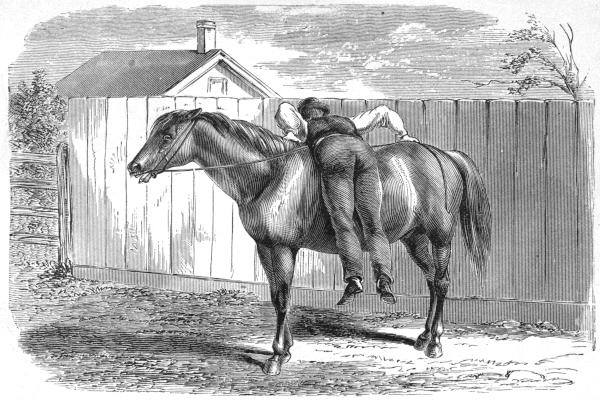
EDUCATING THE COLT TO RIDE.
First put on the Bonaparte bridle, make a double half-hitch, bringing it over the head, back of his ears, and, carrying it down to the mouth, place it under the upper lip, taking the end of the cord in your right hand, placing it on the horse’s rump; then place your left hand in the mane; now spring partly on and off, as seen in the plate on preceding page. Do this several times; if he moves, punish him in the mouth, by means of the cord; if he does not move, when you get off caress him; then go to the opposite side, repeating the same several times, after which you may safely mount your horse, but be particular not to remain on his back too long at a time, as the strength of the animal is not yet sufficiently developed to bear a protracted strain. Like the young of all animals, the colt has a great deal of energy and spirit, but lacks the stamina to endure long-continued exertion, nor can it be imposed on them without certain injury.
Men do not act wisely by practicing the old system of riding colts, viz., by mounting on the back with reins and whip in hand, and, so soon as the colt jumps about or rears, applying the whip or heels; for the reason that the animal does not know what you require of him, but believes you design some injury, and therefore resists your efforts to ride him. No wonder that he repeatedly throws his rider and treats him as an intruder. He cannot be less terrified than a man would be if a wild animal were to mount on his back. In order to secure success in educating his colt to ride let the reader adopt the foregoing instructions, and he will not have cause for regret, but will find that he has gained more than the single point of riding, as he has taught his colt that he does not intend to harm him, and that his duty is to yield a cheerful obedience to his owner’s commands.
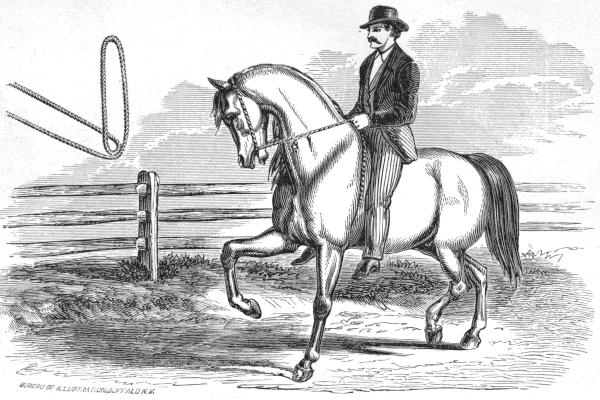
INSTRUCTIONS TO RIDE THE COLT.
Take a small cord, ten to twelve feet long, divide it in the center; then place the center back of the ears, cross it in the mouth, then bring both ends along the neck to the withers, and tie a knot, thus forming a powerful bridle, sufficient to ride the most vicious animal.
Sacred history contains the declaration that there is “the bridle for the horse, the whip for the ass, and the rod for the fool’s back,” and, while writing my book, I have often thought of the first portion of that quotation. The power of the bridle in controlling the horse is really wonderful, and the new forms of powerful bridles given in this work enable the most timid rider to secure the mastery of the most powerful animal. The one described above is excellent, and can never fail to give satisfaction when it is used as directed.
There is no exercise so invigorating and scarcely any so delightful as the manly one of riding the horse, yet three-quarters of the pleasure of[198] equestrianism depends on the early training of the horse for this delightful exercise. The rider who feels that he has beneath him an animal obedient to his slightest wish, and which responds to a touch of the heel or the lightest pressure of the bit, moving to the lifting or the falling of the bridle, such a rider feels almost as though the horse on which he sits forms a portion of himself, and courses onward with a delightful sense of power and freedom. Nearly all of this excellence in a riding-horse depends on the way in which he has been educated while young. Faults then acquired may be corrected, it is true, in later years, yet it is far more desirable that they should never have been formed, but, in place thereof, the qualities secured which form the excellence of a horse.
I throw out these suggestions at this point, for I am now dealing with the early education of the colt; later in the book I shall have to speak more of faults to be corrected, and it is my wish to impress on my reader the great importance of the kind of education which the colt receives at his hands.

TO HALTER-BREAK AND HITCH A COLT IN THE STALL.
Place the center of a sixteen-foot cord under the horse’s tail, and bring it over and cross it on the back; then tie it firmly in front of the breast (as seen by reference to illustration on preceding page); carry the halter-strap through the manger, and bring it back under the mouth; then tie the end of the strap to the cord in front of the breast. The colt is now tied by the head and tail. While he yields quietly to the confinement, he is comfortable and easy, but the moment he begins to resist he punishes himself; this he soon learns, and in a little time ceases the efforts which he finds to be productive of pain. He will always remember the lesson, and give no further trouble.
It may seem a trifling thing to have gained the result described above; yet, as the earth is made up of grains of sand, so the thorough education of the horse is the result of attention[202] to a multitude of small affairs, each one seeming to be of little importance in itself, but which, in their total, make the difference between a gentle and an unruly animal.
Too much care and attention cannot be bestowed on the colt while you are giving him lesson after lesson, as he is susceptible of impressions that will take weeks to overcome, provided you should through neglect or carelessness omit to practice the instructions laid down. Do not suppose that any of the directions given in this book are unimportant. They are, one and all, the result of long experience in the management and education of the horse, and each one, in its place and relation to the general system, is as necessary, though perhaps not as important, as any other. To be certain of reaching the best results of the system, the reader must not pass over any of our directions as unimportant or unnecessary, but accept each as a part of the system which it has required years of time and thought to bring to its present state of perfection.
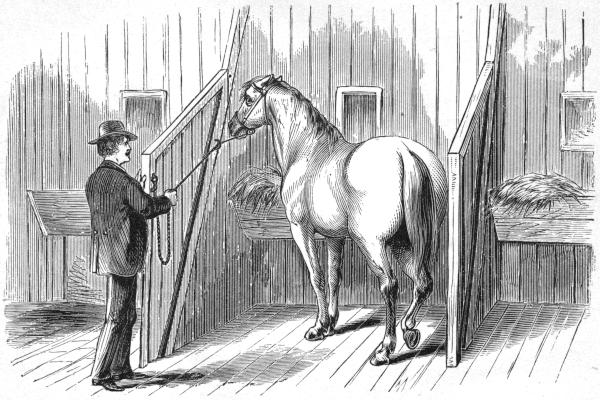
TO EDUCATE A HORSE NOT TO KICK AT YOU WHEN ENTERING THE STALL.
Place on the horse the Bonaparte bridle; then drive a staple at the side of the stall, near the manger, three or four feet from the floor; then attach another staple at the entrance of the stall, the same distance from the floor; now pass the cord through both staples and tie it. When you enter the stall, pull sharply on the rope; at the same time use the words “go over.” The head of the horse will be drawn towards you, and his heels to the opposite side. Thus you avoid all danger, and will very soon educate your horse to abandon this bad habit.
Vicious and annoying habits in horses often owe their origin to bad management by their owner or groom. Allow me to instance a few examples: A man walks into the stable and approaches his horse in the stall, and, if he should move about quickly, the person springs back from him, evidently showing his fear, which[206] is at once noticed by the horse, and taken advantage of; so that, after a repetition of this two or three times, the animal fancies he is master, and uses his heels to help the intruder out of the stall. Another custom prevails: that of striking a horse on the rump or hinder parts, with a whip or stick in order to make him stand over, and the effect is to irritate and cause him to kick. Now, in order to insure success, walk up to your animal manfully and determinately, observing never to show fear, and by this means you will never teach your horse to kick at you.
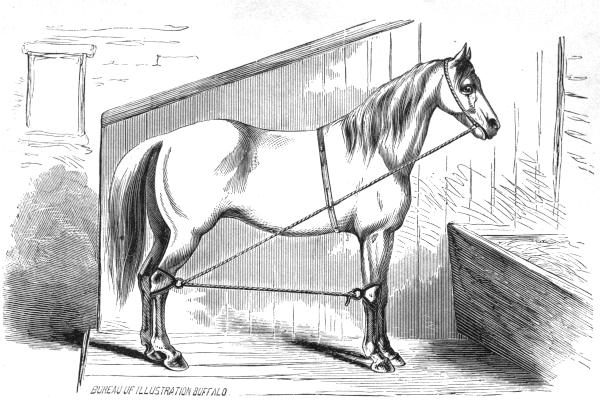
TO EDUCATE A HORSE THAT KICKS OR PAWS IN THE STALL.
First make the Bonaparte bridle, as before directed; carry the cord through a surcingle, attached around the body, back to a ring in front of the hind-leg, to which are attached two straps, one above and one below the gambol joint of the leg he has the habit of kicking with; thus, when he kicks, he is punished in the act, and soon gives up the habit. Pawing—Continue the cord forward to a ring attached to two small straps above and below the knee-joint, as seen on engraving, observing, as above directed, to attach the appliance to the leg he paws with, reversing the straps when required, which will give a horse the knowledge that when he paws he punishes himself, and the reader will see, by this treatment, the habit speedily broken up.
The habit of kicking in the stall is one that is not only disagreeable to the owner of the horse addicted to it, but is often destructive and costly,[210] as a horse viciously inclined to that habit will sometimes even splinter the boards of the stall, and with so simple and effective a method of correcting the bad habit it should never be tolerated for a single day, and the possessor of this book would be inexcusable should he suffer it to continue in an animal owned by him.
The habit of pawing in the stall, though not so vicious in its nature as that of kicking, is yet sufficiently troublesome and unpleasant to deserve a speedy correction, and the owner of a horse addicted to even the last-named fault will be more than compensated for the slight trouble caused in its removal.
It may seem needless to repeat what has before been said, in substance, that the seemingly small faults of a horse are the ones which most frequently lessen his value and impair his usefulness, and that the removal of any one, however trifling, adds a money value to the horse more than sufficient to compensate for the time and trouble expended.
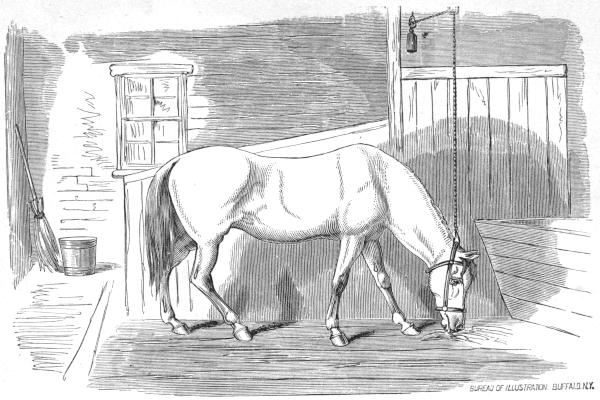
TO PREVENT A HORSE GETTING CAST IN THE STALL.
Drive a staple in the ceiling over the manger at the side of the stall, then another in the ceiling in the center of the stall over the horse’s head; pass a small cord through the staple at the side of the stall; tie a horseshoe, or the weight of a horseshoe, so that the cord will not draw through the staple; then put the cord through the staple in the center of the stall, bring it down within two and a half feet of the floor, and cut it off, attaching a snap to the end; place a ring in the halter at the top of the head, in the center, as seen in engraving. Now, when his head raises up, the weight comes down; when his mouth is on the floor he can lie down with ease, but he cannot get the top of his head to the floor; and, if he cannot get the top of his head to the floor, he cannot roll; and, if he cannot roll, he cannot get cast. This remedy is as simple as it is certain, and is always perfectly safe.
The habit of rolling in the stable is one often attended with fatal results, in addition to the anxiety experienced by the owner of the horse. Various means are resorted to in order to prevent the animal getting cast, and most of them are wide of the mark; and, in order to acquaint the reader with the variety of ways practiced, so that he may contrast the difference between others and mine, I have thought proper to write more explicitly on the subject.
A favorite idea with many is to tie the halter so short that the animal cannot get his mouth near the floor; this renders the horse uncomfortable, as he cannot lie down when he desires. Another is, hitching the halter-stale at the ceiling directly over the head of the animal, and allowing cord enough that he may get his mouth on the floor; this, too, is attended with bad results, for when he raises his head up there is sufficient slack in the rope so as to permit his getting his foot over the rope and become so entangled as to render his position dangerous.
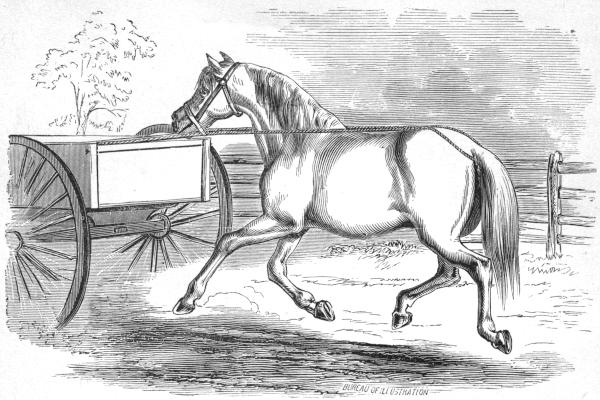
TO EDUCATE A COLT TO LEAD BEHIND A WAGON.
First put on the colt a common halter without a leader, then place a small cord about eighteen feet long, divided in the center, under the tail, cross it on the back, then bring the ends through between the under-jaw of the horse and the nose-piece of the halter, and tie it to the hind end of the wagon. This idea will be satisfactory, and your colt will soon be educated to lead without trouble to his owner. The expedient is a very simple one, yet will invariably prove successful, because the colt will find his own comfort to be promoted by doing as you wish; and this is one of the principles which underlie my whole system of training—to make the horse desire to do that which his owner wishes.
Under this head I am satisfied that I cannot be too particular in giving instructions, as persons often grow merry when witnessing the results produced from ideas that are so different[218] from their old and accustomed ones, practiced for leading colts. After you have hitched your colt in the manner described, do not start off immediately, but let him remain as quiet as possible for a few minutes, then start the wagon slowly, and, if your colt attempts to rear or plunge about, stop your vehicle, get out and walk up quietly to your colt and caress him, and when you start him again, if possible, walk along by his side for a short time, then stop him again, and again caress. His attention will not be attracted by objects on the road, but very soon he will understand that his chief business is to walk on quietly away from the punishment inflicted from the cord under his tail.
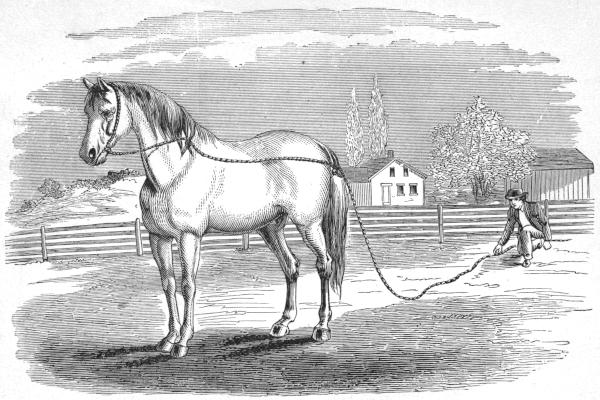
TO EDUCATE A HORSE THAT IS BAD TO CATCH.
Horses acquire this habit mainly from improperly turning them out; and, to illustrate, I will give the reader an example. First, the man or boy takes his horse to the bars or fence of the field, and lets only a portion of either down; he now takes off the bridle or halter, and, in order to make the horse jump over, hits him on the rump and shouts at him; thus the animal is made to fear the approach of man when loose; so that, with this kind of training, it soon becomes difficult to catch, and requires education in order to counteract this bad habit.
Directions: Put on the Bonaparte bridle, and tie a knot at the mouth, so as to prevent it from slipping down to his teeth, when he might sever the cord; then carry it up to his mane over the shoulder; tie the mane together with a string; then pass the cord through the loop thus made[222] with the mane, and carry the cord through a loop made in the tail by same means, and let your cord lay out behind from ten to fifty feet, as required. Now, when you want your horse, go carefully up behind him and take a firm hold of the cord, and say “Come here,” at the same time pulling with all your might. By giving him three or four lessons of this kind, you may safely take off the cord and go into the field, standing about the same distance as when you last pulled or the cord, and repeat the words “come here;” he will quickly obey your voice, and give you no more trouble in catching him.
When it is remembered how much time is often lost in catching a horse in the field, it will be seen that, in money value, this simple point of horse education will more than repay the cost of this book to the owner of a horse that has heretofore been bad to catch; and the saving of temper as well as time will make the improvement in his habits doubly valuable. Both the man and the horse are made better by it.
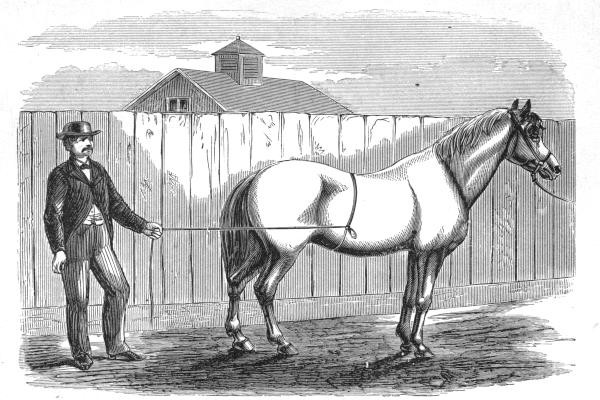
TO EDUCATE A HORSE NOT TO REAR UNDER THE SADDLE OR BEFORE A CARRIAGE.
Attach a small cord tightly around the swell of the body, tied with a loop-knot, and carry it back into the carriage. By doing this you prevent your horse from rearing, inasmuch as he is unable to expand his body, and, without doing so, it is impossible for him to rear. Simple as is this method, the reader, if he should have occasion to practice it, will find the idea of great value, as it will never fail to prove effectual in removing this, to say the least, unpleasant and often dangerous habit. It is possible that the habit might be broken up in other ways, but there are none so harmless and easy of application as is the one I have described.
My readers will, I doubt not, receive with kindly feelings not only the instructions on the important points of educating their horses to break off bad habits, but will profit by the ideas[226] and examples given of the various means adopted by horse-handlers to create these habits. In the present instance, it is rarely, if ever, known that horses acquire the habit of rearing themselves, but are prompted so to do by the means used, viz., starting and stopping suddenly; pulling sharply on the reins, and then striking the animal with the whip, either of which is a sure and certain means of producing this result—that of causing the horse to rear up whenever you desire to move off.
The inconvenience and unpleasantness of such a habit are too plain to need more than a mention, besides its often occasioning great alarm to a timid driver; and the simple yet practical means I have given for breaking up the habit, will be found successful whenever it is tried, as it always should be where the habit exists.
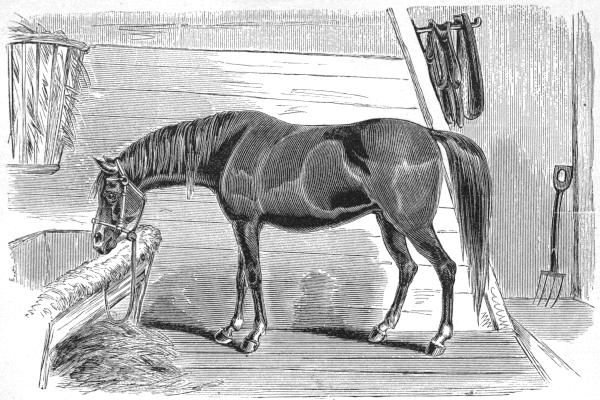
TO EDUCATE AND PREVENT A HORSE FROM CRIBBING.
Build a manger on the floor or from the floor up. In many cases this will prevent a horse from cribbing by getting his mouth below his chest.
Another method, sure to be effective, is to place a piece of sheep-skin of long wool, eight inches wide and about three feet long, or long enough to reach from one side of the stall to the other, and on the skin sprinkle cayenne pepper; take soft soap and rub it on any part of the stall where the horse will be likely to crib. If the above instructions are strictly adhered to, and the horse is fed regularly, three times a day, there will be little danger of his ever becoming a cribber. The slight trouble which this remedy involves will be repaid a hundred-fold by the satisfaction felt in the prevention or cure of a most disagreeable habit, and one which, like every other fault, lessens the value of a horse. In using the cayenne pepper, a small quantity will be sufficient.
There are more bad results accruing from cribbing than many are aware of. From cribbing the horse may become a crib-sucker, which often results in colic, or, as it is sometimes termed, belly-ache. When this occurs of course it becomes a dangerous habit, and no one should think it too much trouble to adopt the instructions given under this head. Do not think you can eradicate this habit by nailing tin or iron over the manger; you cannot remove it thus; your horse may desist for the time being, but when put into a stall that is not thus arranged, he will relapse into his old habit; but by adopting the remedy I have provided he will be thoroughly taught not to attempt to bite or gnaw the manger.
There is a wide difference between preventing a horse from doing what he still wishes to do, and taking from him the disposition to do wrong; the latter alone can properly be called education, and is the only way in which a bad habit can be permanently removed. On this principle I base my whole system; it is education, by appealing to the intelligence of the horse.
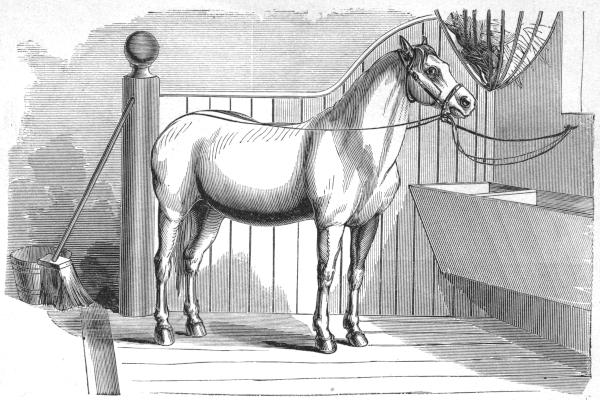
TO EDUCATE AND BREAK A HALTER-PULLER.
Place on the horse a common halter, without tie-strap; then take a small cord, about 16 to 18 feet long; divide it on the center, place it under the tail and cross it on the back; bring the ends each side of the neck, then place the ends through the halter under the mouth; tie round a post or tree. Then tie a strap from the mouth to the post or tree one foot shorter than the rope, after making it taut from the tail; then cut the strap half off, after which, frighten your horse by rolling a barrel in front of him; now he will fly back, breaking the strap, and he will be caught under the tail, which is a severe punishment that will, by repeating it two or three times, educate him not to pull at the halter again.
The practical nature of the idea embraced in the foregoing directions will be seen at a glance,[234] for the following reason: the horse has from time to time been guilty of pulling on his halter and breaking it, much to the displeasure of the owner, but probably much to the gratification of the horse, who, perhaps, has come to take a sort of pleasure in the act; now he is made to repeat the same thing, unconscious of the result that will follow, when immediately on carrying out his old habit he receives a severe punishment inflicted by the very act. The horse is, no doubt, surprised, but he quickly learns to connect the act and the suffering in his mind, and so soon as he does that the habit is cured forever. This I claim as a great excellence in my system, that its results are all permanent; the cure is not for a day only, but for all time; the very disposition to do wrong is wiped out of the animal’s brain.
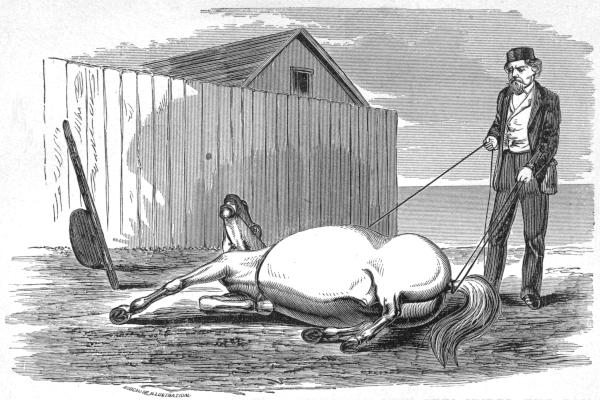
TO EDUCATE A HORSE NOT TO KICK WHEN THE LINE GETS UNDER THE TAIL.
Horses become kickers from various causes, and one most effectual in producing the habit, is that when a horse gets the rein under his tail, his driver, getting provoked, pulls strongly on the rein in order to liberate it, and by this means burns the skin beneath the tail, when the horse becomes excited and commences to kick. The driver then usually begins to whip, and oftentimes the horse continues to kick, until he breaks everything within reach of his heels, and runs away. Now the owner has a confirmed kicker, and frequently knows not what to do to correct the fault he has himself established. The instructions below, if properly applied, will effect a cure.
When your horse is down, as seen in the engraving, place a strap under his tail and commence moving it up and down; should he kick, or show signs of resistance, at once punish him; if not,[238] caress him, and in a short time his tail will become limber and he will be taught to not be afraid, though, in driving, the rein should get under his tail. Also, after you allow him to rise to his feet, use the same means as just directed when he was lying down.
In my book I have endeavored to grapple with almost every bad habit that the horse is addicted to, and would here advise all persons who handle them to be extremely careful that if their animals acquire unpleasant habits, they are not mostly to be blamed themselves. Horses differ materially in their ability to learn, and many are less susceptible of impressions than others, therefore, it behooves the educator to first make himself acquainted with the disposition of his horse, and treat him accordingly, as the same line of management will not serve for all, but an observance of one important direction, that of always using the utmost kindness, will, in most cases, prevent and remove all habits but those of long standing.
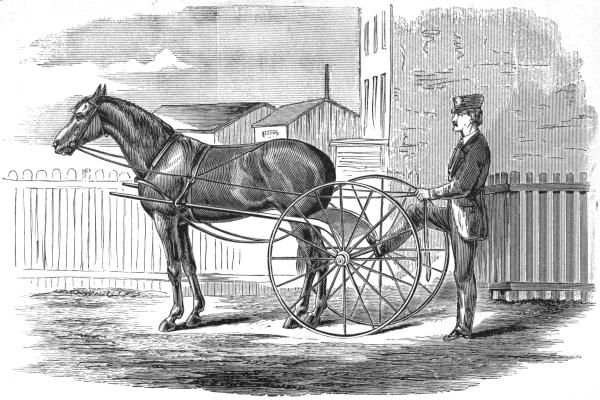
ANOTHER METHOD OF EDUCATING A KICKING HORSE.
I design to make this chapter as plain as possible, so that no man need fail to break up this worst of habits, and in order so to do, I will commence at the beginning. With the previously-described rig, lay the horse down, and commence to handle him. Take a stick or a piece of board and ply it on his hinder parts, then thrust it between his legs. Should he kick, punish in the mouth with Camanche bridle, but if he offers no resistance, caress. When you have secured submission allow your horse to rise to his feet, then put on him a head-stall and lines and commence driving him on the walk; every three or four rods pull sharply on the reins and at the same instant say “Whoa,” walk up and caress; start him off again, and repeat the[242] “Whoa,” say ten times, by that time you have so educated him to the word that he will scarcely forget it for years. Take your stick and ply it on his hind parts again; if he resists, jerk suddenly on the reins and say “Whoa.” Ply the stick until all fear is removed. You can now safely hitch your animal to a cart, as seen in engraving, using no breeching. Drive him a short time, simultaneously pull on the reins and say “Whoa,” at the same time allowing the cart to come against his heels. Push the cart sharply against him, saying “Whoa,” each time, speaking with considerable force, that he may understand you design to conquer. Don’t forget to caress when the horse obeys. Should he kick the cart and try to rid himself of it, pull with your might quickly on the reins and repeat the word “whoa” again; so soon as he shall desist take him from the cart and lay him down again as soon as possible, and, if need be, summon one of your neighbors to assist you, to prevent being foiled, for[243] be assured, if you allow him to conquer once you have lost much and really accomplished nothing. Give the animal another strong lesson while down, afterwards repeat it when on his feet, when by this time you will have taken the conceit completely out of him. In all your attempts to handle a vicious horse be resolute and determined and you will soon give him to understand that you are master, and that his duty is to yield a cheerful obedience to your command.
I would enjoin upon the reader to practice the same method when educating colts, but not so severely, because by so doing you may make them stubborn; great patience must be exercised while handling colts, as the faults of one misplaced lesson will be visible. Therefore one cannot be too careful, particularly if the animal is nervous and excitable.
Cut the horn well down, but not to the quick, fit the shoe so that it will not press upon the part, then saturate well with pine sap or gum, which is found exuding from pine trees when cut. Fill the part in nicely with tow, and put on the shoe, which must be so fitted as not to oblige the part to support, but very slightly, if any, the weight of the horse. Horses with corns must be oftener and more carefully shod than those free from them.
Place the bits in the animal’s mouth as low as possible, not to have them drop out, and drive him from two to three weeks with the bits in this way, and when they are buckled up in proper place he is hard-mouthed.
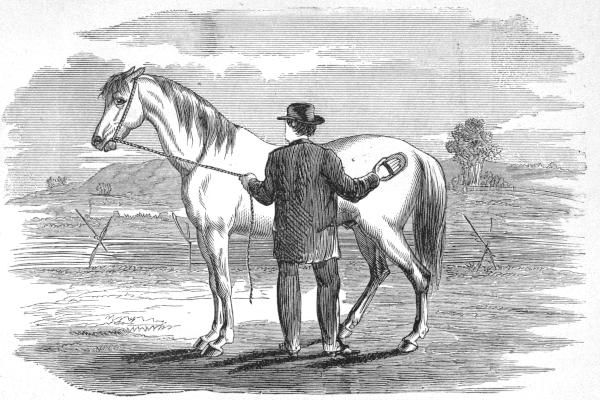
TO EDUCATE THE HORSE BAD TO GROOM.
After making the Bonaparte bridle, put it on the horse, standing at his side with the end of the cord in your hand, with the other hand use the curry-comb or brush and commence to groom him. If he should resist your efforts by attempting to kick or bite you, reprove him by pulling quickly on the cord, at the same time using the words “stand still.” Afterwards if he remains quiet, caress him; if the punishment should not prove effectual make the double half-hitch under the upper lip, as seen in engraving.
This is a great annoyance to the other horse, and he will probably learn to do the same thing, not from imitation, but from leaning inwards, so as to enable him to stand against the other horse, leaning upon him. This habit may be broken up by securing a piece of sole leather to the pole upon the side where the animal leans, having a number of tacks driven through it in such a manner as to protrude from the leather towards the horse.
Buckle a pair of straps, about twelve inches long, with a ring at one end, and a buckle at the other, to the check-piece, and let the straps pass through the rings on either side of the bit; buckle the lines to the rings on these straps, instead of the rings on the bit; this forms a gag similar to the French twitch-gag, and is a powerful means of controlling the mouth of a hard-pulling horse.
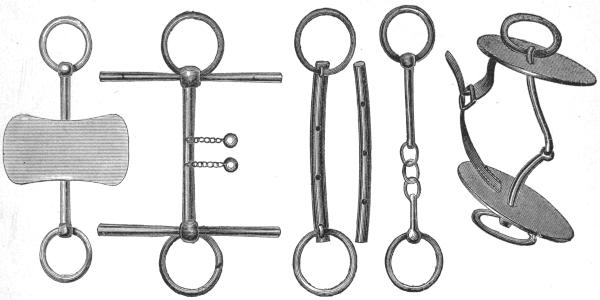
BITS USED IN EDUCATING HORSES ADDICTED TO BAD HABITS.
No. 1. To prevent a Horse getting his Tongue over the Bit.—Take a piece of leather, say three inches long, an inch and a half wide, and drill two holes in a straight bit; now rivet this leather on the top of the bit, after which sprinkle on the upper side some pulverized rosin, and take a hot iron and pass over it so as to form a coating. Allow your horse to wear this bit say six or eight days when driving, and he will by that time be sufficiently taught to abandon the habit.
No. 2. Lolling the Tongue.—Take an ordinary straight bit of five-eighths of an inch in diameter and drill two holes, each one three-quarters of an inch from the center; then get a piece of very small chain, attach iron bullets,[252] about the size of ordinary leaden bullets used in guns, suspend them not more than one and a half inches from the bit. Now use the bit, every time you drive your horse, for ten days.
No. 3. Cure a Horse of Sucking Wind.—A horse that has acquired the habit of sucking wind is truly to be detested, as it is oftentimes attended with fatal results, and when once thoroughly settled, great difficulty has been experienced in removing the habit. The method I have introduced of treating this habit has proved successful in most cases.
Take a piece of small gas-pipe, say from five-eighths to three-quarters of an inch in diameter, the ordinary length of a bit, heat it and circle it a little, then drill on the upper side equal distances apart from each end, as seen in engraving; also drill three holes on the under side, making each hole between an eighth and a quarter of an[253] inch in diameter, and attach a ring near each end and allow your horse to wear this when driving, say for at least from ten to twenty days or until the habit is removed.
No. 4. To cure a Side-Reiner, one that Pulls heavily on one Rein.—Take a plain, jointed bit, remove one-half of the part used in the mouth and supply a small chain from the side ring to the center joint, now on the side that the animal pulls place the chain; he is not only attracted by the strange sensation in the mouth, but when pulled on the chain side receives such severe and unexpected punishment that he will quickly give up his habit.
No. 5. Dead-Mouth or Jaw Bit.—This bit may be used on horses that pull very much on the reins, and a lady may with safety drive a horse, as she can control him quite easily.
The attachment to this bit is made as follows: Take two pieces of leather about three inches in diameter, make a hole in the center of each to admit of the bit, cut the leather so as to put pieces on after, sew up slit, attach two billets on under side with buckle, then buckle on under jaw. This bit may be used without a head-stall.

TO EDUCATE HORSES NOT TO BE AFRAID OF OBJECTS WHEN DRIVING.
It is impossible to overestimate the value of the subjoined instructions respecting nervous and shying horses, therefore on this topic I wish to be particularly clear and explicit. Let the reader understand that horses take fright at objects because they fancy those objects will harm them, and if you can by any means appeal to the horse’s brain, and satisfy him that he is not going to be hurt, you have accomplished your object, and in order to do so, you must have control of your horse. I do not mean by this that you are to adopt the too frequent course pursued by many, viz., subduing with the whip, or other harsh means, which will, without almost an exception, increase the fear instead of removing the habit; again, when a horse shies, the driver commences to jerk on the rein nearest to the object, and at once applies the whip, fully determined to master his horse; both man and horse get excited, and the horse comes off victorious, because he cannot control him by the means[258] used, and the result is that the next time the animal is frightened it bears a two-fold character, the fear of the object, and the fear of the whip-punishment.
In order to properly educate your horses in this department, I would specially direct the reader to observe and practice the following directions: Select, first, the most prominent objects at which he becomes frightened, then make the Bonaparte bridle of small cord, and place it on your horse under the bridle, carrying the end of the cord into the carriage, and when approaching an object at which he takes fright, get out of your carriage, stand nearly in front of him, give a quick downward pull, and say, “Come here!” At first do not punish him too severely; but if he will not obey, increase the punishment, and so soon as he complies, caress him. Bring him quite near the object, and, if possible, let him smell of it, as by adopting this method he will quickly understand that the object will not hurt him. Now turn him around, and drive him past the object two or three times, and you have accomplished your end.
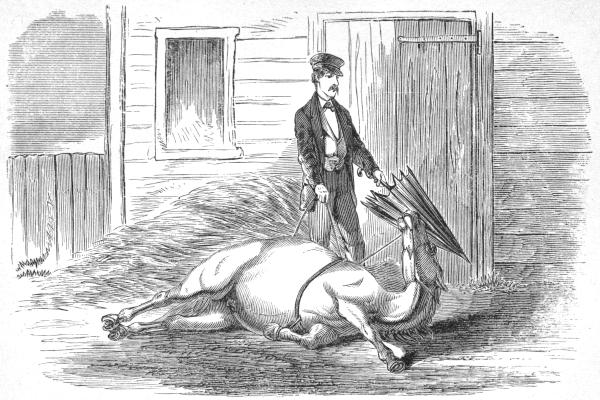
FIRST LESSON TO EDUCATE A HORSE NOT TO FEAR AN UMBRELLA.
Place on the animal the throwing rig and proceed to lay him down, when, should he jump around and show resistance, do not get anxious to throw him quickly, but let him caper about, he will soon give up. After he is down present the umbrella to him folded up, allow him to smell of it, then rub it gently across his nose and head, now open it partly, again let him smell of it, shut it and open it several times until he becomes perfectly reconciled to the appearance, open or shut; work slowly and carefully so as not to excite him more than possible to avoid.
In another part of my book I have illustrated the education of the animal to the umbrella when on his feet, and will not go further on this point than to use the old familiar word, caress.
On no account should the operator, when practicing any idea in my system, forget that success greatly depends upon caressing when the animal obeys.
Horses become unwilling to be bridled from various causes, sometimes from sores on the head or ears, sometimes from hurriedly and improperly removing the bridle, and sometimes from sheer ugliness of disposition, prompted by a desire to be master. The treatment in these cases should be varied. In the latter case named it will be necessary to lay the animal down, and while thus under control, handle his head and ears, after which put your bridle on and off several times, exercising patience and being careful to avoid anything like roughness. Should he resist, punish him in the mouth, using your best judgment to avoid severity, and so soon as he submits caress. As to the former, where a dislike to be bridled arises from abuses, kindness must govern the conduct of the educator. By using my Bonaparte bridle you will be able to control and counteract all predisposition to resist your efforts in a very short time. Should there be sores about the animal’s head, you had better restore to soundness before you attempt to educate to comply with your wishes.
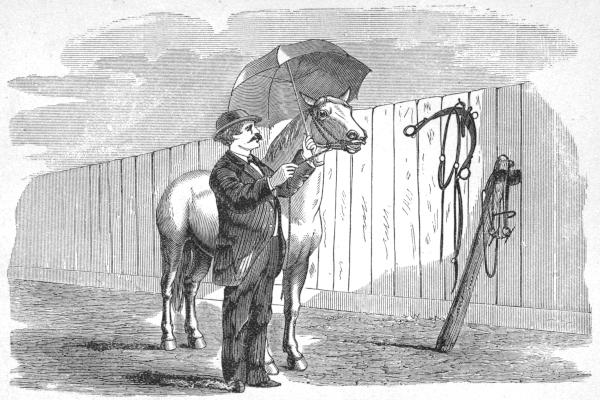
TO EDUCATE A HORSE NOT TO FEAR AN UMBRELLA.
On page 261 may be found the first lesson to educate a horse that fears an umbrella. I now proceed to explain the idea illustrated by the foregoing cut.
Place on the animal the Bonaparte half-hitch bridle—found on page 306. First present to him the umbrella closed; allow him to smell of it, then rub it gently across his nose and body, observing not to move quickly. Should he resist your efforts, jerk on the bridle and say “Whoa!” Make another attempt, and should he remain quiet, caress him. Now partly open it, placing it over his head, observing to avoid touching his head or ears with the umbrella—while doing so, caress; and you will be satisfied punishment in the mouth and caressing will accomplish all that you may desire.
Wounds are caused by accidents of various kinds, when the skin is much torn from the flesh. If you are at hand while the wound is quite fresh, take a square-pointed needle, and a waxed thread, and sew it up. Be sure to put the needle in straight, one side over against the other, draw the skin tight, tie a knot, and cut off the thread; then take another stitch about an inch off, till it is all nicely drawn together. It is quite wrong to sew up a wound as you would a piece of cloth; the thread should be cut after each stitch. When you do not see the wound till the place is growing dead, and the skin is drawing up, then take off the loose skin; for if you permit it to remain, it will leave a blemish.
Oil of spikes, aqua ammonia, and oil of turpentine, of each 2 oz.; sweet oil and oil of amber, of each ½ oz.; oil of origanum, 1 oz. Mix.
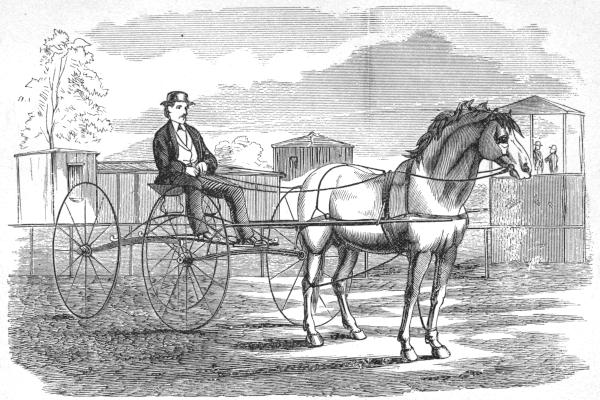
TO EDUCATE A SINGLE-FOOTED HORSE TO TROT SQUARE.
Upon the hind leg of the horse that hitches or single-foots, place two hame-straps, one above and one below the gambol-joint, attaching a ring on front, by which means the straps are confined; then place a small strap on the opposite front leg just below the knee-joint, now buckle on a strap from fore-leg to hind-leg, passing it up under the surcingle (as seen in engraving). Now proceed to drive your horse, and you will at once discover that he cannot single-foot, but must trot. By paying particular attention to the instructions given, the pleasing result will follow and your horse will be taught to abandon the habit. The reader must be careful not to trot his horse fast up hill nor allow him to draw too much weight while trotting.
Pulverized cantharides, oils of spike, origanum, amber, cedar, British, and Barbadoes tar, of each 2 oz.; oil of wormwood, 1 oz.; spirits of turpentine, 4 oz.; lard, 3 lbs. Melt the lard slowly, and add the other ingredients, stirring well till cool; clip off the hair, and apply by rubbing in and heating. In about three days, or when done running, wash off with suds and apply again. In recent cases, two or three applications will cure; old cases require more time.
Oils of spike, origanum, cedar, British, and spirits of turpentine, of each 1 oz.; pulverized Spanish flies, ½ oz. Apply once in six or nine days.
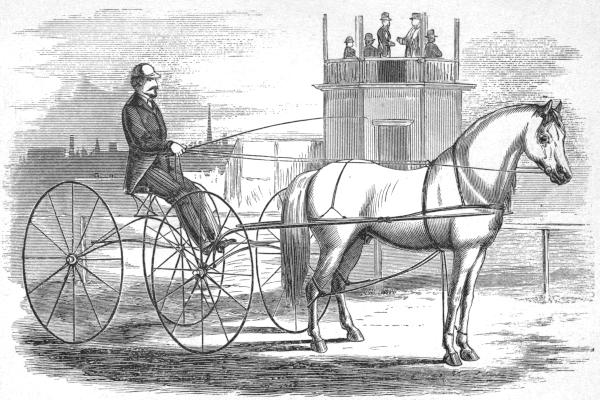
TO EDUCATE A PACING HORSE TO TROT.
Take four hame-straps, attach two on each hind-leg, one above and one below the gambol-joint, confining the straps on the front of the leg by means of a small ring. Then place two hame-straps on the front legs just below the knee-joint; buckle a strap from each fore-leg, carrying them up under the surcingle, and attach them to the rings in front of hind-legs, crossing strap from off fore-leg to nigh hind-leg, and from nigh fore-leg to off hind-leg; now commence to drive your horse, walking him very slow, as the new action of the legs may cause him to stumble; but after a few minutes you may increase his speed, and you will be delighted to see your horse trotting at a rate that will astonish you.
Common potash, ¼ oz.; extract of belladonna, 12 drams; gum Arabic, ¼ oz. Dissolve the gum in as little water as possible; then, having pulverized the potash, unless it is moist, mix the gum water with it, and it will soon dissolve; add the belladonna; mix, and it is ready to use.
The best method for getting this into the pipes, is by means of a small syringe, after having cleansed the sore well with suds. Repeat once in two days, until the callous pipes, and hard, fibrous base around the poll-evil or fistula are completely destroyed.
Take beef’s gall, 1 quart; alcohol, 1 pint; volatile liniment, 12 oz.; spirits of turpentine, 1 lb.; oil of origanum, 4 oz.; aqua ammonia, ½ pint; oil of amber, 3 oz.; tincture of cantharides, 6 oz. Mix.
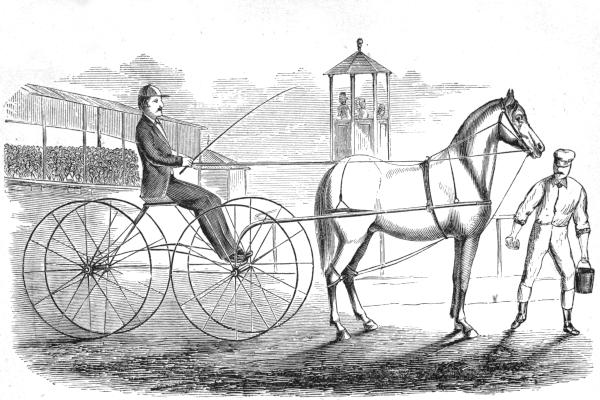
TO EDUCATE A HORSE TO TROT FAST.
The appliance required to form the trotting rig is arranged as follows:
Take four hame-straps, attach two on each hind-leg, one above and one below the gambol-joint, confining the straps on the front part of the leg, by means of a small ring. Then take a standing martingale and attach a small pulley on the lower end of the martingale; then take a small, strong cord, tying one end in the ring on one hind-leg, passing the other end through the pulley, bringing it back to the other hind-leg and tie it in the ring; adjust the rope in accordance with the stride of your horse, observing to drive him very slow for a time until he shall become accustomed to the rig.
This idea with alterations as hereinafter set forth may be successfully applied to horses while being used by the husbandman in ploughing,[278] that are addicted to the habit of kicking. I have already given the reader a number of ideas on this point that, if used in accordance with instructions, will not fail to give satisfaction.
Put on the horse the trotting-rig, as seen in engraving, with the exception of the standing martingale attached from the pulley to the bit-ring of the bridle; then through the eye of the pulley insert a small cord, say twelve feet long, carry both ends up between the fore-legs, pass one end through the bit-ring on the off-side up over the head, and down on the nigh-side of the head to the bit-ring, and then tie it. Now take the other end of the cord and carry it up on the nigh-side through the bit-ring and pass it over the head down to the bit-ring on the off-side and there tie it. By thus manipulating your cord you will perceive that you have a system of severely punishing the horse when he shall kick.
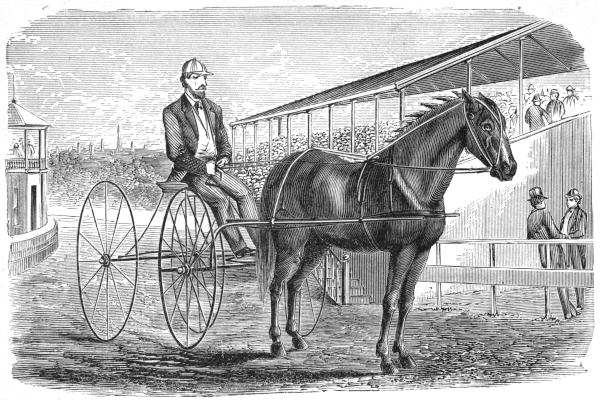
TO EDUCATE A HORSE NOT TO KICK WHILE IN SHAFTS.
Horses are quite often educated to kick in harness as well as out and almost numberless accidents have been caused by this vicious and bad habit. Men are found reckless enough to tantalize their horse with a whip and sometimes punch him with a stick, regardless of consequences. The result, in most cases, is that the animal becomes a kicker, and the habit when once formed is not easily eradicated by resorting to the old stereotyped method of placing a strap over the horse’s rump and buckling to the shafts on each side. This treatment may in time effect the purpose, but it will require months to do so. Laying all others aside, I with confidence say to the reader, if he will but practice the subjoined idea he will find it not only practical but effectual, because the punishment is so severe that a[282] few lessons will convince the horse that it will be greatly to his advantage to abandon the habit.
Take a cord twenty feet long, divide it in the center, place it back of the ears, bring it down and cross it in the mouth, then bring it up between the eyes, placing a ring or loop there; now bring it back through a ring attached to the head-stall between the ears, then bring both ends of your cord under the saddle of the harness and along the back, to a ring slipped over the crupper against the hip-strap; bring the cords through the ring down to the shaft on each side of the horse, observing to leave just slack enough so that your horse may not be too much confined. The cord used may be quite small, so that it is strong.
Now when your horse makes an attempt to kick he will find a severe punishment immediately meted out to him, and thus, finding his attempt fruitless as well as painful, he will be made[283] to understand that while obedience is rewarded, punishment quickly follows each act of disobedience. This simple yet effective expedient makes the horse punish himself for his own misdeeds, and by making the act of kicking the cause of his suffering disinclines him to attempt it, for neither horse nor man will voluntarily provoke certain pain.
These drops are reliable in cases of stoppage of water, foul water, or inflammation of the kidneys. Take sweet spirits of nitre, 4 oz.; balsam copaiba, 2 oz.; oil of juniper, 2 oz.; spirits of turpentine, 2 oz.; gum camphor, pulv., 1 oz. Mix all together, and shake well; bottle; and it is fit for use, for man or beast, under all circumstances where a diuretic is required.
Dose for horse, 1 oz. in half a pint of milk, once in six hours.
Dose for man, 1 teaspoonful, in a tablespoonful of milk, once in six hours.
Be sure to shake the mixture up well before pouring out for use.
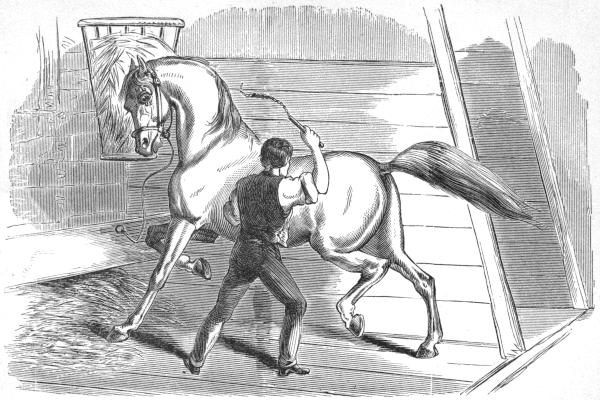
TO EDUCATE A LAZY HORSE AND INFUSE LIFE INTO HIM.
I have already given many ideas referring to balky horses, and as the old, tried remark is verily true, that “in the midst of council there is safety,” so with a multitude of ideas there is certain success. I will add one more to the catalogue.
Something that especially attracts the attention of a horse accustomed to balk often causes him to forget for the moment his offensive habit and start off, much to the surprise of his driver. By adopting the idea illustrated in the engraving and the explanation connected therewith, the reader will have no difficulty, in ordinary cases, with this peculiar tormentor, in accomplishing his purpose.
By many this may be considered a kind of jockey trick; but the reader will find the information valuable if he has a lazy horse or one that does not drive up well on the bit, as by following[288] the directions given below he will be prepared to show as much style as any man in his county.
Directions.—Take a small chain, about three feet long, and attach to it a strap or limber stick about the same length; with this in hand walk into the stable and commence plying on him a few smart blows, with this educator, above the gambol-joint, repeating it once a day for three or four days; when you hit him of course the chain rattles and makes, to him, a peculiar noise. Now, after you harness him up, put the chain in your carriage, then take your place behind him and commence driving, and when you want to show style, just kick the chain about a little with your boot and you will be surprised at the spirit and zeal manifested by your horse.
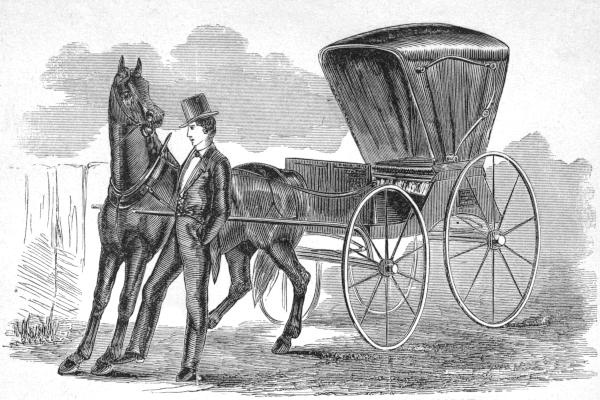
AN EASY METHOD OF STARTING A BALKY HORSE.
Among the various bad habits which horses acquire there are none which more severely try the patience of man than does the habit of balking. Frequently a horse is quiet, kind, and a good roadster, but has this habit of occasionally stopping in the road. At such times the almost universal practice is to whip the horse, and sometimes most brutally, or the more sickening custom of procuring a bundle of straw or some shavings and setting them on fire under the body of the horse. Such kinds of treatment I utterly discard, and the reader will find, in another part of my book, that I give several methods which will prove effectual in eradicating this habit, only meting out sufficient punishment to secure obedience.
Below I give an excellent method of starting a balky horse, and one which will prove effectual, though it will not educate the horse to[292] abandon the habit. When your horse balks get out of your carriage, walk up to him and commence kicking him with the toe of your boot under the fetlock joint, first one then the other, using the word “shoo!” loud and quick every time you kick. Then take your seat in the carriage and use the word as before directed, when your horse will start at once. This process diverts his attention and causes him to move on.
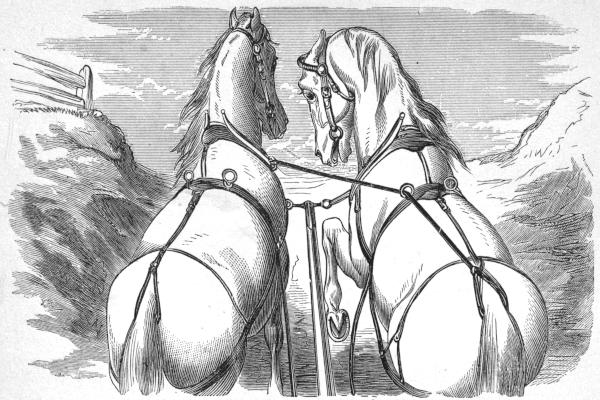
TO EDUCATE A BALKY HORSE TO DRAW.
Persons have resorted to many things in order to make a balky horse draw, and, after laboring for months, have seen all their efforts fail and are often disappointed by finding their animal worse instead of better. Let me assure the reader that however other methods may have failed, if he will but follow the subjoined instructions he will certainly accomplish the end desired.
Instructions.—Take a small strong rope, about a quarter of an inch in diameter and sixteen feet long, double the rope and place it under the balky horse’s tail; carry the ends up through a ring attached to the crupper or hip-straps, then pass them through the terret-ring on the saddle of the harness, and bring the ends to the true horse’s hame-ring; then tie firmly, exercising judgment about the slack to be given to the cord; then commence to draw slowly and your balky horse will soon learn that he has got to move with his mate.
Take 3 oz. white lead, 3 oz. lard, 1 oz. burnt alum, and 5 grains calomel. If the sore is of long standing, use 10 grains of calomel.
Venice turpentine, ½ pint; aqua ammonia, 2 oz.; salts of nitre, 1 oz.; benzine, 1 oz.; alcohol, 3 oz. Apply to edge of the hair and to the hoof, twice a day for the first three days; once a day for the next three days; after that, once in two, three, or four days, as the case may require.
Take oil of turpentine, 8 oz.; alcohol, 1 quart. Mix and bottle for use. Dose, 4 to 5 oz. in the horse’s feed, once a day for 8 days, will effectually remove every vestige of botts.

TO EDUCATE A HORSE NOT TO KICK WHILE BEING SHOD.
The reader has heretofore been instructed how to lay the horse down and thus get him under his control; but as horses possess a variety of bad habits, it becomes necessary that I should treat each one separately, and carefully explain, so that none can misapprehend.
Many horses rigidly resist the efforts of the blacksmith when undertaking to shoe his hind-feet, but the following ideas will enable you to thoroughly educate him to stand quiet.
Place a strap or cord between the hoof and fetlock joint; then stand in front of the horse and commence to pull the foot forward; if he shows resistance punish him in the mouth; continue to pull and punish until he will allow you to thus handle the leg, and, so soon as he remains quiet, step up and caress him; then stand behind him and pull his leg backwards several[300] times until you have removed all stubbornness or fear; when you have accomplished this let him get up, after which repeat the same thing, not forgetting to caress immediately when he submits to your treatment.
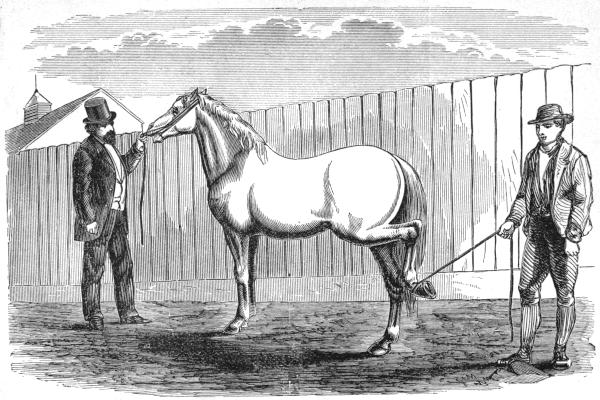
TO EDUCATE A HORSE WHILE STANDING THAT IS BAD TO SHOE.
The treatment for educating the horse after being laid down, which has been given, is to show him that your power is superior to his; the method now to be given will show him that you have the same power over him when standing as when he is down.
Place on him the Bonaparte bridle, as shown in the engraving, and take a half-hitch, placing it back of the ears and down under the upper lip, as shown in the engraving. Place a man at the side of his head to punish him with this bridle when he does wrong, remembering, as soon as the animal does right, to caress him.
Take a single rein, or a rope, about fifteen feet long, placing it on the hind-foot below the fetlock joint with loops; then stand behind the horse and lift his foot; if he shows resistance or[304] kicks, punish him in the mouth; continue doing this till he will allow you to handle his feet. If one lesson will not answer give him two, and, if necessary, give him three, or four, as he has got to submit to this treatment.
Take one-half pound of walnut or butternut leaves, and pour upon them three quarts of cold water; let it infuse one night, and pour the whole next morning into a kettle, and let it boil for a quarter of an hour. When cold it is fit for use.
No more is required than to moisten a sponge, and before the horse goes out of the stable, let those parts most likely to be irritated be well smeared over with the liquor, between and upon the ears, neck, flank, etc.
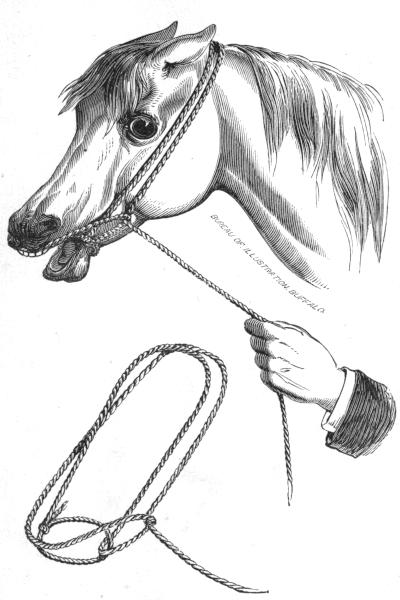
DOUBLE HITCH BONAPARTE BRIDLE.
This bridle may be used with great success, for many purposes in educating horses possessed of vicious or bad habits, and in order that the reader may not make a mistake I will explain it.
First. Make a small loop with one end of the cord and place it on the under jaw, then carry the cord on the off-side of the head over back of the ears, and bring it down through the loop on the nigh-side, you have now the Bonaparte bridle, afterwards pass the cord through your right hand, then with your left take hold of the cord and place it over the top of the head, and bring the cord down with your left hand under the upper lip.
The great advantage of this bridle is the complete control of the horse which it gives to the one using it. After the animal has learned its power all thought of resisting leaves him and he submits to the will of his owner. Harsh as[308] it may seem to one who does not understand the principle on which it is used, I do not hesitate to say that it is the most merciful device which could be originated, a hundred times more so than the brutal method of whipping a horse to make him obey. In all the horses I have handled I have never twice drawn blood, and the only occasion when I did so was by the drawing of a cord too rapidly as a man might have a rope drawn through his hand. Yet by the use of this bridle I have controlled and educated the most vicious animals that could be found, with the greatest ease to me and with the least possible suffering to themselves. Whipping makes no durable impression on the brain, as this does; it requires hours where this method takes but minutes; it is often unsuccessful, which this never is.
I will only add that a horse never should be coaxed, he is first to be subdued by fear and ever after is controlled only as he has a sense of the superiority of the one who uses him.
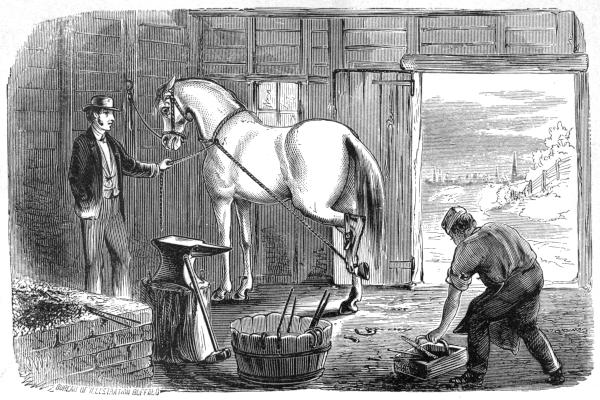
ONLY SAFE METHOD OF CONTROLLING A HORSE BAD TO SHOE.
I appended to a former plate instructions whereby a horse may be educated not to kick while shoeing; but if owners of horses will not take the pains to educate, it is scarcely reasonable that the blacksmith should be subject to severe torture in shoeing a vicious horse; therefore I have provided the foregoing plate as descriptive of the mode of perfectly controlling the horse’s hind-foot, so that the farrier need have no fears for his safety. Take a single rein or cord, make a slip-noose and put it on the horse’s hind-leg between the fetlock-joint and hoof; then bring the rein or cord forward to the breast and pass it around over the neck at the shoulder; now bring it down and put it under the rein or cord, forming a half-hitch, and bring up the leg so as to make it convenient for the smith to pare the hoof or nail the shoe; then take a pole-strap or one of similar width, and[312] place it under the other strap or cord, forming a loop by means of the crupper or loop near the buckle with the buckle outside, now pass the end of the strap up on the inside and front of the leg and around the gambol-joint, bring it down and buckle it; when you want to clinch the nails let out the strap two or three holes and draw up tightly on the rein or cord that is in front of the breast and around the neck. By this means you can accomplish the desired end, as you have the foot and leg under your control.
Should the horse attempt to recline over on the blacksmith, put on the Bonaparte bridle with double half-hitch, and pull quickly two or three times, and he will gladly stand erect while being shod.

TO EDUCATE A HORSE NOT TO BE AFRAID OF THE CARS.
Much difficulty, and loss of property, has resulted from not being able to control horses that become frightened at the approach of the locomotive or cars, and, in order to avoid the annoyance and prevent accidents, I have with great care prepared the foregoing plate, and will now give an accurate description of the mode of educating the animal, and the appliance required, I will first describe the bridle, seen at the right of the horse. Make the Bonaparte bridle as previously directed, then place it on the horse, stand at the nigh-side holding the cord in your right hand, now pass your left hand over the right and take hold of the cord, then by bringing the hand back and stepping in front of the horse, you have formed a half-hitch, then place it over the head and bring it down under the upper lip and above the upper jaw, thus you have a[316] powerful bridle that will control any horse. Use this with great care and judgment, because you are now in a position to handle the wildest horse found in the country. Don’t forget to caress the horse the moment he obeys.
Alcohol, and spirits of turpentine, of each 8 oz.; camphor gum, pulverized cantharides and tincture of capsicum, of each 1 oz.; oil of spike 3 oz. Bathe this liniment in with a hot iron, and faithfully follow till a cure is effected.
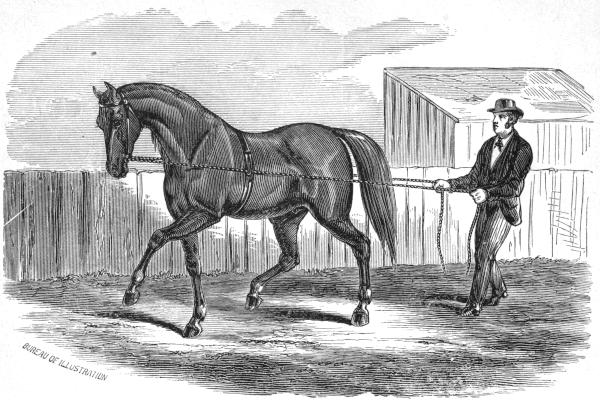
TO EDUCATE A HORSE TO BACK AT THE WORD OF COMMAND.
This point in the education of a horse is one of great importance, for no animal can be considered thoroughly educated till he will obey the command of his driver without the necessity of using the rein or the whip. Many persons in order to stop their horse will draw with all their strength upon the rein, and to back him requires the exertion of a force enough almost to bring the horse on his haunches, when in either case a well-educated horse will stop or back at the driver’s voice without the need for even drawing upon the rein.
To educate the horse to back at the word of command, let the reader take his stand behind the horse and with the rein in his hand, previously arranged as shown in the engraving, commence the lesson. He may, if he pleases, start the horse forward for a few paces, then stop him, and then with a sudden, short and pretty powerful[320] backward jerk, utter the word “back!” Great care must be taken to speak the word and give the backward jerk on the rein at the same instant, for the two must come together so as to be associated in the mind of the horse. When he obeys caress him, and continue repeating the lesson, and in a short time you will find that your horse will back at the word without your needing to even touch the reins. But in educating him to this there must not be the least interval between the word and the short, sharp jerk, for if only a few seconds pass he will not associate the two in his mind.
This method will be invariably successful, and is so far superior to the protracted and unsatisfactory means formerly employed, that it should be everywhere adopted.

TO EDUCATE HORSES OR CATTLE NOT TO JUMP FENCES.
Buckle a surcingle around the horse’s body, then buckle a hame-strap, making two turns with strap between the knee and fetlock on each fore-leg; next buckle two hame-straps on each hind-leg, above and below the gambol-joint, placing a ring, say one and one-half inches in diameter, as seen in plate. Now place a strap or cord from the ring on off hind-leg up through the surcingle, then attach it to the nigh fore-leg; then another strap or cord from the nigh hind-leg to the off fore-leg. Now when the horse, or other animal, starts to jump over a fence the appliance will arrest his progress, for, as he throws his fore-legs forward, at the same time it acts upon his hind legs, taking them out from under him, and you will find him sitting up in the field where you turned him out. After three or four lessons your horse will be thoroughly educated not to jump a fence.
First, bleed thoroughly; then give tinc. veratrum, ½ oz.; laudanum, 4 oz.; tincture aconite, ¼ oz.; shake well, and give a teaspoonful every three hours, in a pint of water, well sweetened, and, if the pulse is not reduced in a short time, increase the dose to a tablespoonful, until the fever abates. As soon as the horse recovers so as to eat and lie down naturally, keep him on hay, with a few carrots or potatoes, and daily give a bran-mash, with saltpetre, pulverized antimony and sulphur, for a week or ten days, and you will prevent dropsy of the chest, which usually follows this disease.
One-half pint of turpentine, 2 oz. assafœtida, 2 oz. aloes, 4 oz. lobelia seed, 1 quart of whisky, 2 oz. of sal ammoniac, 4 oz. saleratus, 1 oz. of camphor.
Dose, one tablespoonful once a day.
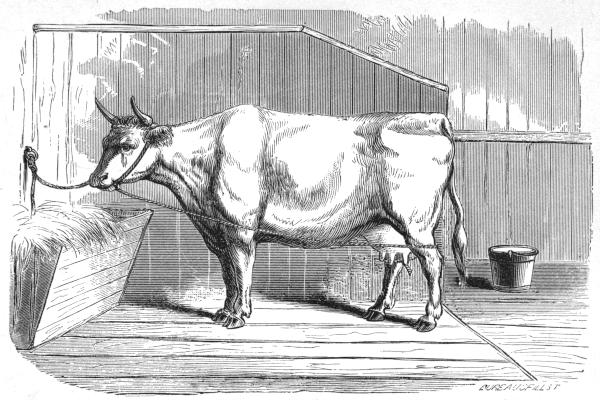
TO EDUCATE A COW NOT TO KICK WHILE BEING MILKED.
Hitch the cow to a post, then make the Bonaparte bridle as follows: Make a loop and put it on the lower jaw, carrying the end of the cord on the off-side of the head and around over behind the horns, bringing it down to the mouth on the nigh-side, through the loop. Now carry the cord around the nigh hind-leg, to the off hind-leg and tie it just above the gambol-joint. Then sit down to milk; now the moment the cow kicks, an impression is made on her brain, and she soon learns that by kicking she punishes herself, and rather than suffer the pain inflicted she yields to the influence and says by her actions, “I will not kick again.” The principle here is the obvious one that no animal will persist in doing that which causes suffering to itself, and the moment that it comes to associate the idea of suffering with any action, it will make that action distasteful.
Symptoms.—Pawing, manifesting a desire to lie down, and, without doing so, commence pawing again. As the symptoms increase, the animal cannot be kept on his feet; he frequently falls as if shot; pulse not altered from natural condition. Intervals of rest, together with the condition of the pulse, distinguish the disease from inflammation of the bowels.
Treat as follows:
Frequent injections of soap and water, and give internally spirits of nitre, 1 oz.; laudanum, 1 oz.; water, ½ pint; mix for drench. This may be repeated in twenty minutes, if relief is not obtained.
Another remedy, giving instant relief:
From 5 to 10 drops of chloroform, given on sugar, I have never known to fail giving immediate relief. I have known men to be from home, and have their horses taken with this disease, and use this remedy, and in thirty minutes the horses were able to be driven.

TO EDUCATE A COW TO LET HER MILK DOWN.
Much inconvenience, besides an actual loss of money, is experienced by persons who own cows that are in the habit of withholding their milk. Having spent fifteen years of my life in gathering knowledge of value to the farmer, and to other owners of animals, I am unwilling that even one valuable idea should be lost to the reader, and therefore I have, at considerable expense, illustrated the above-named point, believing that it will be of benefit to many persons. Although the method to be employed is very simple, it will be found practical in its operation, while success will be certain where the directions are followed:
Take a common bag, put into it a bushel or a bushel and a half of grain, or its equivalent in weight of sand, then place the bag across the back of the animal, as indicated in the engraving[332] and the result will be shown in the milking. As an indication of the purpose of the cow to hold up her milk you will always see her hump up her back, then, by applying the remedy named, the habit will be speedily removed.
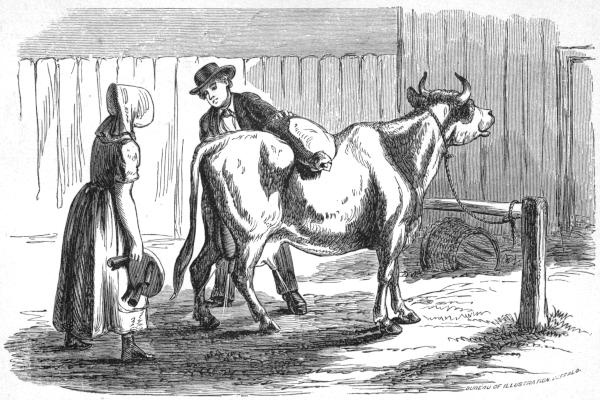
PRACTICAL RESULT OF EDUCATING THE COW TO GIVE DOWN MILK.
Having directed the attention of the reader to the education of the cow so as not to disappoint her owner in receiving the quota of milk he may rightly expect, it is but natural that the eye should be gratified by witnessing the result. For this purpose I have prepared this engraving, in which is represented the bag and its contents upon the back of the animal, in just the spot where it should be placed. The reader will also perceive the impatient wife standing with milking pail and stool in hand, waiting for the result, which becomes apparent in the freely flowing milk, and one can almost imagine that he hears her saying to her husband that it is scarcely necessary now to milk the cow, for the simple method adopted has caused a spontaneous flow of milk, and nothing now is needed but to set the pail under her and view with wonder and delight the pleasing effect produced!
Take a common stone jar, fill it with eggs, cover them with cider vinegar, and let it stand till the vinegar eats up the shells. Then stir all together. Take a lump of lime about the size of a goose-egg, slack it in hot water, using about one quart of water. Add one-half pint of the lime-water to a quart of the egg mixture. Give a teacupful, at feeding time, in feed, three times a day.
One dram white hellebore in powder, 1 dram sulphate of iron in powder, 1 oz. flaxseed meal.
The above for one dose, mixed with bran-mash, given at night. Repeat in forty-eight hours, if the horse is old. Two doses are enough for the worst case.
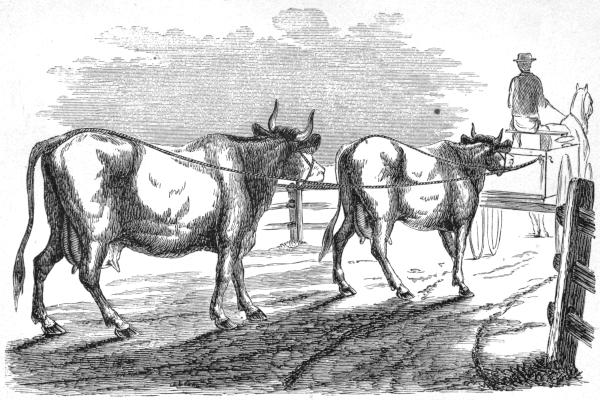
TO EDUCATE CATTLE TO LEAD BEHIND A WAGON.
Make a rope halter and put it on the head of the animal you desire to lead; then take a small rope, about twenty feet long, double it in the center, placing it under the tail; cross it on the back, bringing the ends down each side of the animals neck and then through the nose-piece of the halter under the lower jaw, and tie the ends firmly to the end of your wagon.
If you wish to lead more than one, take another rope, twice the length of the former one, double it in the center, placing it under the tail, cross it on the back, bringing the ends down each side of the animal’s neck and then through under the lower jaw. Now bring the ends, one on each side of the forward cow, and carry the rope through the halter under the jaw and tie it to the wagon.
By adopting this plan no difficulty will be experienced in educating your animals to lead, and when you drive home with your cattle following thus they will be sure to arrive there at the same time as yourself.
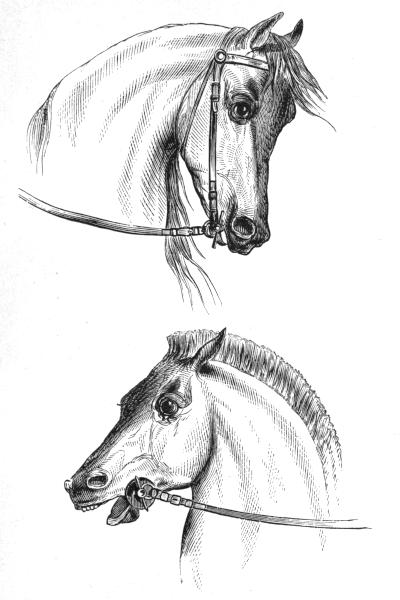
TO EDUCATE A TENDER-MOUTHED HORSE TO PULL ON THE BIT.
Many horses are very sensitive to a hurt in any part of the body, so much so that they often grow frantic when severely punished, and it seems to be the delight of some persons to inflict injury to a horse of this temperament, sometimes with a view to make him rear or prance about, believing it adds to the appearance of the animal, when the contrary is the fact; a bad habit is almost sure to grow out of such treatment, and then it may take some time to eradicate it. One of the evils often presented is that the animal becomes tender-mouthed, and I have known many cases where balking has been the result. Let me urge the reader never to jerk sharply on the bit, except when educating or correcting a habit, as heretofore directed.
The only effectual method of treatment for a tender mouth is to use a large straight bit, leave the check-rein quite loose, and drop the bit low down in the mouth, as seen in engraving, which will slip up and down and harden the mouth in a short time.
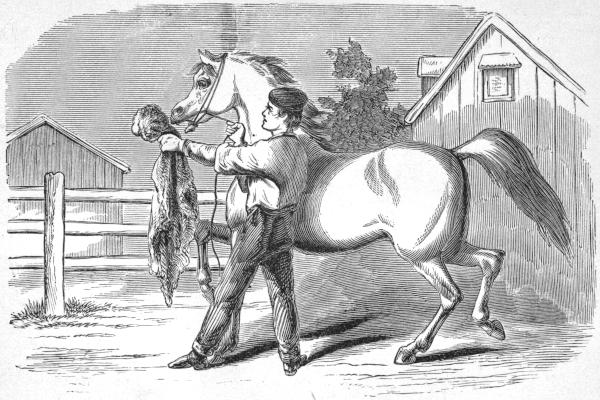
TO EDUCATE A HORSE NOT TO BE AFRAID OF A BUFFALO ROBE.
The education of the horse being quite a new idea to many persons, it therefore becomes necessary that, in my characteristic explanations, I should make my ideas both plain and simple—so that even the most unlettered may not become fogged while attempting to apply any illustrated idea in my work.
A Buffalo robe is an article in common use, and one at which very many horses become frightened, proving a decided source of annoyance. Let not the reader imagine that one lesson, as below indicated, is sufficient to warrant success and thoroughly eradicate the habit. Much depends upon the temperament of the animal; but, in most cases, three lessons carefully imparted will accomplish the purpose. After you have given two or three lessons do not tempt your horse by suddenly approaching him with the robe, and when you do approach him, be sure you have the Bonaparte bridle on him, that you may be able at once to control when the slightest resistance is seen.
Directions.—If your animal is very nervous lay him down, as directed in other places, fold the robe, hair side in, making it as small as possible; let him smell of it, rub it gently over his nose, head and body; punish if he resists—if not caress. When submission is apparent allow him to rise to his feet; then, with your Bonaparte bridle, properly adjusted, present the robe to him again. Bearing in mind the grand idea, punish for disobedience and caress when he obeys. Carefully avoid all unnecessary excitement while educating any animal, as it only tends to benumb their senses and make them less susceptible of being taught.
In discussing the intelligence of animals I am aware that many persons, at the outset, would question the propriety of the term. Man has so long arrogated the exclusive possession of mind, or at least of a mind capable of rational reflection, that he is reluctant to concede the fact of its possession by the lower orders of animate life. Those acts which, in the brute creation, seem to proceed from the action of powers analagous to human intelligence, it has been usual to ascribe to an irrational faculty called instinct; a power invariable and despotic in its action, but in no degree the result of reflection; some metaphysicians even going so far as to assert that the action of animals is purely automatic, the difference in this respect between them and the automaton moved by wires and springs being that the former possesses a consciousness[346] of their acts, while the latter does not. Facts in myriads, exist which challenge the correctness of such a theory, while in almost equal number they assert the existence, at least in its embryonic state, of a mind capable of thought, and, to a limited degree, of reflection and comparison, with the ability to deduce conclusions from the facts which it considers.
This intelligence varies greatly in the different animal races, in some species being barely perceptible, while in others it is too conspicuous to be ignored; and between individuals of the same species there exists a difference so marked that, in the more favored ones which come under our observation, the intelligence is so clear as to almost startle us by the feeling that behind the full, liquid eye of the horse, or prompting the fixed gaze bent on us by our trusty canine companion, there may be a mind kindred to our own and which lacks only the power of articulate expression to respond to our thoughts by answering sentiments. It is the absence of the power of speech in animals which leaves us in[347] doubt as to the exact degree of intelligence possessed by them. If, when the farmer says, “Carlo! the cows are in the corn—turn them out!” the dog should turn his head and reply, “Yes, sir, I’ll have them out in a moment!” there could be no doubt of the intelligent interchange of thought. But the fact of his doing that which in the supposed case he would express, proves as conclusively his comprehension of the command and his purpose to obey. The horse or dog, however fully he may understand the directions he receives, can give no other response than by his acts, and to words of praise or censure he can reply only by signs; these are clearly understood by us and show that our meaning is comprehended by the animal, thus proving a real interchange of thought. A popular author has said: “A dog may bark, a horse may neigh, but it is not by these sounds that they express the delicate shades of ever-varying emotion; it is by a thousand varieties of gesture which few indeed of us can analyze but which all clearly understand. A dog converses with[348] his master by means of his eyes and his ears and his tail, nay rather by every muscle of his body.”
To test the existence and extent of intelligence we must determine the capacity for comprehending thought. We recognize this capacity in a child long before it can express itself in language. Its dawn is seen as the infant learns to associate certain articulate sounds with certain persons, acts, or things, and to distinguish the meaning of tones which encourage, restrain or chide it. It is only after a twelve-month or more of constant tuition, lovingly and intelligently given, that our children begin to express in language the thoughts which are awakened by our words and acts, yet the comprehension is as evident and the response as apparent, the whole mental process being as perfect, long before. The same test which proves the intelligence of the child demonstrates its existence in animals there is a similar power of comprehending the wishes expressed, by associating certain articulate sounds with certain acts required,[349] as well as an equal recognition of the tones of voice by which approval, reproof or anger are made known; but, lacking the organs of speech, they are debarred, and forever must be, from any except the most limited interchange of thought. For this reason, attentive study is needed in ascertaining the extent to which they comprehend and respond to the intelligence which addresses them.
In the case of wild or undomesticated animals there is little opportunity for investigating this interesting subject. We see the beaver build his dam, and we understand the object so admirably attained by his work. We know that the elephant, to be taken in the pitfall, must see on the earth that covers it the foot-prints of one of his fellows, and we surmise the process of reasoning by which he concludes that he is safe in venturing where another of his kind has trodden. We learn that the ostrich which in torrid regions trusts to the heat of the sand for the incubation of her eggs, will in a more temperate latitude supply the heat which would else be[350] lacking by setting on her eggs during the cooler nights; but in none of these, nor in a score of other cases, in which there seems a rational foresight, can we determine how far the acts result from intelligent reflection. In domesticated animals, and especially in such as are trained for the service of man, the action of intelligence may be clearly traced; it is demonstrated by the ease and certainty with which they can be educated; it is seen in the readiness with which many receive and act upon ideas communicated to them; and in a multitude of instances the mental process is evident by which they have, independently, reached conclusions rationally deduced from facts of their previous knowledge. Mr. J. Hope relates a circumstance of a terrier who had been temporarily left by his master in the care of a Mrs. Langford at St. Albans. This lady owned a large house-dog which, disliking the presence of the stranger, quarreled with him, biting and severely wounding him, after which the terrier disappeared; but in a few days he returned again, accompanied by a powerful[351] mastiff, when both together fell upon the original assailant, whom they nearly killed. The mastiff was the watch-dog at his master’s house, more than a day’s journey distant, and had been brought by the terrier for the sole purpose of avenging the injury he had received, after which they left in company and proceeded together to their home. Here was displayed a power of combining ideas and of communicating them to one of his own kind, when the two acted on the plan they had preconcerted.
In a work just issued, an anecdote is related of a dog who had lost his master and afterwards became old and blind, passing his time sadly in the same corner, which he rarely quitted. “One day came a step like that of his lost master, and he suddenly left his place. The man who had just entered wore ribbed stockings as his master had done. The old dog had lost his scent and referred at once to the stockings that he remembered, rubbing his face against them. Believing that his master had returned, he gave way to the most extravagant delight. The man spoke;[352] the momentary illusion was dispelled, the dog went sadly back to his place, lay wearily down, and died.” Here was a double process of reasoning and even a balancing of testimony with a decision that the negative evidence of the strange voice outweighed the affirmative proof in the step and the stockings.
Much evidence favors the belief that animals not only become familiar with the words habitually addressed to them, but that they, to a certain extent, understand our language. A dog, belonging to a friend of the writer, would slink from the room with every indication of shame if a fault of which he had been guilty was spoken of in his presence. The author of “Chapters on Animals” describes a dog in his possession which clearly distinguishes between those visitors at the house who are favorites with his master and those whom he dislikes, and adds: “I know not how he discovers these differences in my feelings, except it be by overhearing remarks when the guests are gone.”
The elephant, though one of the clumsiest of animals, exhibits marks of high intelligence, and evidently understands the language in which he is addressed. He can be stimulated to unusual exertions by the promise of a reward. “I have seen,” says a French writer, “two occupied in beating down a wall which their keepers had desired them to do and encouraged them by a promise of fruits and brandy.” They were left alone and continued at the work, stimulated by the promised reward, until it was accomplished. “When a reward is promised to an elephant,” says the same author, “it is dangerous to disappoint him, as he never fails to revenge the insult.” Nothing of this could occur without an understanding of the language.
In India they were formerly employed to launch vessels, and it is related that one being directed to force a large ship into the water, the task proved beyond his strength; whereupon his master, in a sarcastic tone, ordered the keeper to take away this lazy beast and bring[354] another; the poor animal, as if stung by emulation, instantly repeated his efforts, fractured his skull and died on the spot.
It may be said that the tones of the voice rather than the words are what the animal understands, yet a dog knows his name however spoken, and a horse understands a whole vocabulary of orders. But the intelligence which comprehends the meaning of a tone, is not less than that required to understand a word or sentence. Mr. Hamerton, the artist, widely known as a lover of animals, mentions a favorite dog which met an untimely death by drowning, and in his lament over his lost pet, says: “He was a dog of rare gifts, exceptionally intelligent, who would obey a look where another needed an order. He would sit studying his master’s face and had become from careful observation so acute a physiognomist that he read whatever thoughts of mine had any concern for him.”
The shrewd intelligence of our countrymen is nowhere more clearly seen than in the keen[355] bargains the New Englander is famous for driving. But our domestic animals make bargains with us and sometimes resolutely keep us to them. On this point a pleasant writer relates an anecdote of a favorite mare who was so difficult to catch in the pasture as to often require six men to effect it; “but,” says he, “I carried corn to her for a long time, without trying to take her, leaving the corn on the ground. Next, I induced her to eat the corn while I held it, still leaving her free. Finally I persuaded her to follow me, and now she will come trotting half a mile at my whistle, leaping ditches, fording brooks, in the darkness and rain, or in impenetrable fog. She follows me like a dog to the stable and I administer the corn there. But it is a bargain; she knowingly sells her liberty for the corn. The experiment of reducing the reward to test her behavior having been tried, she ceased to obey the whistle and resumed her former habits; but the full and due quantity having been restored, she yielded her liberty[356] again without resistance, and since then she is not to be cheated.”
A horse which is regularly used for attending church, will, from its own observation, learn to recognize the Sabbath and understand the meaning of the church bells. Two interesting illustrations of this fact I give on the authority of a recent number of the Hartford Post:
A pair of horses that had been used during the week in team-work to Springfield, on Sunday were harnessed and driven to the door unhitched, and, the family being rather tardy that morning, as soon as the second bell began to ring the horses started off alone, and with their usual Sunday motion went up in front of the church, when, after waiting the usual time, they quietly went around under the horse-shed.
Here the horses plainly understood the distinction between that day and the six previous ones when they had been driven to Springfield, else they would have gone, after starting, to where they had been going through the week; they also evidently understood that at the ringing of the second bell it was time to start for[357] church. The gentleman who communicated the foregoing adds an instance which occurred in his own family:
The father of the writer, owing to increasing infirmities, rode alone to meeting, half a mile, driving an old gray mare twenty years old, and had not failed of going every Sabbath for some years. On one occasion, owing to a fall, he could not go to meeting, and on Sunday morning, as the time for meeting approached, the horse, in a lot near the house, manifested great uneasiness, and when the second bell struck she leaped over the fence and trotted quietly to church, stopping at her usual hitching-place, under an old elm tree, until the close of the service, when the faithful animal returned safely to the house.
When we remember that such exhibitions of intelligence occur continually where the animals have received no training on the subjects to which they relate, it seems certain that they are the result of a mental process which strongly resembles thought, and we would expect, from patient culture, displays of intelligence greatly in advance of those ordinarily taking place. Such an expectation is justified by the results which have followed training when directed to[358] this end. In a paper entitled “Canine Guests,” Philip Gilbert Hamerton gives an account of the trained dogs of M. du Rouil which, but for the unimpeachable veracity of the writer, would be almost incredible. M. du Rouil began to educate his first dog out of curiosity to see the effect of the sort of education which seemed to him best adapted for establishing a close understanding between the human and canine minds; the results astonished himself and were so gratifying that he subsequently educated two others on the same principles. Two of these dogs, “Blanche” and “Lyda,” with their master, were guests of Mr. Hamerton, and the intelligence they exhibited, and which he describes, is, by his own admission, “incredible,” yet may be so only because of our ignorance of the nature and extent of the mental powers belonging to the animal creation. Among the many feats performed by them were the spelling of words by lettered cards; the correction of words purposely misspelled; the working out of simple problems in arithmetic and the playing of cards[359] and dominoes. Of the latter, Mr. Hamerton says: “Both the dogs played a game at dominoes. This was managed as follows: the dogs sat on chairs opposite each other, and took up the domino that was wanted; but the master placed it in its position and kept announcing the state of the game. Their distress when they could not go on without drawing from the bank was announced in piteous whines, and amused us all exceedingly. Lyda was the loser, and precipitately retreated to hide herself with an evident consciousness of defeat.”
An incident occurred in the course of the evening which showed some understanding of language. A little girl wanted Blanche to come to her, but the dog kept away, on which M. du Rouil said, “Blanche, go salute the little girl!” She immediately went up to the child and made a formal obeisance.
The owner of Blanche stated that he was going home one night accompanied by the dog and on his way saw a man who was searching for some object that he had lost. “What are[360] you seeking?” he asked. The man answered that he had lost 280 francs. “Possibly my dog may be able to find them for you; have you any money left? If you have, show her a piece of gold.” It was done and the dog directed to search. She at once set out and soon returned, bringing first one piece of gold, then another, and then a bank-note, till the whole sum that had been lost was regained.
M. du Rouil said that Blanche really knew all the letters and the playing-cards by their names, and Lyda really knew all the figures. In addition to this Blanche had studied about one hundred and fifty words in different languages, something like twenty in each language. So it was with Lyda and the figures. She knew each one by its name, and would bring the one called for. In describing the earlier stages of training through which these dogs had passed, their owner said the first thing was to make the dog fetch an object, the next to make him discriminate between one of two very different objects placed together, and bring one or the[361] other as it was mentioned by its name. In beginning the alphabet he put two most dissimilar letters side by side to begin with, such as an O and an I, avoiding the confusion of similar ones, such as O and Q or B and R. Gradually the dog became observant enough to discriminate between letters in which the difference was not so marked. M. du Rouil said he had found the greatest difficulty in teaching Blanche to distinguish between the knaves and kings in playing-cards, but that she learned the aces very promptly. When he was asked what, after his ten years’ experience, was his opinion of the intelligence of dogs, he answered, with great emphasis, “that it is infinite.”
In subsequent pages I shall set forth my method of educating both dogs and horses to perform a variety of feats, which will be described, and from the ideas thus imparted the reader may multiply the number of tricks to any desired amount.

HOOF EXPANDING HORSE SHOE FOR CONTRACTED FEET & CORNS
Ground surface of shoe.
The hoof prepared for the shoe.
One of the most valuable patents for Horseshoes was granted to H. B. Ferren, of Batavia, N. Y., for a Steel Horseshoe, which promises to come into general use, and will, to a very large extent, supersede an Iron Shoe, whether made by a machine or by hand, because its form is the best, the material is durable, and the manner of making is such as to secure economy, and its adoption will prevent many of the prevalent cruel malpractices upon a horse’s foot.
Many horses are susceptible of an education far more extensive than is necessary for ordinary use, and for the benefit of such persons as may desire to teach their horses something more than the usual accomplishments, whether for their own amusement, or for the purpose of seeing how far the intelligence of the animal can be developed, I have prepared a description of a variety of tricks, which, as performed by my horses, have been received with universal applause, both in Canada and in the United States; to simplify which, I have, at considerable cost, procured plates, illustrating each of the tricks. But that no person may be misled into supposing that this forms a part of my general system of educating the horse, I deem it proper to present these directions separately.
Though the tricks to be hereafter illustrated and explained will add nothing of intrinsic value to the horse, nor of real benefit to his owner,[364] yet the reader will readily see in them the demonstration of a highly important fact, viz., that horses can be taught the meaning of words, and to yield obedience to sounds to such an extent as to convince a candid mind that their intelligence is far in advance of that generally attributed to them. With these remarks I will proceed to explain the modus operandi, as I call attention to a variety of tricks they may easily be taught to perform. Before passing to this, let me impress on the reader some leading principles in educating the horse. First, never allow yourself to get in a hurry; impatience or excitement on your part will go far in defeating the object of your instructions. Second, do not prolong your lessons beyond twenty minutes at one time; and, especially, never use severity beyond that which may be absolutely necessary. Thus by kindness and patience in repeating your lessons at short intervals, you will surmount every difficulty and accomplish your purpose in a manner satisfactory to yourself.
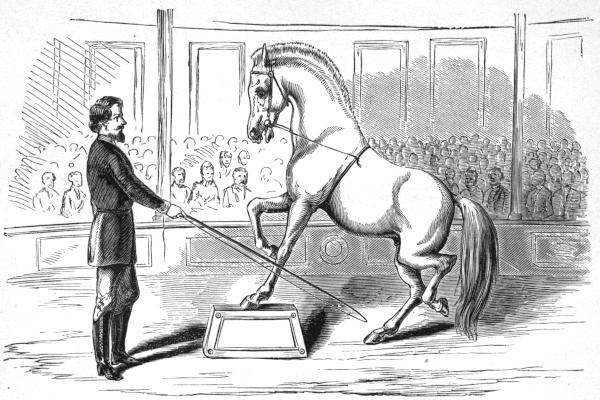
TO EDUCATE A HORSE TO MOUNT A PEDESTAL.
First make the Bonaparte bridle, and place it on your horse, then lead him quietly up to the pedestal, and say to him, “Get up with your fore-feet!” of course he will not obey; now you must teach him your meaning. While you hold the bridle let some one take hold of his front foot, raise it carefully and place it on the pedestal; then caress him, after which say, “Get down!” at the same time using your bridle in gently backing him. When he puts his foot down do not omit to caress him. Repeat this until he will obey when spoken to, then go through the same process with the other foot. After this, place both feet on the pedestal; then require him to get down, then up and down till he will obey you without the use of the bridle. Great care should be taken not to excite the horse while educating him, for when excited his brain[368] becomes muddled, and he is unfitted for retaining your instruction.
To make your horse stand on three legs: take a pin, and place it in the end of your whipstock, and with the point prick him slightly on the leg, in front, just below the fetlock joint, but not hard enough to make him kick; repeat this several times accompanied by the words, “hold up your foot!” continuing to repeat the punishment and words until he will obey the command without punishment.
Tie his head to his side by means of a surcingle and cord, fastening the cord at the side, reaching from the mouth; touch him lightly with the whip. He has to go, and, of course, he must go around and around. He soon learns perfectly to waltz by the motion of the whip, the teacher still repeating the word “waltz.”
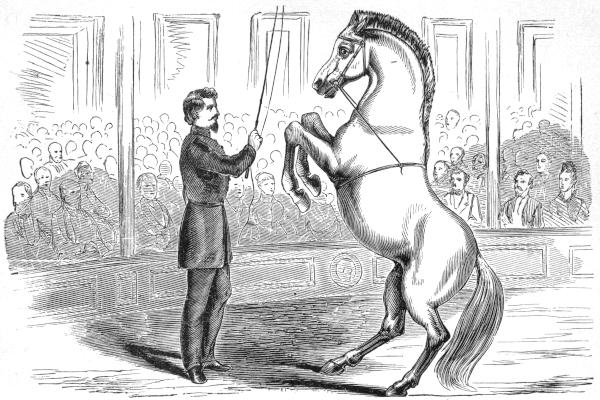
TO EDUCATE A HORSE TO WALK ON HIS HIND FEET.
Make the Bonaparte bridle, and put it on your horse; also put on a bitting rig, similar to the one shown in the engraving, drawing his head pretty well up and in. Now stand near his head with bridle in hand, and jerk upward, as though you desired to lift him up, at the same time repeating the words, “stand up on your hind feet!” repeat this several times, and if he does not make a move to please you, take hold of one leg, raising him up with one hand and using the bridle with the other, as before directed, not forgetting to caress him if he makes the slightest move in the direction of obedience. In order to ensure success, kindness and patience should be the ruling principles. After you have taught your horse to stand on his hind feet you will next educate him to walk upright. This can be easily done by observing the following directions. Stand in front of him, whip in hand, saying, “Get[372] up!” then shake the whip in front of him, stepping backwards slowly, at the same time say to him, “Come here!” repeating it sharply and touching him gently with the whip on the knees. By carefully observing the above directions, you will quickly teach your horse to stand upright, and to walk on his hind feet.
Prick him on the neck at the terminus of the mane till he shakes his head, then remove the pin, caress him, repeat for a while, and your horse will soon shake his head when you raise your hand to your heart; be always sure to treat the animal kindly for well-doing, and caress him when he deserves it, and he will repay you by his love for you and willingness to do your bidding.
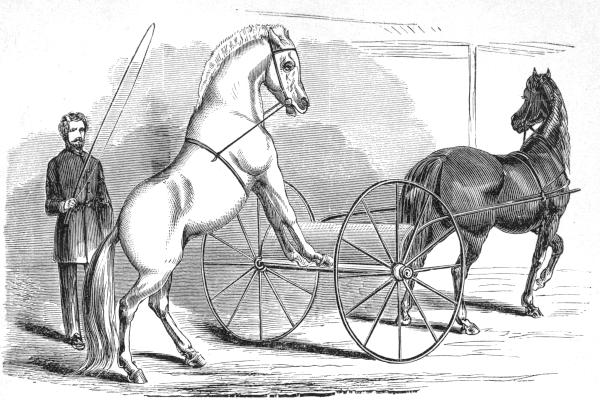
TO EDUCATE A HORSE TO PUSH A VEHICLE.
After your horse has been taught to mount a pedestal with his fore-feet, and to stand and walk upright on his hind-feet it is a comparatively easy task to educate him to mount upon a vehicle and push it. It is not at all necessary that a horse should be attached to it in front, as appears in the illustration, where the engraver has placed a representation of my black horse, Prince Albert, as a matter of taste, not as being necessary in conducting the instruction.
In this trick it will be scarcely necessary for the educator to put the Bonaparte bridle on his horse unless he should show some stubbornness, but, with bitting rig on, stand near his head, whip in hand, and say to him in rather a loud and sharp tone of voice, “Get up!” Some fear on his part may be manifested, still do not give up nor lose your patience, but lift his feet up and caress him. When he does get up do not[376] at first allow the vehicle to move, nor until he has mounted two or three times, then say to him, “Push!” and in a short time you will have taught him not only to get up on the vehicle but to push it in front of him. After your horse has been thoroughly taught, you will discover that he is delighted to amuse you, and he will appear pleased to participate in the enjoyment of the trick.
Tap him on the fore-leg till he holds it up, then caress him kindly; lead him with the left hand to the bit, and tap the left fore-leg with a stick in your right hand; repeat the word “lame, lame, lame,” and your horse will soon learn to hold up one leg at the command.
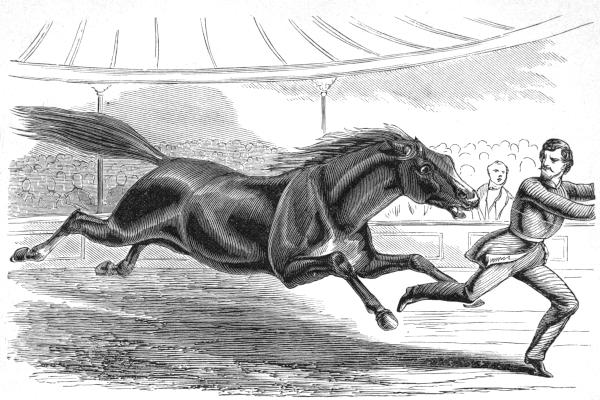
TO EDUCATE A HORSE TO BE VICIOUS.
Many persons are incredulous in regard to the assertion that horses can be educated; had one lived a hundred years ago he might have been excused for such incredulity, but in this age of knowledge and advancement in all departments of human life, no man should close his eyes to any of the developments wrought by man’s ingenuity. That the horse possesses more intelligence than many are disposed to admit, facts abundantly prove, and that he is quite as susceptible of acquiring evil and vicious habits as is man, the following trick will show.
My horse, Prince Albert, appears to enjoy the subjoined trick greatly, and I regard it as quite a sensational one. To educate a horse to be vicious you have only to attract his attention, and then appear to be afraid of him. For instance, strike him lightly with a whip on the knees, then run away from him, and after you[380] have repeated this a few times he will run after you. You may make the trick more interesting by calling him names, such as “a nigger,” “a mean horse,” and on speaking the words run from him. But be careful to have some place of safety, so that, when he follows, you may get out of his reach, as at some time he may disappoint and overtake you and mete out a punishment that will be anything but pleasing or desirable.
Prick him with a pin on the nose till he turns his lip up; then caress him well. He will soon learn that when you point towards him and say, “Laugh,” that it means a prick in the nose, if he does not turn his lip up.
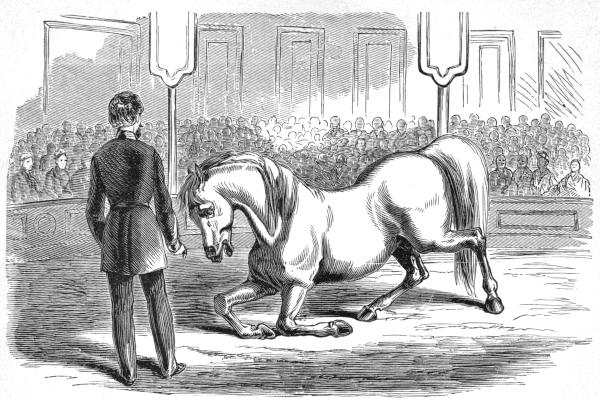
TO EDUCATE A HORSE TO WALK ON HIS KNEES.
The reader will observe, by reading my book, that great use is made of the Bonaparte bridle, and if those who handle horses will always resort to it when obedience from the horse is desired, they will save much time, trouble and annoyance that so often occur, especially to persons who quickly loose their tempers. Men can accomplish more in fifteen minutes using the bridle than in fifteen hours with any other means, as it does not inflict a severe punishment when properly used, but never fails to secure obedience. Therefore, as in most cases it is used, I, in the present, introduce it again.
Put a surcingle on the horse, attach a strap to his nigh fore-foot between the fetlock joint and hoof and draw it up to within eight or ten inches of his body, then take a strap or cord, say 6 or 7 feet long, and fasten it to his off fore-leg in the[384] same manner and secure the services of some person to assist you, directing him to stand on the off-side, and, when directed, to pull up his foot. Place on the horse the Bonaparte bridle, and take your position in front of him with bridle in hand, requesting assistant to pull, when your horse will come down on his knees, now pull on your bridle and say, “Come here,” when he will soon obey you. Do not make your lessons long, but repeat them often; not forgetting to caress him if he should make the slightest move towards you.
Never attempt to teach a horse this trick with shoes on his hind-feet, as he might cut himself, which would cause him to dread a second effort.
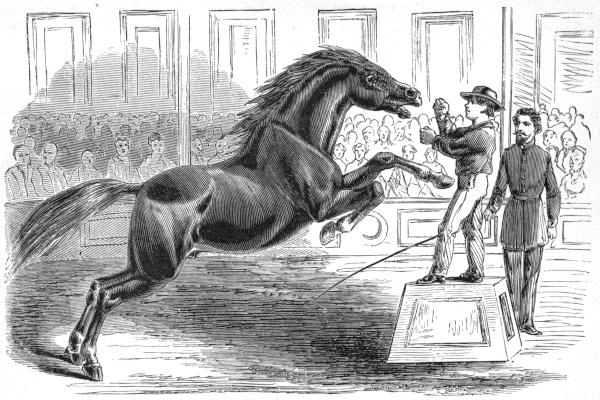
TO EDUCATE A HORSE TO DRIVE A BOY OFF THE PEDESTAL.
It will be necessary to first educate the horse to mount the pedestal. Instructions to do this may be found elsewhere; then proceed in the following manner to educate to the above trick. Put on the Bonaparte bridle, using a cord, say twenty feet long, and send your horse away from you with a whip, the length of the cord, then give him a slight pull, and say, “Come here;” then run from him and mount the pedestal yourself; when he approaches he will try to mount, and as he does so you jump off. After you have thus exercised him a few times get a boy to assist you. Let the boy stand on the pedestal, and say to your horse, “Come here and mount up;” instruct the boy to leave so soon as the animal shall mount.
You will find this trick quite a sensational one, and not difficult to learn your horse.
This is easily accomplished by tying a short strap or piece of cord to the forward foot below the fetlock; then stand directly in front of the horse, and hold the end of the strap in your hand, and say, “Shake hands, sir.” After which pull immediately upon the strap, which will bring his foot forward, and which you are to accept as shaking hands; then, of course, you must caress and feed him, and keep him repeating, until, when you make the demand, he will bring the foot forward in anticipation of having it pulled up.
Prick him in the breast with a pin, till he throws his head down and up the least bit; then take the pin away, and caress him kindly; repeat for a few times, until when you stand back and attract his attention, he will nod his head, expecting a prick in the breast.
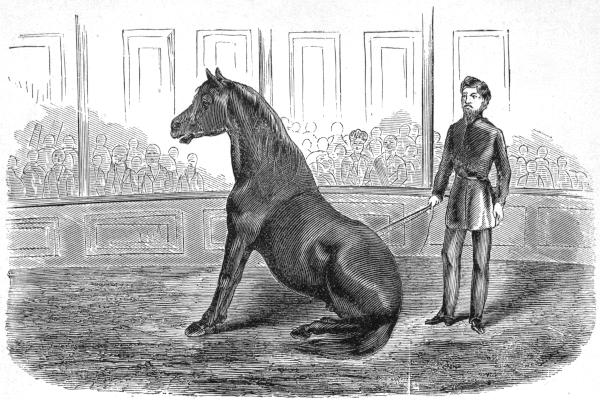
TO EDUCATE A HORSE TO SIT DOWN.
Horses differ very much in their capacity for being taught therefore, if you desire a pleasing subject, select one that is tractable. Directions: Make the Bonaparte bridle, and place it on your horse, so that you may have him under proper control, then put on him a common hame collar; now take two pole-straps and place one on each hind-leg, below the fetlock joint, and attach a cord, say twelve feet long, to each strap, carry your cord up through the collar on each side and bring the ends behind him, holding also the end of the Bonaparte bridle in your hand, and commence to pull on your cords; now repeat over the words, “sit down;” as he goes backwards draw up still more on your cords, until he shall sit down. Do not allow him to remain in this sitting posture more than a minute the first lesson. Repeat this two or three times a day[392] for five or six days, and you, with the assistance of a whip pointed downwards to the ground, will witness the pleasing effect of your instruction by seeing your horse sit down at the word of command.
Use two tablespoonfuls of lard, and one tablespoonful of slacked lime; brush out the dirt and dust from the foot; use no water. Apply the salve, well mixed, twice each day. It will cure the worst cases in 4 to 6 days.
Another remedy:
Hydrate of potassa, 10 grains; pulverized nut-galls, ½ oz.; white lead, pulverized opium, each ¼ oz.; lard, ¼ lb. Wash with soap-suds, rub dry, and apply the mixture night and morning. Give purging ball.
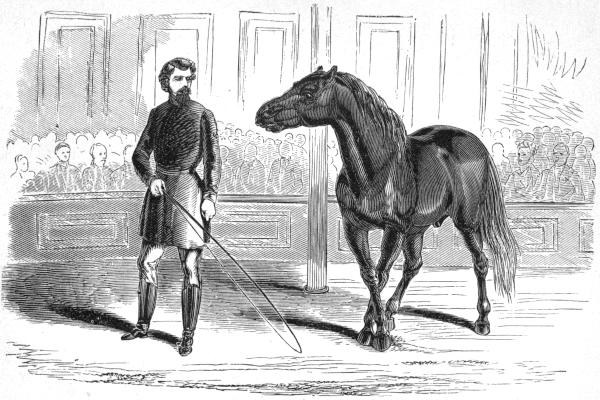
TO EDUCATE A HORSE TO BORE FOR OIL.
Place on your horse the Camanche bridle, and educate him to the words, “Come here,” so that he will mind you readily on hearing the words; by this you can better control him while educating to the trick in question. Some difficulty may at first be experienced, but by patience and perseverance you will not fail.
Take an ordinary pole-strap and place it on your horse below the fetlock joint on the off fore-foot; now take one loose turn round the nigh fore-foot, and take the end of the strap in one hand, with the other hand pull gently on the bridle, using the words as instructed. Your animal will attempt to obey, but will find himself somewhat hampered, yet he will quickly learn. If he should at first move a foot to please you, say “Whoa,” and then caress. Make your lesson short, and do not try to force him too much, for if you do he will become excited and resist your effort.
First put a rope around his neck, bring it down through his mouth, back through the loop on the neck, jerk him till he raises his fore-feet the least bit, then stop and caress him; then check him up tight to a surcingle—from the bit to the side-ring is the better way; then jerk on the cord, and he will soon get up erect; repeat, still caressing him well for all he does; he will soon get up at the motion of the whip. You should, when practicing him, repeat the words, “get up, sir!” It is in this manner I taught Tom Thumb to go up and down stairs, and to perform on the stage in different places, affording amusement to thousands of witnesses.
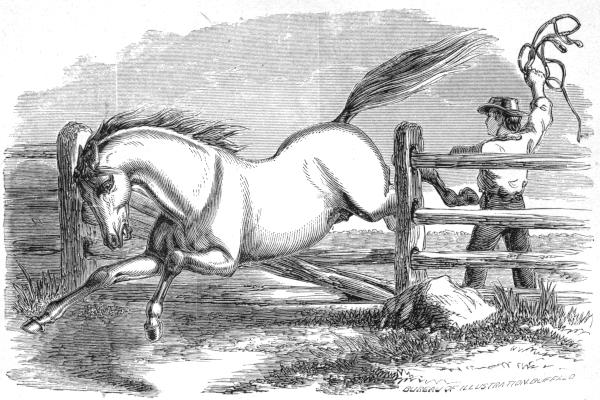
A SURE METHOD OF MAKING A HORSE BAD TO CATCH.
Two or three pages might be written upon this subject, and profitably read by owners of horses. Young men and boys are largely addicted to the habit of riding or leading the horse up to the bars or fence, and, some being too lazy to let down the rails properly, compelling him to jump over, and if he resists, the first effort is to hit him with the bridle or halter, and away the animal goes almost frantic with fear. To another class it proves an amusement, certainly arising from a depraved nature, as they like to see the animal jump; and to enjoy their sport they hurry him over regardless of consequences—not thinking they are laying the foundation of a very bad habit in the horse—that of being bad to catch in the field. Let those who have been guilty in the past, after reading this[400] paragraph over, desist from pursuing such a course of conduct toward horses, and ere long the time will come when there will be no need to apply the remedy—elsewhere found—to educate the horse that is bad to catch in the field.
This condition of the skin is usually produced by any derangement of system. Medicine of an alterative character is here indicated. The most successful remedy is sulphur, pulverized, 8 oz.; nitrate of potassa, pulverized, 3 oz.; black antimony, pulverized, 2 oz.; sulphate of iron, 4 oz. Mix well together, and give one tablespoonful twice a day.
Another good remedy:
Take saltpetre, 4 oz.; crude antimony, 1 oz.; sulphur, 2 oz. Both the saltpetre and antimony should be finely pulverized, then add the sulphur, and mix well together. Dose: tablespoonful of the mixture in bran-mash daily.
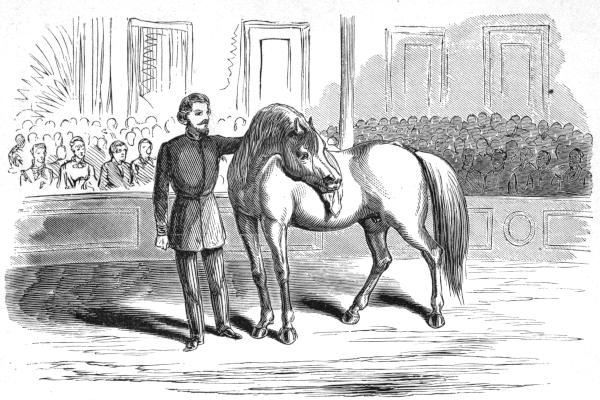
TO EDUCATE A HORSE TO TAKE A HANDKERCHIEF FROM HIS SIDE.
The reader must understand that it is necessary first to educate your animal to obey the words “come here” and “whoa,” before he can be taught tricks successfully.
There must be great caution used in teaching the above trick. First stand on the nigh-side and prick the animal lightly on the shoulder; he will reach round and bite near where the punishment is inflicted. After you have repeated this a few times, hold a handkerchief in hand with the pin and he will soon catch hold of it with his teeth; as you use the pin, say “Take it from the nigh-side.” Next prick him with a pin on the off-shoulder, handkerchief accompanying, and say “Take it from the off-side.” When you have given him five or six lessons, you may hold the handkerchief on his side and touch him with your finger, repeating[404] the words above directed. The instructor must be cautious when using the pin in educating, not to provoke so as to make the animal cross.
All catarrhal affections are classed by horse owners under the head of distemper. Common catarrh, epidemic catarrh, laryngitis, bronchitis, and all other diseases accompanied by nasal discharges, are regarded by horsemen as one and the same.
The following remedy is to cure distemper in its simple form, as we find it in colts soon after the disease commences. If there is swelling under the jaws, poultice the throat with flaxseed meal, or bread and milk. Apply mustard and vinegar, and give internally one of the following powders in feed: pulverized gentian, 2 ounces; sulph. copper, 1 oz.; pulverized ginger, 6 drams; mix, and divide into 8 powders.
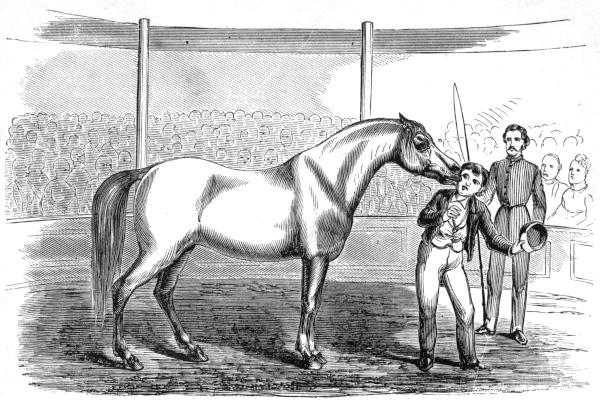
TO EDUCATE A HORSE TO KISS A BOY.
This kind of education is not particularly beneficial to the horse owner, but it illustrates clearly the idea foreshadowed in many parts of my work: first, that the horse may be taught almost anything that is in his power to do; second, that if you go rightly to work you may so gain his confidence that he will cheerfully obey every reasonable command.
Direction.—Take a piece of apple, place it in your mouth and say to your horse, “Kiss me.” He will approach you to take it; when he does so caress him. After repeating this a few times, when you approach him extend your mouth towards his and repeat the words “kiss me.” If he does not respond, place a piece of apple in your mouth as before, and repeat it until he shall obey without the use of the apple.
One-half pound of blood root; 1 quart of alcohol; 2 oz. tannin; ¼ lb. alum. Mix and let stand. Shaking several times a day till the strength is all in the alcohol, and bathe the spavin twice a day, rubbing with the hand.
Olive oil, 2 oz.; nitric acid, ¼ oz. Rub as much in every day, or every second or third day, as will bear without starting the hair.
Equal parts oil amber, oil spike, gum camphor, and ether. Should be shaken well before using, and well rubbed in with the hand.
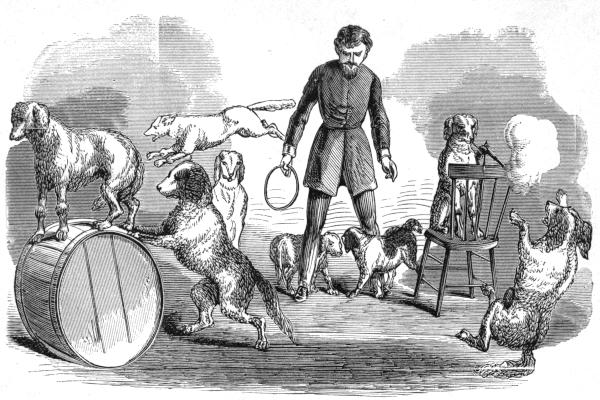
EDUCATING DOGS.
Place, on the dog the Bonaparte bridle so that you may control him; then put his fore-feet upon the barrel, standing in front of him with a piece of meat extended towards him, and say, “Roll the barrel;” pull gently on the cord, and if he should start the barrel don’t fail to caress him. With two dogs, put one on the top of the barrel, and they will quickly learn to roll it without being enticed by meat.
Drill a hole in the back of a common chair; attach a piece of iron at the lower part of the pistol, and place it in the chair as illustrated; tie a string with a knot in the end, to the trigger;[412] let it run through a ring in the butt of the pistol, then tie a piece of meat to the end of the string; now the dog will try to get the meat; in doing so he will fire it off. Load the pistol with blank cartridges. A few lessons will educate the animal so that at the order, “Make ready—present—fire!” he will obey. Place his mate in front of the pistol in a sitting posture and stand near him, and when the report is heard, teach him to lie down, which you can easily do by at first pressing him down with your hand until he will mind the word “dead.” Dogs are remarkably fond of being caressed, and the reader should not neglect this important accompaniment to his instructions.
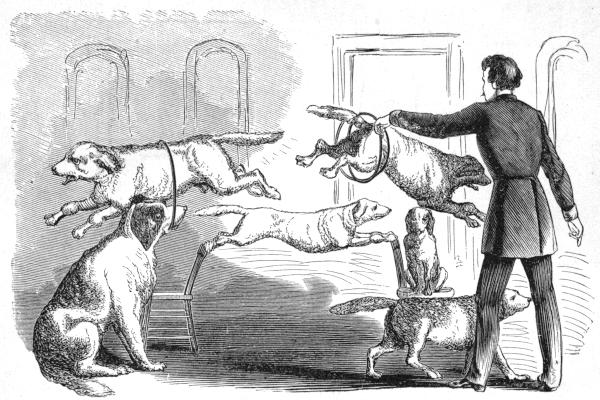
EDUCATION OF DOGS—Continued
Hold meat in your hand and pass it from one hand to the other between your legs. Occasionally give the animal a small piece; you will thus induce him after a little to obey the command “Pass through,” motioning in the direction with your hand.
At the first lesson procure a barrel hoop and elevate it, say six inches from the ground, holding it in your hand, and with the other hold out a piece of meat a short distance from the hoop, and say to your dog, “Jump.” He will go for the meat; increase the height of the hoop a little each time, and you will soon have[416] taught him so that you may not only reduce the hoop in size, but he will obey you without the use of meat.
Place two chairs back to back; then separate the chairs, say one foot apart, and decoy your dog to mount on one chair; then hold a piece of meat in your hand elevated above the chairs, and it will attempt to climb for the meat; repeat this process a few times, and soon you will educate the animal to rest its feet on the back of each chair; after which you may increase the distance until you distend the body, as seen in engraving, in accordance with your wishes. Continue until it will readily obey you without the use of meat; often caress the animal, as by this means you increase confidence and secure obedience.
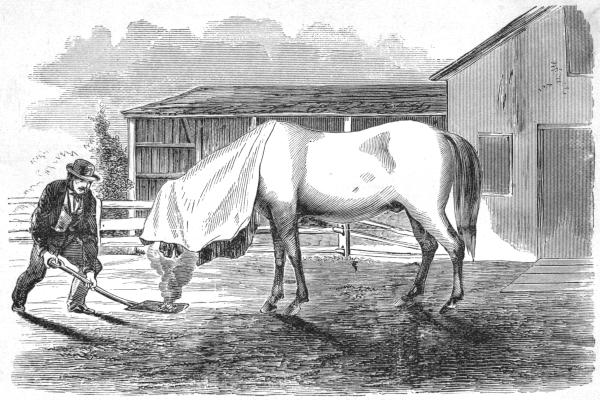
EFFECTUAL REMEDY FOR COLIC.
Symptoms.—Pawing, manifesting a desire to be down, and, without doing so, commence pawing again. As the symptoms increase the animal cannot be kept on his feet; he frequently falls as if shot; pulse not altered from natural condition. Intervals of rest, together with the condition of the pulse, distinguish the disease from inflammation of the bowels. Treat as follows:
Take a piece of woolen cloth, about one foot square, or its equivalent in pieces, saturate the cloth thoroughly with mutton or beef tallow, using from a quarter to a half pound, then roll up the cloth and it is ready for use; next place a blanket over the head of the horse, as seen in engraving; then set fire to the cloth, holding it[420] under the horses head with a shovel, and allowing him to inhale the smoke. Care should be used so as not to strangle the horse. By strictly following the foregoing treatment the efficacy of this remedy will be shown, as the animal will be relieved in from fifteen to twenty minutes.
Another remedy is:
Frequent injections of soap and water; and give internally, spirits of nitre, 10 drams; laudanum, 10 drams; water, ½ pint. Mix for drench. This may be repeated in twenty minutes, if relief is not obtained.
Another remedy, giving instant relief:
From 45 to 50 drops of chloroform, given on sugar, I have never known to fail giving immediate relief.
I have known men to be from home, and have their horses taken with this disease, and use this remedy, and in thirty minutes the horses were able to be driven.
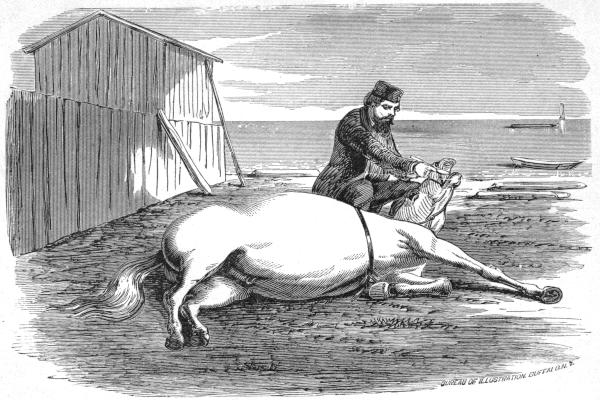
THE ONLY PRACTICAL AND SAFE WAY TO GIVE MEDICINE.
Much difficulty is experienced in giving medicine to a horse, but those who view and comprehend the foregoing illustration will see how easily all difficulty may be removed. In administering the medicine while the animal is standing, there is a constant liability to annoyance from the danger of strangling, by holding the head too high, or of spilling the medicine, in which cases the owner is foiled and the horse is left to suffer. The idea as illustrated, of which I claim to be the originator, though simple in itself is of great importance.
Directions.—If your horse is standing, use the directions previously given to throw him; when down, turn his mouth upward and pull a little on the cord used in throwing him, when he will open his mouth, and you can give the medicine[424] with a spoon without risk of spilling it; always observing care not to allow it to enter the nostrils, by which a horse may easily be strangled. Any person following these directions, will soon appreciate the value of the method described.
This being a valuable recipe, it is worth money to any man dealing in horses.
Euphorbium, 5 oz.; cantharides, fine, 2 oz., iodine, 1 oz., dissolved in alcohol; red precipitate, ½ oz.; corrosive sublimate, 2 oz.; quicksilver, ½ oz.; hog’s lard, 6 oz.; white turpentine, 6 oz.; verdigris, ¼ lb. Melt the lard and turpentine together, then, while hot, add the others, except the quicksilver, which must be stirred in as it becomes cold. Mix well. When cold it is fit for use. Rub it in well on the spavin every day for three days, then wash clean with soap-suds, and omit for three days; then repeat for three days, and so continue until a perfect cure is effected. Should it blister, use more cautiously.
There is only one sure way of telling the age of a horse, and that is by an examination of his teeth, and that only extends to a certain age, although an experienced horseman can guess very nearly for some time after that period. There are six teeth in the front part of a horse’s mouth, above and below, called the gatherers, from which we may judge of his age. When a colt is foaled, he generally has no teeth in the front part of his mouth. In a few days, two come in the upper jaw, and two below; and again, after a few days, four more appear, but the corner teeth do not make their appearance until he is four or five months old; these twelve teeth remain unchanged in the front of the colt’s mouth until he is about two years old, when he sheds the two center nippers.
At three years old, a colt sheds the adjoining teeth. At four years old, the under or corner teeth. At five years old, the bridle tooth makes its appearance. At six years old, the cups leave the two center teeth below. At seven years old, the cups leave the adjoining teeth. At eight[426] years old, the cups leave the outer or corner teeth. At nine years old, the cups leave the two center nippers, above. At ten years old, the cups leave the adjoining teeth. At eleven years old, the cups leave the corner upper teeth. At twelve years, or past, the groove on inside of the bridle tooth disappears in a horse. Mares very seldom have them.
(See engraving of horse’s teeth from the age of 7 to 18 years. Always look for the cups in the upper teeth.)
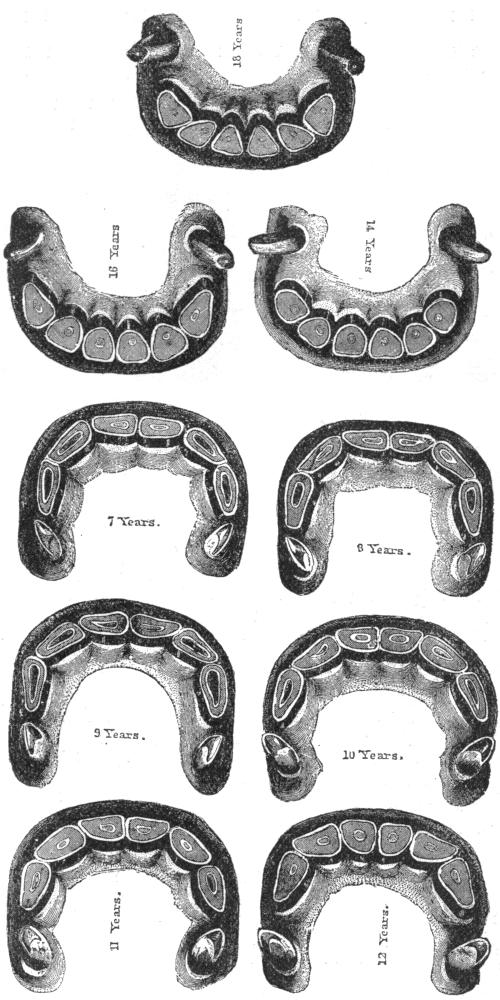
18 Years. 16 Years. 14 Years.
7 Years. 8 Years. 9 Years. 10 Years. 11 Years. 12 Years.
| 7 | years. | The cups in center of teeth are large. |
| 8 | years. | A trifle smaller. |
| 9 | years. | Still smaller. |
| 11 | years. | Smaller. |
| 12 | years. | Cups in center of teeth are smaller and nearly round. |
| 14 | years. | The teeth are round and cups have nearly disappeared. |
| 16 | years. | Are a mere speck in the teeth; scarcely discernible. |
| 18 | years. | The cups have worn away, and the teeth are round. |
Drive your steer in a small yard, fenced so that he cannot escape. Then approach him gently, and if he runs, do not run after him, but follow slowly and quietly. Should he again run from you, do not strike him with the whip, or in any way frighten him, he will soon stand and permit you to approach him. Place then around his body a surcingle or strap, near the fore-legs. Take a hame-strap and buckle around the near fore-foot; take a cord or rope, and pass it through under the surcingle, and tie to the strap which is around the foot. The cord should be twenty or thirty feet long, to permit him to run about you in the yard, without your pulling on it. Draw up on the rope to force him to move on three legs; approach him gently, till he will permit you to handle him as you please. Then hold up the near fore-foot by the cord, with your[429] left hand, and holding the whip in your right, pass it over his shoulder, and quietly touch him on the off-side of his head, and at the same time say, “Haw!” continue thus till he moves his head towards you, for which caress him about the head and neck; repeat this till he will “haw,” at the word, towards you. Should he attempt to run from you, pull on the strap, say “Haw,” at the same time touch him on the head with the whip. He will soon learn to stop at the word of command, in, this way, and turn towards you readily. Then take off the rig and turn him loose. Then proceed with the mate in the same way, when you can turn it out, and by this time the other steer will be ready to receive another lesson. Drive it in the same yard, and repeat the lesson with a whip. Quietly touch on the near side of the head, and at the same time say, “Gee!” until he will move around from you. Then caress him, till he will “gee” or “haw” readily. Go through the same lesson with the other. That is all you should try to do with them in four hours’ time. Take both together in the yard;[430] repeat this lesson till both understand what you desire of them. Take one of them near the wall; stand by his side; hit him gently on the head, at the same time say “Back!” till he will step back; then caress him. Repeat, till he will go back readily at the word. Give each the same lesson. This manner of training steers will make them always do your bidding. When convenient, repeat the above lessons, with both together. Then put on the yoke, and let them go. One hour, at first, is long enough to become accustomed to the restraint of the yoke. Repeat this in the yard.
If the steers should ever run from you, which often occurs in an ordinary method of training, buckle a hame-strap around the foot, bring it up through the surcingle back to the sled or wagon, between the steers. Let the man pull on the cord if they attempt to run away; this will pull up their feet; whip them over the head, which will stop them and break up the habit.
The main object should be to have the shoe so formed as to size, weight, fitting, and fastening, as to combine the most advantages of protection, and preserve the natural tread of the foot the best. In weight, it should be proportioned to the work or employment of the horse. The foot should not be loaded with more iron than is necessary to preserve it. If the work of the horse is principally on the road, at heavy draught, the shoe should be rather heavy, in order that it may not be bent by contact with hard, uneven earth; it should be wide in the web, and of equal thickness and width from the toe to the heel, that it may as much as possible protect the sole, without altering the natural position of the foot; it should be well drawn in at the heels, that it may rest on the bars, thereby protecting the corn place, or angles between the[432] bar and crust, and should in no part extend beyond the outer edge of the crust.
It is too often the case that the shoe is made according to the smith’s notions of what the form of the horse’s foot should be, and the foot is pared, burned, and rasped until it fits the shoe. Now, it should always be borne in mind that the shoe is intended for the foot, and not the foot for the shoe, and that it is therefore peculiarly proper to make the shoe fit the natural form of the foot. It is impossible to have the foot of a horse sound and safe, for work and use, after bringing it to an unnatural figure, by the use of the knife and rasp. The foot of the horse being elastic, it expands to the weight of the horse, in precisely the same degree, whether resting upon the most open or the most contracted shoe. Therefore, the shape of the shoe cannot possibly affect the shape of the foot. The form of the foot is determined by the situation of the nails If the nails are placed so that the inside quarters and heels are left free to expand in a natural manner, no shape which[433] we can give to the shoe can of itself change the form of the foot. It must not be inferred, however, from this that the shape of the shoe is of no importance; quite the contrary being the case, as I have already shown. In forming the shoe, we should always adopt that which produces the greatest number of advantages with the fewest disadvantages.
We find that the sole-surface of the foot is by nature concave in form, which seems to offer the greatest fulcrum of resistance to the horse when traveling. It is important to preserve the natural mechanical action of the horn and sole; therefore the ground surface of the foot, that is to say, the ground surface of the shoe, should be leveled cup fashion; its outer edge being prominent, corresponds to the lower and outer rim of the hoof; while the shoe being hollow, resembles the natural cavity of the sole of the foot. The ground surface of the shoe should always be concave.
The pattern that nature has presented us in making the sole concave, cannot be improved[434] upon by the smith, with all his skill. The expansion of the heels, and growth of the foot, require that the shoe should be long enough, and wide enough at the heels, to allow for the natural growth of the foot in the time it is calculated the shoe should be on before being reset; for as the foot enlarges, the shoe is brought forward until it loses its original proportion, and becomes too short and narrow. The shoe may be about a quarter of an inch wider and longer than the extreme bearing of the heels; and the nail-holes should be punched coarse and in the center of the web. The manner of fastening the shoe is what really affects the foot, and what requires the most special attention in shoeing; for the foot, being elastic, expands in the same proportion on the rough as on the nicely-fitted shoe. It is the number and position of the nails that really affect the foot. If they are placed well back in the quarters, four on a side, as is common, the crust is held as firmly to this unyielding shoe as if in a vice, which utterly prevents the free action necessary[435] to its health. Inflammation is produced, which causes contraction and the consequent, derangement of the whole foot. If the free natural expansion of the foot, and the spreading of the quarters in proportion to the growth of the hoof is prevented by the nailing of the shoe, irritation of the fleshy substance between the crust and coffin-bone will result, and ultimately create so much diseased action of the parts as to cause contraction and navicular disease. Shoes may be fastened without causing such mischief, if the following method of nailing is observed.
In experimenting, for the purpose of ascertaining how few nails are absolutely necessary, under ordinary circumstances, for retaining the shoe securely in its place as long as it should remain upon the foot, it has been satisfactorily established that five nails are amply sufficient for the fore shoes, and seven for the hind ones, three should be placed on the outside of the foot, and two on the inner side, near the toe, thereby leaving the foot free to expand in a[436] natural manner. The nails should not be driven high up in the crust, but brought out as soon as possible. Another mistake with most smiths is in rasping the clinches away too fine; they should be turned broad and flat. It is also a custom with some to rasp and sand-paper the whole surface of the hoof, for the purpose of making it look nice and smooth. Such a practice should never be tolerated; the covering thus removed is provided by nature to protect the too rapid evaporation of the moisture of the hoof, and when taken away, causes the horn to become dry and brittle. It has so long been customary to use as many nails as could be conveniently driven, in fact, of fastening the shoe as if it were to a lifeless block of wood, that the fear is very commonly entertained that the shoe will not be held in its place with so few nails. Such fears are utterly groundless, as both theory and practice demonstrate. If the presence of a nail in the crust were a matter of no moment, and two or three more than are really necessary were merely useless, no great[437] reason would exist for condemning the common practice of using too many nails, but it is far otherwise; the nails, aside from confining the natural expansion of the hoof, separate the fibres of the horn, which never, by any chance, become united again, but continue apart and unclosed, until, by degrees, they grow down with the rest of the hoof, and are finally, after repeated shoeing, removed by the knife.
As these holes cannot possibly grow down and be removed under three shoeings, it will be found, even with a small number of nails, that three times that number of holes must exist in the hoof all the while; and as they are often, from various causes, extended into each other, they necessarily keep it in a brittle, unhealthy state, and materially interfere with the future nail-hold. As the position of the hind-foot, and the nature of its office, render it less liable to injury than the fore-foot, consequently, it less frequently lames; however, disease of the navicular bone of this foot is by no means impossible. The same care should be taken as with[438] the fore-foot. Calks, although they may be turned down of perfectly even length on each side (which is seldom done), are objectionable appendages, and should be dispensed with, except, perhaps, for very heavy draughts, or when the roads are frozen or covered with ice.
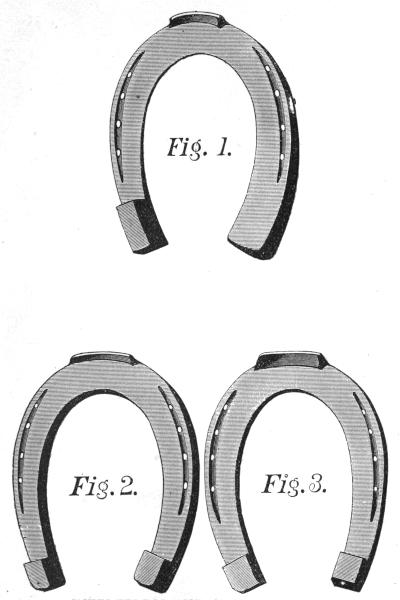
INTERFERING AND OVERREACHING.
Fig. 1. Fig. 2. Fig. 3.
Nature has provided a proper hoof for the horse, but sometimes it is round and flat and the animal will strike itself with the crust when not shod; the natural tendency being to travel very close, especially with the hind-feet.
Well-informed minds, together with the mechanical skill of many blacksmiths, have been brought to bear upon this topic, and after years of experience and research they have been unable to remedy this evil. As such I term it, because horses have suffered much, and become depreciated in value because of being addicted to the annoying habit of interfering.
I here propose to give a sure and certain remedy that has never been known to fail. The preparation of the hoof is by no means as important as that of the shoe; yet, should the animal interfere very badly, it may be better to leave the outside a trifle the lowest; however, the smith ought to be governed by circumstances,[442] not as to the shoe, but to paring the hoof. All that can be removed from the inside without putting the hoof out of shape ought to be done. Also pare the hoof at the toe instead of the heel, simply rasping it so as to form a level surface. Prepare the shoe carefully in accordance with the following directions, and as illustrated on foregoing engraving, Fig. 1:
Make the inside twice the width and twice the thickness that you do the outside, gradually tapering the width and thickness from the toe-calk. Make the heel-calk on the inside or heavy part of the shoe, about an inch long, and lengthwise from heel to toe, and incline it a little inward to the frog of the foot. Don’t allow your shoes to remain on longer than four weeks at most, and use as small nails as possible.
Young horses are more subject to overreaching than old ones. It very frequently disappears as the speed of the animal is increased. At a moderate gait, the front feet do not always get out of the way in time for the hind ones, as they are brought forward. Sometimes the heels are cut or badly bruised, and occasionally the shoes are torn from the fore-feet.
Remedy.—Have the front shoes made nearly twice the weight of the hind shoes. Lower the toe-calk on the fore shoe and increase the ordinary length of the calk on the hind shoe, and do not make the fore shoe to project more than half an inch beyond the heel. If the horse should have a good square heel, don’t allow the shoe to project any. Observe to instruct the smith to pare the toe or forward part of the fore-foot, and not the heel, simply rasping it to form a level surface. See illustration of shoes, Figs. 2 and 3.
Sure Method of Producing a Rapid Growth in Horses’ Hoofs.—Wash the hoof and apply common soft soap inside and out, twice a day, avoiding to rub any on the frog of the foot. Care should be used so as not to allow the soap to remain on the hair near the hoof. By putting a mark near the hair, the operator will be better able to judge the rapid growth. While using the above, should the hoof get soft, apply salt, which will quickly harden. I have grown an entirely new hoof on a horse in six weeks, by following the above direction.
As taught to the Farriers of the United States Army by Alexander Dunbar, under the authority of the Joint Resolution of Congress, and for which Dunbar received twenty-five thousand dollars. Highly recommended to the U. S. Army by Robert Banner and George Wilkes.
The first thing to be done is to carefully examine the horse’s feet all around, to see that they are of a natural shape, taking care to abstain from any action that will tend to excite the horse.
The shoes should be removed one at a time, and the nails carefully drawn after the clinches are cut, one at a time; anything like tearing off[446] the shoe by main force should by all means be avoided.
The shoe being removed, the rasp should then be used on the edge of the foot where the shoe has been, removing all dirt and gravel which may have accumulated there, and thus prevent injury to the shoeing knife.
If the foot is healthy and of a natural shape, and has been shod regularly, no alteration is required, but simply to pare out the sole of the foot, removing the bors entirely, and opening out the heels back. The surface of the frog should be trimmed off a very little, but the sides should never be cut.
By reference to Plate No. 12 the exact idea of the system of paring the foot may be gained. It has been practiced successfully, and is recommended for the simple reason that by the system of removing the bors and opening out the heels, contraction is prevented, and the frog retains its natural shape, because all pressure is removed from each side.
The foot should not be scooped out so as to leave the wall projecting without any support; for the wall of the hoof is the base upon which the horse travels, and this should be supported by a sufficiency of the sole as a “ground surface.” The shoes should be removed and the feet prepared one at a time.
In fitting a shoe to the foot, after it has been thoroughly prepared, the farrier should take hold of the foot and see that the shoe is perfectly easy on the heels, and that he has sufficient room all around in the manner illustrated on Plate No. 11. If the shoe is found to fit well everywhere, he will take the foot between his knees, and placing the shoe properly, drive the nails with great care, so that the shoe cannot get out of its proper place. When the nails are started he should hammer them home lightly, or according to the foot he is working on. The three nails on the inside and outside, toward the toe, should always be driven a little tighter than the heel nails, so as to prevent pressure on the heels. No man should be in a hurry in shoeing a horse,[448] but should always be careful in fitting and driving the shoe as instructed.
A shoe should never be fitted tightly, unless the coffin-bone has too much play; then it should be fitted tight around the toe and each quarter, as far as the nail-holes extend back, in order to contract the foot, and bring the coffin-bone to its proper place. Such cases are, however, very rare.
The heels of the shoe should never be allowed to curve inward toward the frog, and the foot should be prepared so as to prevent any pressure from the shoe on the heel, in the manner shown by Plate No. 14, at the same time allowing the bearing of the shoe to be perfectly equal.
If the horse has a long foot it should be shortened on the toe as much as possible—the more the better—for the hoof grows out more quickly at the toe; and it is necessary, because in a case of this kind the coffin-bone is necessarily out of its proper position, and the operation of shortening the toe must be continued until it[449] resumes its natural shape; but a close operation, and working the horse at the same time, is not recommended, because the foot can be brought to its proper shape by cutting gradually in time.
After the cutting has been performed, a shoe should be fitted so as to have the pressure on each quarter, and with heels, if the horse’s heels are naturally low, in order to prevent a sudden change.
A horse should be re-shod at least once a month.
Plate No. 3—Paring out the Foot.—By reference to this plate it will be seen what a difference there exists between the system recommended and practiced by Mr. Dunbar, and the old style practiced and recommended by all authorities on the subject heretofore.
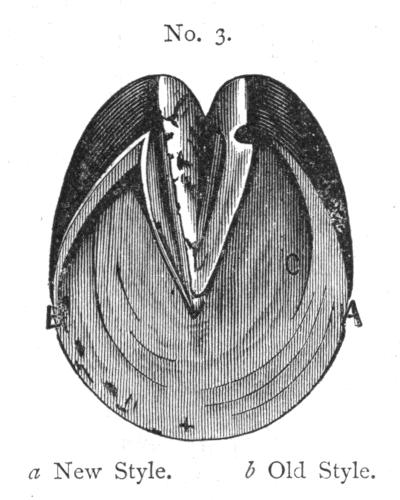
No. 3. Paring the Foot.
a New Style. b Old Style.
The bors should be cut away entirely, removing the pressure from the frog, and cutting out the heel. By this system of paring the foot a ground surface will always be left, commencing at the[450] heel and expanding gradually, as illustrated by the plates “A” to “C;” the sides of the frog should never be cut, but the top should be cut down sufficiently to allow it to be clear of the ground after the shoe is fitted. The cleft of the frog should always be cleaned out thoroughly every time the shoe is renewed.
Plates Nos. 4. and 5—Long Feet before and after Cutting.—A horse with a long foot, as will be easily seen, will suffer from an undue pressure on the heels (see article on Corns), causing corns, and in addition to that, if the foot is not shortened in time, it will cause the coffin-bone to lose its proper shape, but this can be remedied by shortening the toe every time the horse is shod, thus keeping the foot in its proper shape.
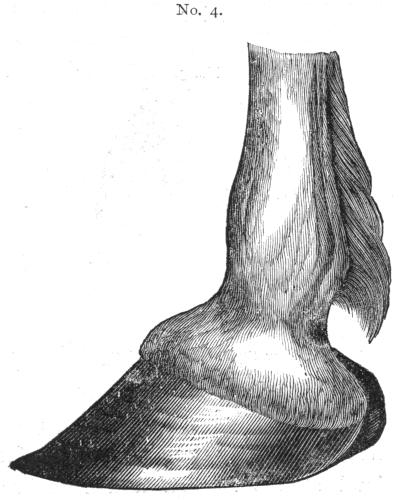
No. 4. Long Foot—Before Treatment.
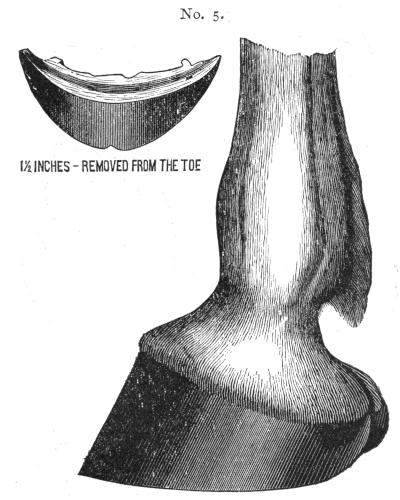
No. 5. Long Foot—After Treatment.
The common practice of fitting a shoe tight on the heels, to prevent interfering, is entirely wrong; an interfering horse does not strike with his heel, but with the inner side of the toe, not further back than the heel-nails, both hind and[451] forward. To prevent this, the shoe should be fitted wider on the inner than on the outer heel. A horse that interferes should be carefully examined by the farrier before shoeing, who will notice particularly the shape of his feet. If the animal stands inward and interferes, the outside quarter should be cut down, and thus throw the foot level; and if he stands outward and interferes, the inside quarter should be cut down for the same reason. After this a shoe[455] should be fitted with no nails on the inner quarter, which should be thickest.
To prevent a horse traveling pigeon-toed is simply to pare off the inner quarter of the toe, and have the shoe fitted as above. By this operation the bearing will be level. This will apply also to a horse for light riding, and for a horse traveling between the shafts; but for the latter a good block heel on the outer, and a small one on the inner quarter of the shoe should be made; the toe also to be made thick in proportion, to make the bearing level.
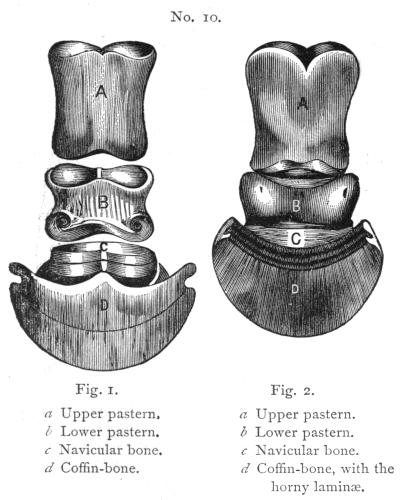
No. 10. Coffin-Bone.
Fig. 1.
Fig. 2.
Plate No. 10 is a representation of a perfectly healthy coffin-bone, with the upper and lower pastern and navicular bones front, and reverse sides. The system recommended by the author is intended to prevent any pressure whatever on the wings of the coffin-bone. Anything that prevents the perfectly free action of the coffin-bone will cause “navicular disease,” and “ossified cartilages.” After a foot is pared, as recommended in this, so as to be easily[456] expanded, the wings of the coffin-bone, which are the widest part, should be protected by a wide shoe, and there should be no pressure whatever on the heels.
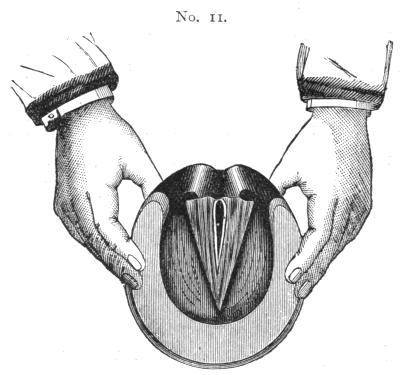
No. 11. Fitting a Shoe to Remove Pressure from the Heel.
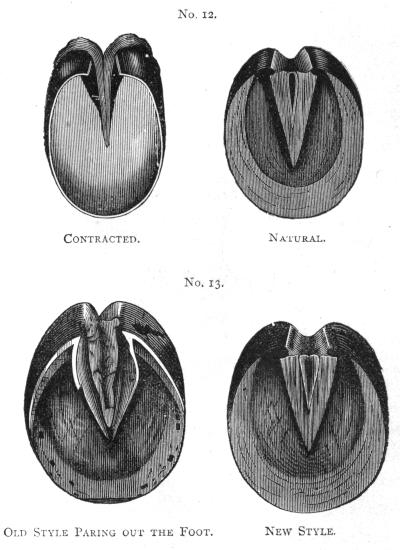
No. 12. Contracted. Natural.
No. 13. Old Style Paring out the Foot. New Style.
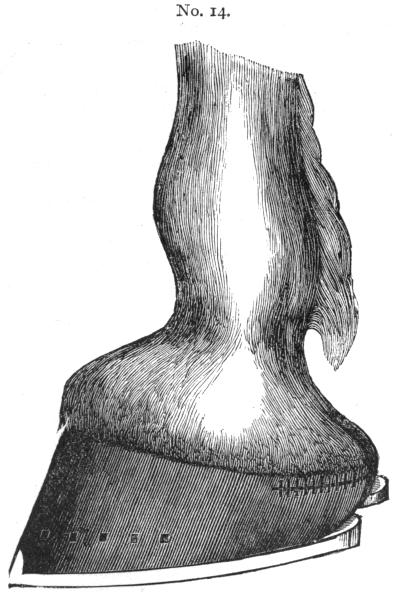
No. 14. Contracted Foot after Treatment.
The pressure of the bor on one side of the seat of the disease, and of the horny substance of a contracted heel on the other side, added to a tight shoe, causes inflammation, which, when it becomes chronic, is styled a corn.
A corn may be detected by paring the foot close. It is not necessary, as recommended by some authorities, to use pincers, squeezing the hoof all around to find the corn, thereby giving the horse unnecessary pain. They are to be found only in the heel, and do not result from bruises, but from pressure.
Treatment.—The shoe having been removed, the inside of the hoof should be pared out thoroughly all around, and if a long hoof, it should be shortened. If the corn is visible, the heel should be pared down and the bors weakened, opening the heel as far back as possible (see Plate No. 11), and fitting an open shoe, so as to throw the pressure off the heel. The pressure[460] having been removed, the corn will disappear, or grow down in the quarter, in which case the farrier should fit a bor shoe, so as to throw the weight off the diseased heel and partly on the frog, the elastic surface of which will prevent severe pressure.
If a horse has a long foot, the pressure is more on the corns, because his foot is in front of him, and an over-proportion of his weight comes on his heels. A horse with a long foot is like a man with a thick sole to his boot and no heels, for with his heels he strikes the ground first.
Every horse should have his feet well under him, and not in front of him. This fact should be taken into consideration when fitting the open shoe.
Inflammation should be reduced by placing a swab over the coronet, and using a hot poultice of linseed meal for the foot.
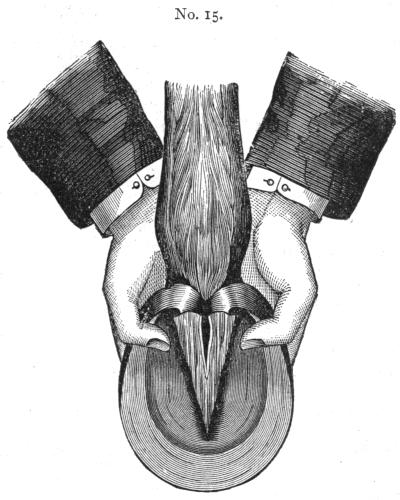
No. 15. Expanding the Foot after it has been Pared out.
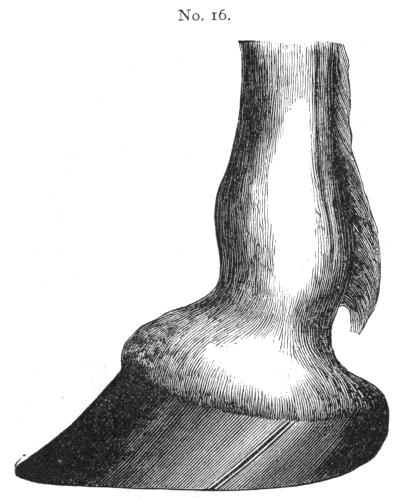
No. 16. Lateral Quarter-Crack before Treatment. Contracted Foot.
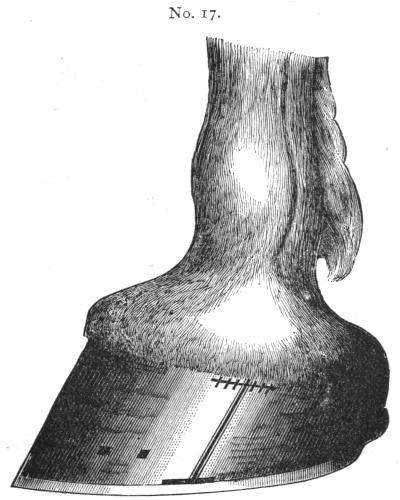
No. 17. Quarter-Crack—Lateral—Under Treatment.
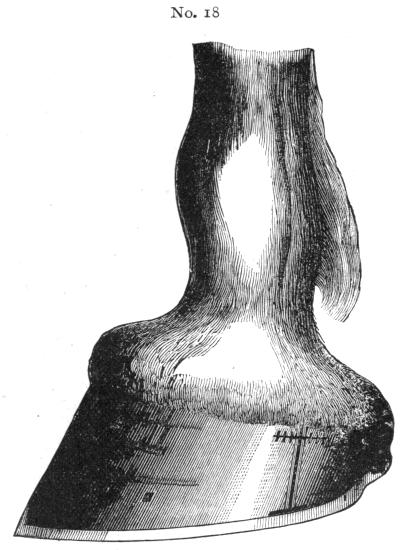
No. 18. Straight Quarter-Crack under Treatment.
The pressure having been removed from a corn for a fortnight, it will be observed to have a light color, representing the color of a new corn, and if properly treated, it will gradually disappear, and be displaced by a healthy growth of foot.
The horse should be allowed at least a month in which to recover from his lameness; but it is not necessary to turn him out to grass, and care should be taken that his feet are closely attended to, having the shoes renewed about once in a fortnight.
Contraction is the result of neglect, want of natural moisture, and tight shoeing. The result is lameness, if in one foot, and if in both feet, the loss of their free, natural use, causing short steps and stumbling. If the inner quarter is contracted, it is the cause, if not soon remedied, of quarter-crack. The practice of fitting a shoe so as to fit tighter on the inner than the outer quarter, to prevent interfering, renders it more liable to contraction.
The want of proper moisture causes the horn to shrink, and prevents the foot from expanding naturally. This should be remedied by soaking the feet, if feverish, in warm, and if healthy, in cold water, twice a day, an hour at each time.[466] This moisture should be applied at least two hours before the horse is used. This will render the foot elastic, and prevent abuse from traveling over rough roads.
By reference to accompanying plate, No. 12, the difference will be observed between a natural and a contracted foot. The quarters growing toward each other in the contracted, cause the coffin-bone to lose its proper shape, and forcing the sensitive frog upwards from its proper place, causes scratches and thrush.
Treatment of contraction, briefly speaking, is expansion. The foot should be thoroughly prepared in the following manner: If the horse is lame, the farrier should shorten the toe, lower the foot all around, and open the heels back until the blood is drawn. The sole of the foot should be pared as closely as possible on each side of the frog, in the manner shown by the illustration on Plate No. 12, “natural foot.” The frog should be lowered, but the side should not be cut. A groove should be made with a rasp just under and parallel with the coronet on each side (see Plate No. 14) deep enough to draw blood, then with a fine shoeing knife, cut little notches down from the cornet and across the groove at certain equal distances, as shown by illustration No. 14, the entire length of the groove. These notches should also be deep enough to draw blood. This will relieve the pressure caused by contraction from the cartilages on both sides, and allow them to resume their proper shape.
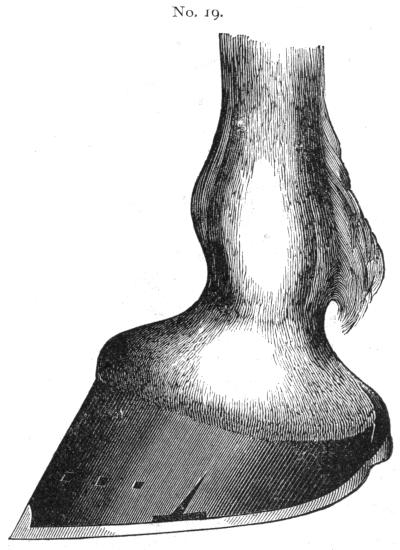
No. 19. Quarter-Crack, after Treatment.
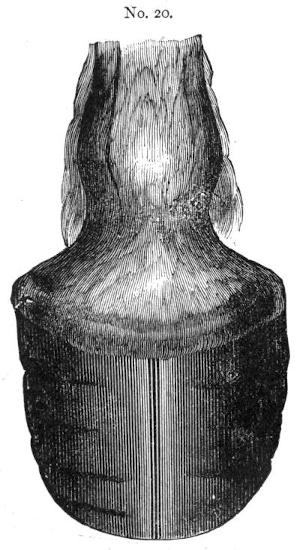
No. 20. Toe-Crack, before Treatment.
Having the foot ready for a shoe, a hand should be placed on each side of the foot, pressing it outward in the manner shown by Plate No, 15. The shoe must be very carefully fitted, and must have eight nail-holes, for the reason that it is the heel nails that relieve a horse while in contraction.
The shoe should be fitted so as to project at least a quarter of an inch on each side of the foot, so as to see the nail-holes projecting on each side of the outer and inner quarter. Having this accomplished, the bearing should be equal; the nails must be driven first toward the toe,[470] then toward the heel, driving them half-way, and using the utmost care and skill; the higher the nails are driven the better. The shoe being fitted so wide, there is no fear of pricking.
The nails toward the heel should be driven by alternate taps on each side, because the foot expands on each side on account of being pared so thin on either side of the frog, the source of the expansion.
The heel nails should relieve the wings of the coffin-bone, which suffer most while in a state of contraction, and allow them to come back to their proper position.
Considerable soreness will result from this mode of treatment, which can be remedied by using thin poultices of linseed meal, applied as hot as possible, to be renewed at least once every two days for the period of two weeks. The foot should also be thoroughly soaked in a bucket of warm water for half an hour at each renewal of the poultice; this will remove all soreness, and prevent the foot from shrinking when exposed to the weather. The expansion treatment should[471] be continued gradually until the coffin-bone resumes its natural shape; when this is accomplished, the growing hoof will naturally accommodate itself to the bone.
The severe treatment recommended is necessary only in an aggravated case causing lameness. It can be so modified by cutting the hoof, and expanding the foot gradually, as to allow the horse to be used while under treatment, if he has not been disabled.
Quarter-cracks are commonly found in feet of saddle horses, and are caused by contraction and pressure, and are also the result of a shoe being fitted tightly on the inner quarter, to prevent interfering, as stated in remarks on “Contraction.”
Most commonly found on the inner quarter; it commences at the coronet, extending downward, and when it extends through to the laminæ causes lameness, and is especially serious if the foot is contracted, as shown by Plate No. 16.
There are two kinds of quarter-cracks, as shown by plates Nos. 17 and 18—the lateral and the straight the latter being the most serious, if the separation commences at the coronet.
Treatment.—If the foot is inclined to contract, it should be prepared as for contraction; shorten the toe and expand the foot, under the directions already given. If lameness has resulted, a bor shoe should be fitted, so as to remove all pressure from half an inch on each side of the crack, then with a rasp cut a groove under and parallel with the coronet, extending about half an inch on each side of the crack; with a shoeing knife cut some small notches on each side of the groove, after which the edges of the crack may be cut away. (See Plates Nos. 17 and 18.) If the foot bleeds freely so much the better. After this is done a firing-iron should be applied so as to cauterize the crack. This operation having been performed, the foot should be dressed with tar every morning for about three weeks. The pressure being removed, the new growth will commence at the coronet, and extend downward, as shown in Plate No. 19, until a permanent cure is effected.
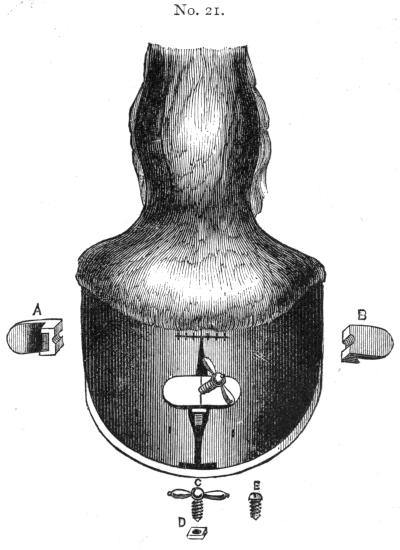
No. 21. Toe-Crack, after Treatment.
Explaining use of “Expansion Plate.”

No. 22. Thrush.
Before Treatment. After Treatment.
No. 23. Pumice Foot.
Before Treatment. After Treatment.
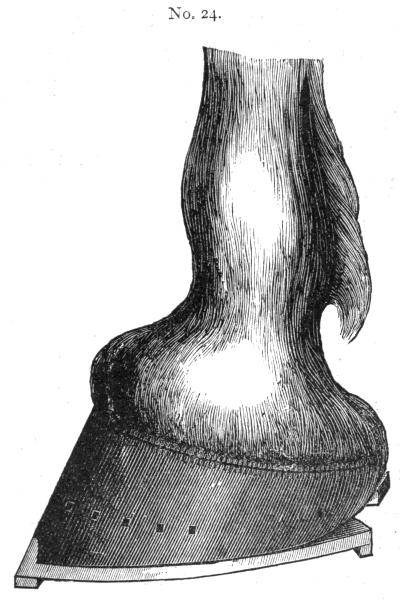
No. 24. Hoof-bound—Under Treatment.
Toe-crack, more common to heavy and draught horses, is caused by want of room; the space inside the wall of the foot not being large enough to accommodate the laminæ, it causes inflammation, and breaks out at the weakest point, which is the coronet, and extends downward to the toe, causing the foot to assume the appearance of a cloven foot. (See Plate No. 20.)
Treatment.—Shorten the toe as much as possible, and then pare the sole of the foot until it will yield to the pressure of the thumb. No pressure should be allowed within half an inch on each side of the crack on the toe, for the reason that the pressure on the toe prevents the coronet from uniting. Having prepared the sole of the foot, a fine shoeing knife should be used to remove the horn that is inclined to grow inward on each side of the crack, after which a groove under the coronet, extending on each side of the crack, will be made, and the notches on each side of the groove as already directed. A[477] firing-iron should be applied to cauterize the crack from the coronet downward. Then the crack should be cut away in the center, so as to allow the use of an “expansion plate,” as shown in Plate No. 21. This expansion plate can be made of brass or steel. It is composed of four pieces, as follows: A plate divided in the center into two equal parts, A and B (see Plate No. 21), and a thread cut in the center. Each part is made so as to fit dove-tailed into the crack, held in place with a screw C, and a burr D, underneath, to prevent the screw from pressing the laminæ of the foot. The screw, which has considerable power as a lever, forces the two plates apart, lifts up the wall of the foot which is pressing each side of the crack, and presses it outward. This being done, an open shoe should be fitted, wider than the foot, so as to expand it, which, together with the notches cut in the groove under the coronet, will cause a new and strong growth from each side of the crack, commencing at the coronet and extending downward.
The length of time required to effect a removal of the crack depends on the treatment and skill of the operator. If the foot is expanded by the plate with skill, and the nails in the shoe driven so as to prevent the wall of the foot from closing in on the crack, the plate may be removed at once; otherwise it should remain stationary, which can be done by substituting the small screw E, which will not prevent the horse from being used while under treatment. The use of the expansion plate is not necessary, unless the crack extends the whole length of the hoof. The crack extending from the coronet, partly down the front of the foot, should be treated at once, removing pressure by shortening the toe and expanding the foot, as already instructed; then, by means of the groove and notches, promote a new growth at the coronet.
Is a disease of the frog, most common to a foot which is hoof-bound or contracted, but all horses’ feet are subject to it when they are neglected.[479] The frog, pressed on each side by the bors of the foot, and from the overgrowth of the hoof, becomes inflamed, and the result is thrush. (See Plate No. 22.)
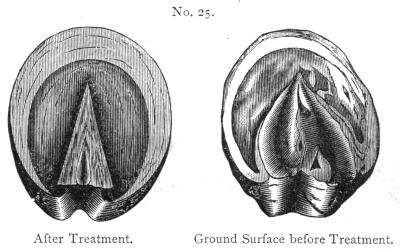
No. 25. Overgrowth of Hoof and Neglect.
After Treatment. Ground Surface before Treatment.
Treatment if the Hoof is Hoof-bound.—The farrier, after removing the shoe, should use his rasp, and lower the wall of the foot all around from heel to heel; then, by the free use of the knife, pare the foot to its natural size. Also pare around the frog until the sole of the foot yields to the pressure of the thumb, then open the heels and remove the pegs that grow on each side of the heels. All this should be done before a knife is used on the frog. After all pressure is removed by this paring operation, the condition of the frog will show how it was affected by pressure on each side.
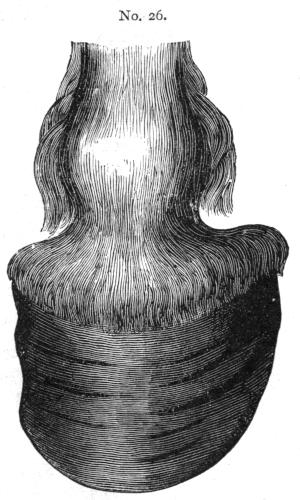
No. 26. Overgrowth of Hoof—Front View before Treatment.
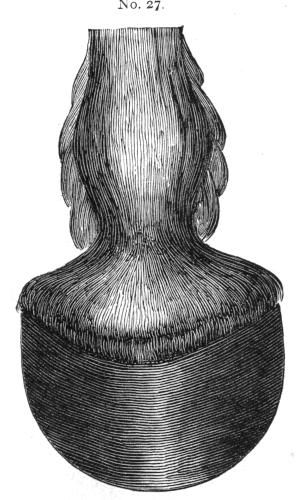
No. 27. Overgrowth of Hoof—Front View after Treatment.
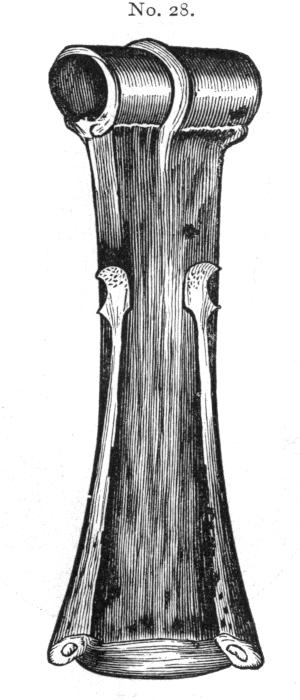
No. 28. Navicula.—Enlargement of Metacarpal Bone.
Next, by the use of the knife, cut a slice off the top of the frog, and carefully clean out the cleft, which suffers most on account of the direct pressure of the bors on each side of the frog. After this cleaning operation is performed, a warm poultice of flaxseed meal should be applied two or three times, according to the condition of the foot. When the poultice is removed, the foot should be washed out occasionally with castile soap and warm water, after which a little salt, ground into fine powder, should be forced into the cleft, and kept in by a mixture of tar and oakum as a dressing, after which an open shoe should be fitted so as to expand the foot gradually. This treatment should be pursued until a permanent cure is effected.
If the foot is in a state of contraction, it should be expanded under the instructions[484] already given. By this expansion all pressure is removed, and a permanent cure is easily effected by following the instructions already given.
No liquid remedies, such as butter of antimony, or chloride of zinc, should be used, as they dry up the foot before the inflammation is removed.
By reference to Plate No. 22 a good idea may be obtained of the manner of paring out a hoof suffering from thrush.
(See Plate No. 23) should always be pared out on each side of the frog until it yields to the pressure of the thumb. This paring should, however, be done immediately around the frog, leaving more than the usual ground surface (see plate After Treatment). The toe should be shortened as much as possible, and the heels cut out back. If the horse is lame a bor shoe is the best to protect the foot, with a leather[485] sole, and some spirits of tar as a moisture. This shoe should be renewed at least once a month, with a leather sole, until a cure is effected.
(Plate No. 24.) A horse that is hoof-bound is deprived of his free action, and resembles a horse that is foundered.
Treatment.—The foot should be pared out thoroughly, and on each side of the frog, until it yields to the pressure of the thumb. Open the heels and remove the bors that press the frog on each side, and cause the animal much pain.
The toe should be shortened, and if the foot is inclined to contraction, the shoe should be fitted wider than the foot, which, if done properly, will expand the foot (see article Contraction). The shoe should be a good, heavy, open one, well eased off at the heels. Having the foot prepared, the operation should next be performed around the coronet, as follows: If the[486] cartilages are hard, as they are generally from being pressed upwards, a groove should be made with a rasp immediately under the coronet, and extending all the way across from heel to heel, deep enough to draw blood. Next, with a fine knife cut notches across the groove at equal distances the whole length of the groove, and extending from the coronet downward.
By this operation, illustrated on Plate No. 24, the pressure is removed from the cartilages. After this a poultice of linseed meal should be applied around the coronet, which loosens all pressure and starts a new growth.
If the horse is lame from this disease the close cutting operation should be performed and the poultice applied one week; otherwise the operation need not be so severe.
Plates Nos. 25, 26, 27—Illustrations of Overgrowth of Hoof and Neglect before and after Treatment.—The illustration, “Before Treatment,” Plate No, 25, represents the ground surface of a foot operated upon, and “After Treatment”[487] represents the same foot after one pound of overgrowth had been removed from one foot. Plates Nos. 26 and 27 show the difference between the foot before and after treatment, and show the importance of being careful in observing a horse’s foot so as to prevent lameness, and the various diseases caused by neglect.
Plates Nos. 28 and 29—Enlargement of the Metacarpal Bone.—In a great many cases because the enlargement interferes with the free use of the flexor tendon, pressing it out of its proper place. A horse with a contracted foot suffers from this pressure when the shoe is fitted tight and brings the heels inward. The metacarpal bones extend from the back of the knee downward to the pastern joint, forming, as it were, a brace on each side. They become quite small as they extend downward, and the enlargement is generally found on the inside of the leg. (See Plate No. 28.)
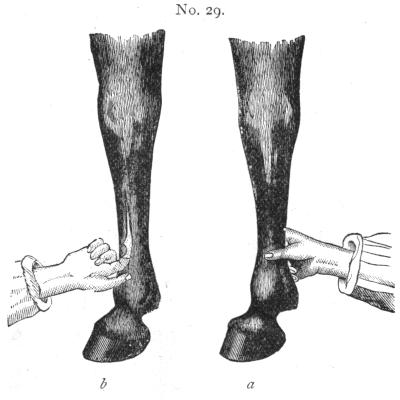
No. 29. Enlargement of the Metacarpal Bone.
a Showing how to find the enlargement.
b Showing the manner in which the incision is made, and the enlargement removed.
The enlargement may be discovered by running the hand downward from the knee, the thumb on the side and the forefinger on the[488] other, until it is felt (see Plate 29, “A”). If pressed and the horse yields to the pressure, it is a sure sign that he is affected, and he should be properly shod at once as if for contraction, or the enlargement should be removed. To do this, the horse should be in the following position:[489] First, with plenty of straw under him to prevent bruising; then he should be thrown on his side and fastened down, so as to allow the operator to make an incision with a fine pocket knife partly to the front and near where the enlargement is. This operation will not interfere with the tendons, or veins that extend upward from the foot. The incision having been made, the finger may be inserted, as shown in Plate No. 29, “B,” so as to raise the enlargement and make it visible. Then, with a pair of nippers, snap the end off with one motion. The incision should be closed, fastened together with a needle and silk thread; then apply a linen bandage and over this a woolen cloth, containing a little moisture, to prevent fever. A little sweet oil should be applied, to keep it clean while healing. The operation is not severe and is thoroughly effective.
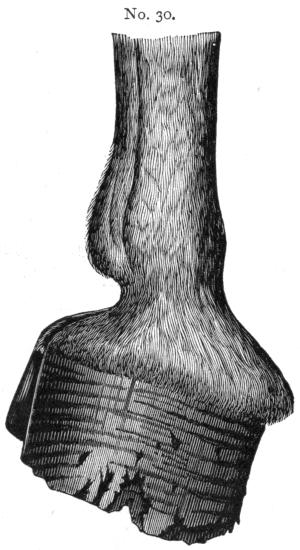
No. 30. A Foot that is Deprived of the free use of the Back Tendons.
Plates Nos. 30 and 31 represent a foot which has been deprived of the free use of the back tendons, caused by a sudden jar or misstep, causing a horse so affected to travel on his toe, and can be remedied only by a system of expanding the foot under the directions already given for contraction.
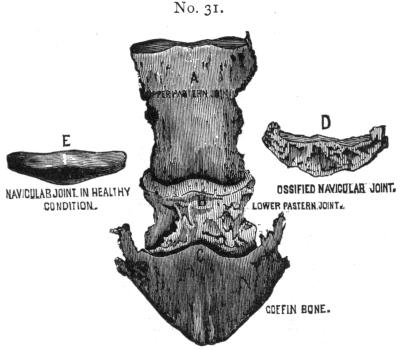
No. 31.
Ossified growth of Upper and Lower Pastern Joint, also Navicular Joint and Coffin-bone, in a foot which has been deprived of the free use of the back Tendons. See Plate No. 30.
After this a shoe should be fitted with a toe and no heels, for by raising the toe the bearing is thrown on the heels. If the action is heavy on the toe, the shoe should be provided with a steel toe-calk. This will prevent a horse from[492] traveling on his toe, and such a case, if taken in time, can be remedied, if not permanently cured, by simply fitting a shoe so as to throw the bearing on the heels.
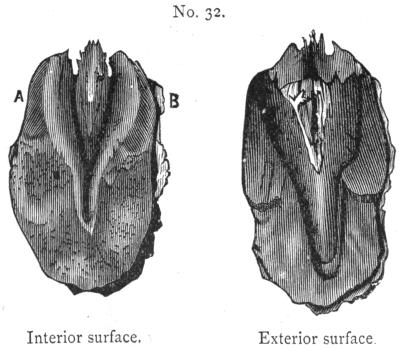
No. 32. The Sensitive Frog.
Interior surface. Exterior surface.
Plates Nos. 30 and 31 represent an aggravated case, which from neglect became incurable.
Plate No. 32 represents the exterior surface of the sensitive frog. The great principle of this system of paring the horse’s feet, is to remove all pressure from the frog. It should be protected[493] from all pressure, and such diseases as thrush and scratches may be avoided.
Plate No. 33 gives a sectional view of all the bones and tendons of the horse’s foot. Every blacksmith and farrier should thoroughly understand this and the anatomy of the horse’s foot, in order to be able to know exactly how to treat any disease which may be brought to their notice.
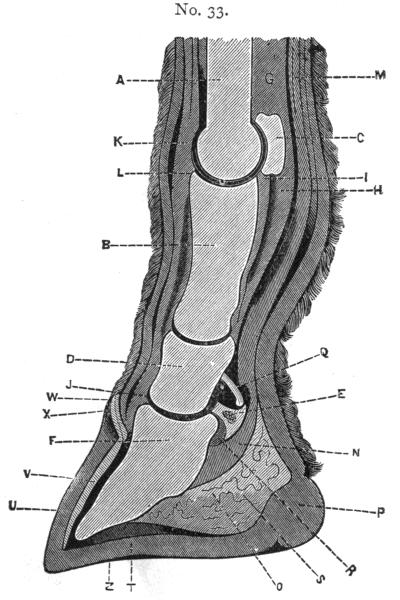
No. 33. Section of the Pastern and other Bones, Ligaments, etc.
A—Shank-bone.
B—Upper and larger pastern-bone.
C—Sesamoid-bone.
D—Lower or smaller pastern-bone.
E—Navicular or shuttle-bone.
F—Coffin-bone, or bone of the foot.
G—Suspensory ligament inserted into the sesamoid-bone.
H—Continuation of the suspensory ligament inserted into the smaller pastern-bone.
I—Small inelastic ligament lying down the sesamoid-bone to the larger pastern-bone.
K—A long ligament reaching from the pastern-bone to the knee.
L—Extensor tendon inserted into both the pastern and the coffin-bone.
M—Tendon of the perforating flexor inserted into the coffin-bone, after having passed over the navicular-bone.
N—Seat of the navicular-joint lameness.
O—Inner or sensible frog.
P—Cleft of the horny frog.
Q—A ligament uniting the navicular-bone to the smaller pastern.
R—A ligament uniting the navicular-bone to the coffin-bone.
S—Sensible sole between the coffin-bone and the horny side.
T—Horny sole.
U—Crust or wall of the foot.
V—Sensible laminæ to which the crust is attached.
W—Coronary ring of the crust.
X—The covering of the coronary ligament from which the crust is secreted.
Z—Place of bleeding at the toe.
The following recipes have been gathered from souses entitled to the fullest confidence, as remedies of value to all owners of horses, and are presented with the hope of doing good:
For several years past a disease has been more or less prevalent in various sections of this country, known to the Veterinary as epidemic catarrh or influenza. The symptoms of this disease are so various in different animals—no two being precisely alike—that a variety of opinions are current concerning it and its nature; and, as a consequence, various other diseases are often confounded with it. The usual or leading symptoms are a slight watery or[497] mucous discharge from the nose; eyelids presenting a reddish appearance; matter collects in the corner of the eyes; pulse feeble; great debility, as shown by the quick, feeble action of the heart—a symptom rarely absent; membrane of nose much reddened; sore throat and cough; occasionally the feet become fevered as in founder, causing much stiffness, and might be easily taken for that disease.
Treatment.—This being a typhoid disease, it requires a sustaining treatment, or success will be very doubtful. In the early stage of this disease, give the first two days ten drops of tincture of aconite, or bryonia, in a little water, every six hours; after which give a pail of water to drink, and, once a day, 1 oz. spirits of nitre, or 2 drams extract of belladonna; and give in the feed, three times a day, one of the following powders: gentian root, saltpetre, and anise seed, of each 1 oz.; sulphate of quinine, 1 dram; mix, and divide into eight powders. The throat should be bathed with mustard and vinegar; or with linseed oil, 3 oz., spirits of hartshorn, 1 oz.[498] Mix together. No hay or corn should be given, but scalded oats or wheat bran, with linseed tea, or oatmeal gruel, should constitute the diet. I would recommend a few carrots. But above all, good nursing is to be desired, and by strictly following the foregoing instructions a successful result is probable.
Fenugreek, cream of tartar, gentian, sulphur, saltpetre, resin, black antimony, and ginger, of each 1 oz.; cayenne ½ oz.; all finely pulverized. Mix thoroughly. It is used for yellow water, hide bound, colds, coughs, distemper, and all other diseases where a condition powder is needed. They carry off gross humors, and purify the blood.
Dose.—In ordinary cases one tablespoonful once a day. In extreme cases give twice daily. This powder has never failed to give entire satisfaction.
This is one of the most fatal diseases to which the horse is subject. It is propagated in most cases by contagion, the infection being disseminated by seed from the nasal discharge, not, as many suppose, by the breath. According to eminent foreign authors, the disease has its origin also in a vitiated state of the blood, and this may result from improper treatment or neglect of almost any disease to which he is liable. In its early stage it appears to be only a slight inflammation of the inner membrane of the nose, not, however, attended with the usual florid red characterizing inflammation, but of a paler hue, and afterwards becoming darker. The first marked symptom is a discharge from the nose, scarcely to be distinguished at first from the natural moisture, either by its color or consistence, and generally coming from one nostril only, and that the left one. In appearance it is thin and transparent, closely resembling the natural discharge, a little increased in quantity,[500] and sometimes continues in this doubtful stage for several weeks or months. Instances are indeed known where it has existed for several years before it became fully developed. In such cases it is attended with no loss of appetite, no cough, or apparent illness of any kind, with little enlargement of the glands under the jaw, and at the same time the horse is capable of communicating disease.
Too many of these horses, with a decided glanderous discharge from the nose and adherent glands under the jaw, are found on our roads, or are employed in agriculture, which (although they are otherwise in good health, and perform their work well) should not be permitted; for by such means the contagion is widely spread. No cough accompanies real glanders in any of its stages, except the last, which is usually soon cut short by death.
In addition to the preceding tokens for discovering at an early period the true glanders from other disorders, let the nostrils be closely examined. In the real glanders, the left or[501] running nostril will be found of a deeper color than ordinary, while the other, or dry nostril, is of a paler color, or almost white.
The reader must bear in mind the varied color of the nostril in deciding all cases of this character. Also that in colds, etc., both nostrils run.
Before the disease finishes its course, both sides of the nose and head become affected—the ulcers extend down the windpipe, and fasten upon the lungs. The virus, secreted by and discharged from the ulcers, is absorbed and carried through the whole system, and soon puts an end to the creature’s miserable existence. The best preventives of glanders are dry, clean, well-ventilated stables, moderate exercise, green food, when it can be procured, and roots in the winter.
The disease may be cured in its early stages, or before ulcers are formed in the nose, or the lumps under the jaw adhere to the bone, by turning the animal on a dry pasture, by proper attention to the bowels, and by use of alterative[502] medicines, to work the poisons out of the system. Should the bowels require loosening, give the common purge. For purifying the blood, the condition powder is the most effectual remedy. The owner must beware of putting the horse to hard labor too soon, after having been turned out as before directed, as the disease is liable to return on subsequent confinement, even after the running at the nose has entirely disappeared. It is conceded by all, that when this disease is once seated, it cannot be cured; and humanity dictates, and economy should prompt us to terminate the animal’s existence at once. This course has now become an imperative duty, as the fact is established that man is susceptible to the contagion; and there are numerous cases on record where those who have had the care of glandered horses have fallen victims to this disease.
This disease generally arises from nail wounds in the feet, or from sharp metallic substances taken into and wounding the stomach or intestines. The first symptoms of the disease are observed about the ninth or tenth day after the injury is done, which are a straggling or stiffness of the hind-legs, to which succeed in a few days the following: on elevating the head, a spasmodic motion of the membrane in the inner corner of the eye will be observed, showing little more than the white of the eye; the muscles of the jaws become rigid; the tongue is swollen, and the mouth is filled with saliva; the ears are erect, and the nose poked out; the nostrils expand; respiration becomes much disturbed; and finally, the jaws become firmly set, and the bowels constipated.
Treatment.—Tinct. of aconite, 2 drs.; tinct. of belladonna, 2 drs.; water, ½ oz. Mix, and give 40 drops every 4 hours on the tongue; keep a ball of aloes in the mouth for several days.[504] There is no fear of giving too much. I have known half a pound to be given in a few days with good success. Hydrocyandic acid, 20 drops in a little water, and put upon the tongue every four hours, is an excellent remedy. Foment the jaws with bags of hops steeped in hot water, and bathe the line of the back from the pole to the croup with mustard and vinegar. Be careful not to allow the animal to be unnecessarily excited by noises and confusion about him. Go about him quietly; keep a pail of bran slop before him all the time. If the foot has been injured, poultice with flaxseed meal, and keep the wound open until a healthy action has been established.
The discharge from the nose in Glanders will sink in water. In Distemper it will not.
This is generally the consequence of neglected catarrhal affections, worms, etc. For treatment, give twice each day Barbadoes aloes, 2 oz.; pulv. foxglove (or digitalis), 1 oz.; linseed meal, 13 oz. Mix with molasses. Dose, 1 oz.
Another remedy is, sal ammoniac, 1 oz.; squills, pulv., ½ oz.; aloes, pulv., 1 oz.; linseed meal, 16 oz.; mix with molasses, and divide into four balls; to be given one each night for four days.
Poultice the feet with mustard and flaxseed meal. Give internally of nux vomica, 1 oz.; pulv. gentian root, 1½ oz.; pulverized ginger, 1 oz. Mix and divide into 12 powders; give one every night in the feed, keep the body warm, and give no corn.
Give from 1 to 4 ounces of saltpetre, according to the severity of the case. For a severe case, draw about one gallon of blood from the neck; then drench with linseed oil, 1 quart; rub the fore-legs with water as hot as can be borne without scalding, continuing the washing till the horse is perfectly limber.
Resin, 4 oz.; beeswax, 4 oz.; honey, 2 oz.; lard, 8 oz.; melt these articles slowly, bringing gradually to a boil; remove from the fire, and slowly add a little less than a pint of spirits of turpentine, stirring all the time this is being added, and stir till cool. This is an extraordinary ointment for bruises of the flesh, or hoof, or broken knees, galls or bites, or when a horse is gelded to heal and keep off flies.
Take 2 oz. oil of spike; 2 oz. origanum; 2 oz. hemlock; 2 oz. wormwood; 4 ounces sweet oil; 2 oz. spirits ammonia; 2 ounces gum camphor; 2 oz. spirits turpentine; 1 quart proof spirits. Mix well and bottle for use. Cork tight. For sprains, bruises, or lameness of any kind, this liniment is unsurpassed. This is the same liniment, leaving out the turpentine, which has achieved so many wonderful cures for human ailment.
A more simple liniment can be made by putting into spirits of turpentine all the gum camphor it will cut. For ordinary purposes it is fit for use; but if you wish to reduce pain, add as much laudanum as there is turpentine.
Corrosive sublimate, quicksilver, and iodine, of each 1 oz., with sufficient lard to form a paste. Rub the quicksilver and iodine together, and add the sublimate, and finally add the lard, rubbing thoroughly. Shave off the hair the size of the bone enlargement, then grease all around it, but not where the bone is shaved off. This prevents the action of the medicine only upon the spavin; rub in as much of the paste as will lie on a five cent piece, each morning for four mornings only, and in from six to eight days the spavin will come out; then wash out the wound with suds, soaking well for an hour or two, which removes the poisonous effects of the medicine, and facilitates the healing, which can be done by any healing salve. I prefer the horse ointment to any other.
First take the harness apart, having each strap and piece by itself; then wash it with warm water and Castile soap. When cleansed, black each part with the following dye: 1 oz. extract of logwood; 12 grains bichromate of potash—both pounded fine; put into two quarts of boiling rain-water, and stir till all is dissolved. When cool, it may be used. It may be bottled and kept for future use, if desired. It may be applied with a shoe brush. When the dye has struck in, you may oil each part with neatsfoot oil, applied with a paint brush. For second oiling, use one-third castor oil and two-thirds neat’s-foot oil, mixed. A few hours after, wipe clean with a woolen cloth, which gives the harness a glossy appearance. This preparation does not injure the leather or stitching, but makes it soft and pliable, and obviates the necessity of oiling as often as is necessary by the ordinary method. When the harness is removed[510] from the horse, take a woolen cloth or chamois skin, kept for the purpose, and wipe off the dust and all moisture from rain or perspiration, and when the harness is nearly dry, rub the damper parts very thoroughly with a second cloth or skin, until they are quite soft and pliable.
The bits, and plated mountings, should be cleaned and rubbed with a slightly-oiled rag, before the harness is finally hung in its place; the harness should be protected from dust either by a covering of cloth, or by hanging in a closet. Whenever the leather becomes dry and hard, it should be cleaned and oiled according to the foregoing directions.
Barbadoes aloes, 1 lb.; syrup buckthorn, 3 oz.; cod-liver oil, 3 oz. Melt the whole, and stir till cool. In winter, add a little water, make into 18 pills, and give 1 every four hours, or as much as will move the bowels.
Take a quantity of mandrake root, bruise and boil it, strain and boil down until rather thick; then form an ointment, simmering with sufficient lard for the purpose. Anoint the swelling once a day until cured. It has cured them after they were broken out, by putting it in the pipes a few times; also, anointing around the sore.
Oxide of zinc, 4 drams; fresh lard, 1 oz.; carbolic acid, 6 grains. Melt the lard, and stir in the oxide of zinc, which must be very finely powdered; add the carbolic acid and mix thoroughly. Apply twice a day to the wound. This salve is very valuable for its healing properties, and will be found of special service, if there is any foul discharge.
Permanganate of potassa, 1 dram; pure water, 6 fluid ounces. Clean the sore once or twice a day, with a quart of water, to which a large tablespoonful of the wash has been added, using a soft sponge.
The discoloration of the solution indicates its complete loss of power as a disinfectant.
The bottle must be kept tightly corked, as impurities in the air will, in time, impair its value.
(For Man or Beast.)
Oils of cajeput, cloves, peppermint, anise, of each 1 oz.; of alcohol, 1 quart. Mix together, and bottle for use. Dose, for horse, 1 oz. every 15 minutes, in a little whisky and warm water, sweetened with molasses. Continue till relieved.
Dose for man, one teaspoonful.
The author of this work would not have the reader imagine that he is known to the popular world as a sporting man, but believing his book will come into the hands of not only lovers of the noble animal as a beast of burden, and highly prized by the honest yeomanry of this continent, but into the hands also of those who admire more for qualities of speed, as exhibited on the turf, deems it advisable to gratify the appetite of all who appreciate fast trotting, by devoting a corner to record the driving of all horses having a public record of 2.30, or better. Considerable trouble and expense has attended the research, and it embraces a complete list of horses that have shown on the turf since 1870, compiled in the most accurate manner, and alphabetically arranged.
| Abdallah, b. s. | 2.30 |
| Adelaide, b. m. | 2.22½ |
| Ajax, b. s. | 2.29 |
| Albert, blk. g. | 2.24¾ |
| Albion Boy, b. g. | 2.30 |
| Alice, b. m. | 2.25[514] |
| Allie West, blk. s. | 2.25 |
| Alton Boy | 2.29½ |
| [2]American Girl, b. m. | 2.16½ |
| Amy, b. m. | 2.22¼ |
| Amy B, b. m. | 2.30 |
| Annie Collins, b. m. | 2.26 |
| Arthur, blk. g. | 2.28¼ |
| Aurora, s. m. | 2.27 |
| Baby Boy, wh. g. | 2.30 |
| Badger Girl, g. m. | 2.25½ |
| Barney Kelley, b. g. | 2.26¼ |
| Bashaw, Jr. | 2.25 |
| Bashaw Maid, ch. m. | 2.30 |
| Basil Duke, cr. g. | 2.28½ |
| Bateman, b. g. | 2.27 |
| Bay Henry, b. g. | 2.30 |
| Bay Jack | 2.30 |
| Bay Sallie, b. m. | 2.30 |
| Bay Whalebone, b. g. | 2.26¼ |
| Bella, b. m. | 2.22 |
| Belle, b. m. | 2.28¼ |
| Belle Brasfield, b. m. | 2.25¼ |
| Belle Deane, blk. m. | 2.30 |
| Belle of Toronto, g. m. | 2.28½ |
| Ben Cummings, ch. s. | 2.26 |
| Ben Flagler, g. g. | 2.26½ |
| Ben Morrill, br. s. | 2.28 |
| Ben Smith, b. g. | 2.28½ |
| Ben Star, b. g. | 2.24¾ |
| Beppo, or J. W. Conley, b. g. | 2.24½ |
| Bertie, g. m. | 2.27 |
| Billy Hoskins, g. g. | 2.26¼ |
| Billy Lambertson, b. g. | 2.28¼ |
| Billy Platter, g. g. | 2.26 |
| Black Bird, blk. s. | 2.22 |
| Black George, blk. s. | 2.23¾ |
| Black Mack, blk. g. | 2.26½ |
| Black Swan, blk. m. | 2.28½ |
| Blanche, blk. m. | 2.23½ |
| Bodine, b. g. | 2.19¼ |
| Bonner, ch. g. | 2.23 |
| Breeze, b. g. | 2.25½ |
| Bristol Bill, g. g. | 2.29 |
| Bro. Jonathan, b. g. | 2.24¼ |
| Brown Dick, br. s. | 2.24½ |
| Brown Jack, br. g. | 2.28½ |
| Bully Brooks, b. g. | 2.30 |
| Buzz, br. g. | 2.28½ |
| Byron, s. s. | 2.25½ |
| Caledonia Chief, ch. s. | 2.29½ |
| California Dexter, b. g. | 2.27 |
| Calmar, b. g. | 2.30 |
| [2]Camors, blk. g. | 2.19¾ |
| Capitola, b. m. | 2.29½ |
| Captain, b. s. | 2.28 |
| Captain Jinks, s. g. | 2.30 |
| Carrie, b. m. | 2.24½[515] |
| Castle Boy, b. g. | 2.21 |
| Catskill Girl, b. m. | 2.28½ |
| Cattaraugus Chief, b. g. | 2.29½ |
| Chas. E. Loew, blk. s. | 2.25½ |
| Chas. Hinson, g. g. | 2.28 |
| Charlie Green, b. g. | 2.26¼ |
| Clara G., b. m. | 2.26 |
| Clarence, ch. g. | 2.27½ |
| Clementine, b. m. | 2.21 |
| Colbourne, dun. g. | 2.30 |
| Col. Barnes, ch. g. | 2.28½ |
| Col. Moulton, ch. s. | 2.28½ |
| Col. Russell, b. g. | 2.25¾ |
| Col. Pike, b. g. | 2.29½ |
| Comee, b. g. | 2.24½ |
| Commodore, b. g. | 2.25 |
| Commonwealth, br. s. | 2.24½ |
| Cozette, blk. m. | 2.23 |
| Crown Prince, wh. g. | 2.25 |
| Dan, br. g. | 2.28½ |
| Daniel Boone, g. g. | 2.28¾ |
| Dan Voorhies | 2.26 |
| Defiance, blk. s. | 2.29½ |
| Defiance, br. g. | 2.24¼ |
| Delhi, b. g. | 2.29½ |
| Denmark, br. g. | 2.30 |
| Derby, b. g. | 2.25½ |
| Dick Jamison, b. g. | 2.26 |
| Dinah, rn. m. | 2.30 |
| Doble, blk. s. | 2.28 |
| Dolly, b. m. | 2.30 |
| Don Elipha (buckskin mustang) | 2.30 |
| Dot, b. g. | 2.29¾ |
| Doubtful, g. g. | 2.29½ |
| Draco Prince, blk. s. | 2.24½ |
| Dreadnaught, ch. g. | 2.27½ |
| Duchess, b. m. | 2.28 |
| Duke, b. g. | 2.26½ |
| Dutchman, b. g. | 2.30 |
| Ella Wilson, b. m. | 2.30 |
| Ella Lewis, br. m. | 2.27 |
| Eva, b. m. | 2.25¼ |
| Ella Madden, b. m. | 2.26¾ |
| Ella Wright, b. m. | 2.24¾ |
| Everett Ray, b. g. | 2.25 |
| Edginton | 2.26 |
| Ed. White, p. g. | 2.27 |
| Easton Boy, wh. g. | 2.25½ |
| Ella Elwood, b. m. | 2.29 |
| Elmo, ch. s. | 2.27 |
| Fleetwood, ch. g. | 2.29 |
| Frank Wood, b. g. | 2.24 |
| Frank, br. m. | 2.27¼ |
| Factory Girl, b. m. | 2.29¼ |
| Flora Bell, b. m. | 2.22¾ |
| Flora Bell, ch. m. | 2.30 |
| Frank Palmer, b. g. | 2.26¼[516] |
| Fannie, ch. m. | 2.29 |
| Frank J., dun. g. | 2.23¾ |
| Frank Davis, | 2.30 |
| Frank Munson, | 2.30 |
| Frank Reeves, | 2.30 |
| Fox, b. g. | 2.30 |
| Fred Hooper, b. g. | 2.23 |
| Fleety Golddust, g. m. | 2.20 |
| Filbert, g. g. | 2.28 |
| Fanny Otis, b. m. | 2.28¾ |
| Falmouth Boy, b. g. | 2.29½ |
| Frank Ferguson, br. g. | 2.27 |
| Flora Shepard, b. m. | 2.30 |
| George Miller, b. g. | 2.30 |
| Gray Jack, g. g. | 2.28¼ |
| Glengarry, b. g. | 2.27 |
| George Treat, | 2.28½ |
| George M. Patchen, | 2.23½ |
| Gray Alex, g. g. | 2.28¾ |
| Gazelle, b. m. | 2.21 |
| Grace, b. m. | 2.27¼ |
| Goldsmith Maid, b. m. | 2.14 |
| George, b. g. | 2.24½ |
| Gen. Sherman, g. g. | 2.28¾ |
| Gold Leaf, s. g. | 2.28¼ |
| Gen. Grant, s. s. | 2.20 |
| Granville, ch. g. | 2.29 |
| Governor, b. g. | 2.30 |
| Gen. Howard, br. g. | 2.30 |
| [2]Gloster, b. g. | 2.17 |
| Geo. B. Daniels, s. g. | 2.24 |
| Grafton, ch. g. | 2.22¼ |
| Gen. Picton, g. g. | 2.30 |
| Gen. Love, s. s. | 2.30 |
| Gray Chief, g. g. | 2.26½ |
| Great Eastern, br. g. | 2.28¾ |
| Gen. Garfield, b. g. | 2.21 |
| Gray Eddy, g. g. | 2.27 |
| Gov. Sprague, blk. s. (4 years, public trial, 1 mile) | 2.21¼ |
| Grace Bertram, ch. m. | 2.29 |
| Grand Duchess, b. m. | 2.26½ |
| Henry, b. g. | 2.20¼ |
| Hannah D., b. m. | 2.27½ |
| Harry Mitchel, b. g. | 2.28¼ |
| H. C. Hill, br. g. | 2.25½ |
| Honesty, b. s. | 2.26 |
| Huntress, b. m. | 2.21¼ |
| Hattie, ch. m. | 2.30 |
| Hopeful, g. g. | 2.17¼ |
| Hotspur, b. g. | 2.23¾ |
| Hamperion, br. s. | 2.29½ |
| H. W. Genet, b. s. | 2.25½ |
| Huckleberry, b. g. | 2.26½ |
| Herod, br. g. | 2.29 |
| Hope, s. g. | 2.28 |
| Haviland, b. g. | 2.29½[517] |
| Honest Harry, m. g. | 2.25 |
| Honest Dutchman, | 2.26½ |
| Harry Harley, b. g. | 2.25¾ |
| Harvest Queen, b. m. | 2.29½ |
| Hal. Terrel, b. g. | 2.28¾ |
| Idol, ch. m. | 2.27¼ |
| Idol, b. m. | 2.23 |
| J. N. Mansua, b. g. | 2.29½ |
| Joe Udell, b. g. | 2.30 |
| John Stuart, b. g. | 2.30 |
| Joe Brown, g. s. | 2.26½ |
| Jerome, ch. g. | 2.28½ |
| Jas. Howell, Jr. | 2.24 |
| Jubilee Lambert, br. s. | 2.25 |
| Judge Fullerton, ch. g. | 2.18 |
| Joker, b. g. | 2.23 |
| Jennie, b. m. | 2.22½ |
| John H., b. g. | 2.23 |
| Jim Irving, b. g. | 2.23 |
| Jack Draper, g. g. | 2.29 |
| John W. Hall, ch. g. | 2.25 |
| Joe Green, b. s. | 2.29½ |
| John T. Rich, b. s. | 2.28 |
| John C. Fero, br. g. | 2.27½ |
| John Morrissey, ch. g. | 2.26½ |
| J. J. Bradley, b. g. | 2.25½ |
| [2]J. H. Burke, blk. g. | 2.27½ |
| J. D. McMann, b. g. | 2.28¾ |
| Jackson, b. s. | 2.27¾ |
| Joe, or Triumph, s. g. | 2.25¼ |
| John E., b. g. | 2.28¾ |
| Jay Gould, b. s. | 2.20½ |
| J. G. Blaine, blk. g. | 2.28¼ |
| Joe Coburn, | 2.30 |
| Judge Robertson, b. g. | 2.29 |
| John T., br. g. (fraud same as Huckleberry), | 2.29½ |
| [2]Kilburn Jim, b. s. | 2.23 |
| Ki-Ki, b. g. | 2.28 |
| Kittie D., b. m. | 2.26¼ |
| Kansas Chief, b. g. | 2.21½ |
| Kate Campbell, br. m. | 2.25½ |
| Kittie Cook, br. m. | 2.29½ |
| Kate Bennett, rn. m. | 2.29¼ |
| Lady Blanchard, g. m. | 2.26¼ |
| Lady Garfield, b. m. | 2.29½ |
| Lady Hughes, b. m. | 2.30 |
| [2]Lady Hamilton, b. m. | 2.30 |
| Lydia Thompson, b. m. | 2.26¼ |
| Little Longfellow, s. g. | 2.29¼ |
| License, ch. g. | 2.26½ |
| Lothair, blk. s. | 2.29½ |
| Lothair, br. g. (fraud same as Small Hope), | 2.28¼ |
| Little Gipsy, b. m. | 2.28 |
| Lew Ives, b. g. | 2.28 |
| Lady Mack, b. m. | 2.25[518] |
| Logan, s. s. | 2.28 |
| Lucille Golddust, b. m. | 2.19½ |
| Lady Dahlman, br. m. | 2.28 |
| Lizzie Keller, br. m. | 2.30 |
| Lady Thompson, | 2.28 |
| Lady Star, br. m. | 2.24¼ |
| Little Mack, br. s. | 2.28½ |
| Lady Griswold, g. m. | 2.29 |
| Lewinski, b. g. | 2.26¾ |
| Lady Emma, ch. m. | 2.28 |
| Lady Star, | 2.25 |
| Little Fred, b. g. | 2.25 |
| Lady Blanche, b. m. | 2.28¼ |
| Lady Turpin, blk. m. | 2.23 |
| Lottery, g. g. | 2.27 |
| Lulu, b. m. | 2.14¾ |
| Lady Williams, ch. m. | 2.28½ |
| Lady Banker, b. m. | 2.23 |
| Lady Snell, b. m. | 2.23¼ |
| Lida Picton, br. m. | 2.27½ |
| Lady Stout, ch. m. | 2.29 |
| Lew Scott, b. g. | 2.30 |
| Lady Elgin, g. m. | 2.27¾ |
| Lillie Shields, s. m. | 2.29½ |
| Lady Byron, blk. m. | 2.28 |
| Lady H., g. m. | 2.30 |
| Lady Maud, b. m. | 2.18¼ |
| Lady Ross, b. m. | 2.29¾ |
| Major Edsall, b. s. | 2.29 |
| Major Allen, s. g. | 2.24¼ |
| Mat. Smith, b. s. | 2.26½ |
| Mountain Boy, b. g. | 2.20¾ |
| Myron Perry, b. g. | 2.24½ |
| Mollie Morris, ch. m. | 2.22 |
| Mila Caldwell, s. m. | 2.26½ |
| Mack, g. g. | 2.28 |
| Mary A. Whitney, b. m. | 2.28 |
| May Howard, g. m. | 2.24½ |
| Molsey, b. m. | 2.21¾ |
| Mary Davis, b. m. | 2.26¼ |
| Music, ch. m. | 2.21¾ |
| Mollie, b. m. | 2.28¾ |
| Mystic, b. g. | 2.22 |
| Maud, b. m. | 2.29¾ |
| Medoc, g. g. | 2.28½ |
| Mambrino Star, b. g. | 2.28½ |
| Mambrino Gift, br. s. | 2.20 |
| Monarch, Jr., rn. s. | 2.25½ |
| Monroe, ch. s. | 2.28½ |
| Mac, br. g. | 2.27¾ |
| Magnolia, g. g. | 2.26¼ |
| Major Root, br. g. | 2.27 |
| Major King, s. g. | 2.30 |
| May Queen, b. m. | 2.20 |
| May Bird, blk. m. | 2.27 |
| Maggie Briggs, b. m. | 2.27 |
| Moscow, blk. g. | 2.28¾ |
| Mazoumanie, ch. g. | 2.27¼ |
| Mohawk, Jr., b. s. | 2.25 |
| Mary, b. m. | 2.28 |
| Newberlin Girl, b. m. | 2.29½ |
| None Such, s. m. | 2.25½[519] |
| Natchez, blk. g. | 2.30 |
| Nellie Gray, | 2.24 |
| Nellie Irwin, b. m. | 2.25 |
| Nick, br. g. | 2.29¾ |
| Nettie, b. m. | 2.18 |
| Nino, b. g. | 2.29¾ |
| Ned Forrest, blk g. | 2.28½ |
| Nellie, g. m. | 2.30 |
| Nellie Walton, b. m. | 2.26 |
| North Star Mambrino, | 2.26½ |
| Nettie Burlew, b. m. | 2.25½ |
| Nerea, s. m. | 2.23½ |
| Ned Wallace, b. s. | 2.29 |
| Ohio Boy, b. g. | 2.27¼ |
| Observer, ch. g. | 2.24¼ |
| Orient, s. g. | 2.24 |
| Oakland Maid, g. m. | 2.26 |
| Occident, br. g. | 2.16¾ |
| Prince Allen, ch. s. | 2.26½ |
| Patchen Chief, blk. s. | 2.25½ |
| Pownall Mare, br. m. | 2.29 |
| Pat Ring, | 2.28 |
| Polly, or Tackney | 2.26 |
| Phil Sheridan, blk. s. | 2.26½ |
| Pilot Temple, b. s. | 2.24½ |
| Parkis’ Abdallah, b. s. | 2.26¾ |
| Prince, rn. g. | 2.28 |
| Preston, dun. g. | 2.28½ |
| Planter, | 2.30 |
| Prospero, | 2.22½ |
| Pumpkin, | 2.27½ |
| Queen of the West, | 2.26¼ |
| Royal John, g. g. | 2.27½ |
| Red Dick, ch. g. | 2.28 |
| Rolla Golddust, b. g. | 2.25 |
| Rhode Island, br. s. | 2.23½ |
| [2]Ripon Boy, b. s. | 2.25¾ |
| Rosalind, b. m. | 2.21¾ |
| Ross, sp. g. | 2.29¾ |
| Rex Patchen, b. s. | 2.30 |
| Randall, ch. g. | 2.24½ |
| Red Cloud, b. g. | 2.18 |
| Rattler, b. g. | 2.27 |
| Royal George, g. g. | 2.26½ |
| Rosewood, br. m. | 2.27 |
| Rarus, b. g. | 2.20¾ |
| Rival, g. s. | 2.30 |
| Rutledge, b. g. | 2.30 |
| St. Elmo, g. g. | 2.29¼ |
| Sleepy John, b. g. | 2.24½ |
| Shakespeare, ch. s. | 2.30 |
| Susie Parker, b. m. | 2.27½ |
| Sentinel, b. s. | 2.29½ |
| Skinkel’s Hambletonian, b. s. | 2.28¾ |
| St. James, b. g. | 2.23¼ |
| Sam Purdy, b. g. | 2.23¼ |
| Spotted Colt, sp. g. | 2.25½ |
| Stump Puller, or Columbia Chief, blk. s. | 2.30 |
| Shepard Knapp, Jr., b. g. | 2.27¾[520] |
| Sisson Girl, blk. m. | 2.28½ |
| Star, s. g. | 2.30 |
| Snowball, wh. g. | 2.27½ |
| Scotland Maid, b. m. | 2.28½ |
| Silver Side, g. g. | 2.30 |
| Stewart Maloney, b. g. | 2.27 |
| Surprise, g. g. | 2.26 |
| Sam West, b. g. | 2.29 |
| Star of the West, bk. s. | 2.26½ |
| Smuggler, b. s. | 2.20 |
| Susie, s. m. | 2.25 |
| Sleepy Tom, b. g. | 2.30 |
| Simon, ch. g. | 2.30 |
| Snowflake, g. m. | 2.22 |
| Sir Wm. Wallace, b. s. | 2.27¾ |
| Swallow, b. m. | 2.30 |
| Sea Foam, g. m. | 2.24½ |
| Sunbeam, b. m. | 2.30 |
| San Bruno, br. g. | 2.25¼ |
| Silas Rich, s. s. | 2.28 |
| Sconchin, | 2.25¼ |
| Sensation, | 2.24½ |
| Sorrel Frank, | 2.28¾ |
| Sucker State, | 2.28¼ |
| St. Julien, b. s. | 2.22½ |
| Sciota Belle, br. m. | 2.28 |
| Tennessee, br. m. | 2.27 |
| Tanner Boy, g. g. | 2.27 |
| Twilight, wh. m. | 2.27¾ |
| Tom Wonder, br. g. | 2.29 |
| Tom Hendricks, | 2.30 |
| Thos. L. Young, ch. g. | 2.19½ |
| Tom Keeler, b. g. | 2.26 |
| Thos. Jefferson, blk. s. | 2.23 |
| Tom Britton, br. g. | 2.27½ |
| Tom Walter, s. g. | 2.29 |
| Tom Moore, b. g. | 2.28 |
| T. A., b. g. | 2.28 |
| Tom Brown, s. g. | 2.27½ |
| Unknown, ch. g. | 2.23 |
| Viola, b. m. | 2.28 |
| Vanity Fair, b. g. | 2.24¼ |
| Western, b. g. | 2.30 |
| Western Girl, b. m. | 2.27 |
| W. B. Whitman, or Billy Barr, | 2.23¾ |
| W. K. Thomas, g. g. | 2.26½ |
| W. H. Allen, b. s. | 2.23¼ |
| Winthrop Morrill, Jr. | 2.28¾ |
| White Cloud, wh. g. | 2.27½ |
| Whitestockings, | 2.30 |
| Westfield, ch. g. | 2.26½ |
| Wild Oats, br. g. | 2.29¼ |
| Wellesley Boy, b. g. | 2.26¾ |
| Whalebone, b. g. | 2.29 |
| Young Bruno, b. g. | 2.22¾ |
| York State, b. g. | 2.23¼ |
| Young Rattler, | 2.30 |
| Young Magna, b. g. | 2.29 |
| Young Grafton, ch. h. | 2.30 |
| Zephyr, br. m. | 2.30 |
[2] Dead.
Rule 1.—Mandate.—All trotting and pacing engagements and performances over the several courses which are, or shall be represented by membership in the “National Association for the Promotion of the Interests of the American Trotting Turf,” and each and every person who shall in any way be concerned or employed therein, as well as all associations and proprietors themselves who are or shall become members of said National Association, shall be governed by the following rules from and after February 4th, 1874. [See also Articles 12 and 13 of By-Laws.]
Rule 2.—Entries.—All entries for premiums must be made under cover, enclosing the entrance money for purses and forfeits in sweepstakes, and sealed and addressed to or deposited with the Secretary, or other person authorized to receive the same, at such time and place as shall have been prescribed.
Notices by telegraph of intention to enter shall be received up to the hour advertised for closing, and all such entries shall be eligible, provided the entrance fee specified shall be paid in due course, by mail or otherwise. [See also Art. 17 of By-Laws.]
It shall be the duty of the Secretary, or other person authorized, to prepare the list of entries for publication, comprising all information necessary for the enlightenment of the general public and parties to the race; and all entries as aforesaid shall be opened and announced at a public meeting, of which reasonable notice by advertisement or otherwise shall be given to the parties in interest.
Rule 3.—Entrance Fee.—The entrance fee shall be 10 per cent. of the purse, unless otherwise specified; and any person failing to pay his entrance dues may, together with his horse or horses, be suspended until they are paid in full, which shall be with an addition of 10 per cent. penalty and interest at 7 per cent. per annum until paid—the penalty to go to the National Association. Provided, that no such suspension imposed after April 1, 1874, shall be lawful unless imposed within sixty days from the close of the meeting; and further provided, that any entry which shall be accepted upon conditions differing from those applied by the terms of the race to other entries in the same class shall be regarded a “conditional entry,” and as such shall be void. And any associate member who shall accept any such conditional entry, shall, upon satisfactory evidence produced to the Board of Appeals, be[522] held to forfeit to the National Association 20 per cent. of the amount of the purse in which such conditional entry has been accepted.
Rule 4.—How Many to Enter.—In all purses three or more entries are required, and two to start, unless otherwise specified.
Rule 5.—Horses to be Eligible when Entries Close.—A horse shall not be eligible to start in any race that has beaten the time advertised prior to the closing of the entries for the race in which he is entered, unless otherwise specified in the published conditions.
Horses shall not be eligible if the time specified has been beaten by them at a greater distance; that is, a horse having made two miles in five minutes is eligible for a 2:30 race, but not eligible for a race limited to horses of a slower class than that.
Rule 6.—Description and Name of each Horse Required.—An accurate and satisfactory description of each entry will be required, and shall be in the following form, to wit:
Color.—The color and marks shall be accurately given.
Sex.—It shall be distinctly stated whether the entry be a stallion, mare, or gelding, and the names of the sire and dam shall be given in all cases (and when unknown shall be so stated in the entry), under penalty of $25 fine for each omission. And the pedigree so given shall be published by the associate member with the advertisement of entries.
Name of Horse.—Every horse shall be named, and the name correctly and plainly written in the entry; and after trotting in a public race such name shall not be changed, except by permission of the Board of Appeals, and upon payment of a recording fee of $10, the fee to go to the National Association; for each violation of this requirement a fine of $100 shall be imposed, together with suspension or expulsion; and if the horse has ever trotted in a public race the last name under which he or she trotted shall be given with the entry; and if the name has been changed within two years, each name he or she has borne during that time must be given; and if any horse without a name has ever trotted in a public race, mention must be made in the entry of a sufficient number of his or her most recent performances, to enable interested parties to identify the animal; provided, that it shall not be necessary to furnish any one association or proprietor with the same record the second time.
In entries and nominations hereafter made, the words “no name” shall not be received as a name; neither shall such descriptive words as “bay horse,” “gray mare,” &c., be allowed as names, under penalty of a fine not to exceed the entrance fee, to be imposed on the member who violates this restriction.
A horse having once been named, shall not again start in a race on any course in the United States or Canada without a name, nor under a different name, unless the foregoing requirements have been complied with.
Double Teams.—In all double-team races the entry must contain the name and description of each horse, in the manner provided for entry of single horses.
Rule 7.—Name and Address.—The residence and post-office address, in full, of the person or persons in whose name an entry is made, and if he or they be not the owner, then that of the owner or owners also must accompany each nomination.
Rule 8.—Entries that Cannot Start.—As many horses may be entered by one party, or as many horses trained in the same stable as may be desired, but only one that has been owned or controlled in whole or in part by the same person or persons, or trained in the same stable within ten days preceding the race, can start in any race of heats.
Rule 9.—No purse for a “Walk Over.”—No purse will be awarded for a “walk over,” but in cases where only one of the horses entered for any premium shall appear on the course, he shall be entitled to his own entrance money and to one-half of the entrance money received from all other horses entered for said premium.
Rule 10.—In Case of Death, Engagements Void.—All engagements, including obligations for entrance fees, shall be void upon the decease of either party or horse, so far as they shall affect the deceased party or horse; but forfeits, also matches made play or pay, shall not be affected by the death of a horse.
Rule 11.—Match Races.—In all match races these rules shall govern, unless the contrary be expressly stipulated and assented to by the club, association, or proprietor of the course over which the race is to come off.
Rule 12.—When Matches Become Play or Pay.—In all matches made to come off over any of the associate courses, the parties shall place the amount of the match in the hands of the stakeholder one day before the event (omitting Sunday) is to come off, at such time and place as the club, association, or proprietor, upon application may determine, and the race shall then become play or pay.
Rule 13.—Purse or Stakes Wrongfully Obtained.—A person obtaining a purse or stake through fraud or error shall return it to the Treasurer if demanded within one year, or be punished as follows: He, together with the parties implicated in the wrong, and the horse or horses, shall be expelled until such demand is complied with, and such stake or purse shall be awarded to the party justly entitled to the same.
Rule 14.—Fraudulent Entries, or Meddling with Horses.—Any person found guilty of dosing or tampering with any horse, or of making a fraudulent entry of any horse, or of disguising a horse with intent to conceal his identity, or being in any way concerned in such a transaction, shall be expelled.
Any horse that shall have been painted or disguised, to represent another or a different horse, or shall have been entered in a purse in which he does not belong, shall forfeit the entrance money and be expelled.
Rule 15.—Reward.—A reward of $50 will be paid to the person who shall first give information leading to the detection and conviction of any fraudulent entry and the parties thereto, to be paid out of the funds of the National Association for the Promotion of the Interests of the American Trotting Turf, by the Treasurer, upon the decision and order of the Board of Appeals; provided, that this shall not be construed to extend to courses outside of this Association.
Rule 16.—Protests.—Protests maybe made verbally before or during a race, and shall be reduced to writing, and shall contain at least one specific charge, and, when required, a statement of the nature of the evidence upon which they are based, and they shall be filed with the Judges, Association, or proprietor before the close of the meeting.
The Judges shall in every case of protest demand that the rider or driver, and the owner or owners, if present, shall immediately testify under oath, in the manner hereinafter provided; and in case of their refusal to do so, the horse shall not be allowed thereupon to start or continue in that race, but shall be considered and declared ruled out, with forfeit of entrance money.
But if the parties do comply, and take the oath as herein required, unless the Judges find conclusive evidence to warrant excluding the horse, they shall allow him to start or continue in the race under protest, and the premium, if any is won by that horse, shall be retained a sufficient length of time (say three weeks) to allow the parties interested a chance to sustain the allegations of the protest, or to furnish information which shall warrant an investigation of the matter by the associate member, or the Board of Appeals, and all outside bets on such horse shall be held in abeyance pending the decision of such protest; provided, that where no action as aforesaid has been taken to sustain a protest, during three weeks, the associate member shall proceed as if such protest had not been made.
In any heat which such protested horse shall win, the Judges shall waive the application of a distance as to all other horses, except for “fouls” defined in Rule 48.
When a protest is presented before or during a race, and the parties refuse to make the prescribed oath, if the Judges believe the refusal is designed to favor a fraud, they may require the horse under protest to start or continue in the race.
Any person found guilty of protesting a horse falsely and without cause, or merely with intent to embarrass a race, shall be punished by a fine not exceeding $100, or by suspension not to exceed one year, or by expulsion.
When a protest has been duly made, or any information lodged with the Judges in support of a protest, alleging an improper entry or any act prohibited or punishable under these rules, the same shall not be withdrawn or surrendered before the expiration of three weeks, without the approbation of the association or proprietor of the course upon which such protest or information was produced; and if any association or proprietor shall permit such a withdrawal of protest or information, with a corrupt motive to favor any party who shall be affected by the same, the association or proprietor so permitting, if convicted thereof by the Board of Appeals, shall be expelled from all connection with the National Association.
Associations or proprietors shall be warranted in retaining the premium of any horse, during the time herein mentioned, without any formal protest, if before it is paid they shall receive information in their judgment tending to establish fraud.
The oath required in answer to protest shall be in the following form, to wit:
I ________ of ________ in the County of ________ State of ________ on oath depose and say that I am the ________ of the ________ called ________ the same entered in a purse for horses that have never trotted better than ________ minutes and ________ seconds, to be trotted this day on this course, and the same that has been protested, and to which protest this affidavit is in answer, hereby declare and affirm that to the best of my knowledge and belief said before-mentioned horse is eligible to start or compete in the race aforesaid; and that I fully believe all the provisions and conditions required in the rules and regulations for the government or trials of speed over this course were fully and honestly complied with in making the entry aforesaid.
Given under my hand, at ________ this ________ day of ________ A. D. 187__.
________________
Subscribed and sworn to before me, this ________ day of ________ A. D. 187__.
________________
Justice of the Peace.
[Note.—In the absence of a Justice of the Peace, if this oath be administered by an officer of the association, or one of the Judges of the race, it will be considered sufficient for the purposes of the National Association.]
Rule 17.—When Horses Shall not be Drawn.—No horse shall be drawn except by permission of the Judges of the race, under penalty of being expelled, unless at or before seven o’clock P. M. of the day preceding the race (omitting Sunday), the proper party shall have lodged with the President, Secretary, or proprietor of the course, a written notice of his intention not to start, after which notice the horse so drawn shall be ineligible to start in the race.
Parties having two or more entries in one race shall elect which they will not start, and notify their decision at the same time, in the same manner, and under the same penalty as provided above.
Rule 18.—Power of Postponement.—In case of unfavorable weather, or other unavoidable cause, each association or proprietor shall have power to postpone to the next fair day and good track (omitting Sunday), all purses or sweepstakes, or any race to which they have contributed money, upon giving notice thereof; and they may exercise this power before or after the race has commenced. [See also Rule 19.]
Rule 19.—No Trotting After Dark.—No heat shall be trotted when it is so dark that the horses cannot be plainly seen by the Judges from the stand, but all such races shall be continued by the Judges to the next fair day (omitting Sunday), at such hour as they shall designate.
In all matches and stakes, the above rule shall govern, unless otherwise especially agreed between the parties and the association or proprietors.
Rule 20.—Weights and Weighing.—Every horse starting for purse, sweepstake, or match, in any trotting or pacing race, shall carry, if to wagon or sulky, 150 lbs., exclusive of harness: and if under the saddle, 145 lbs., the saddle and whip only to be weighed with the rider.
Riders and drivers shall weigh in the presence of one or more of the Judges previous to starting for any race, and after each heat shall come to the starting stand, and not dismount or leave their vehicles without permission of the Judges, and those who are deficient in bodily weight shall be re-weighed after each heat. Any rider or driver not bringing in his required weight shall be distanced, unless such decision shall be deemed to favor a fraud. But a rider or driver thrown or taken by force from his horse or vehicle, after having passed the winning-post, shall not be considered as having dismounted without permission of the Judges, and if disabled may be carried to the Judges’ stand to be weighed, and the Judges may take the circumstances into consideration and decide accordingly. And the riders or drivers who shall carry during the heat and bring home with them the weights which have been approved or announced correct and proper by the Judges, shall be subject to no penalty for light weight in that heat; provided the Judges are satisfied the mistake or fault was their own, and that there has been no deception on the part of the rider or driver who shall be deficient in weight; but all parties shall thereafter carry the required weight.
Rule 21.—Handicaps and Miscellaneous Weights.—In matches or handicaps, where extra or lesser weights are to be carried, the Judges shall carefully examine and ascertain before starting, whether the riders, drivers or vehicles are of such weights as have been agreed upon or required by the match or handicap, and thereafter the riders and drivers shall be subject to the same penalties and conditions as if they were to carry the weights prescribed by the rules.
Rule 22.—When Riders and Drivers are Overweight.—If the bodily weight of any rider or driver shall be found to exceed that which is prescribed in the rules, or that which is required by the conditions of the race, and the overweight shall exceed twenty pounds, it shall be announced from the stand before the heat; and the judges shall have power, if in their belief such extra weight was imposed on the horse for an improper or fraudulent purpose, to substitute another rider or driver of suitable weight; and if they believe the horse has been prejudiced in the race by such overweight, he shall not be allowed to start again or continue in the race, and all outside bets on such horse shall be declared off. [See also Rule 28.]
A horse prevented by this rule from continuing in the race shall not be distanced, but ruled out.
Rule 23.—Length of Whips.—Riders and drivers will be allowed whips not to exceed the following lengths: For saddle horses, 2 ft. 10 in,; sulkies, 4 ft. 8 in.; wagons, 5 ft. 10 in.; double teams, 8 ft. 6 in.; tandem teams and four-in-hand, unlimited: snappers, not longer than three inches, will be allowed in addition to the foregoing measurement.
Rule 24.—Judges’ Stand.—None but the Judges of the race in progress, and their assistants, shall be allowed in the Judges’ stand during the pendency of a heat, except members of the Board of Appeals.
Rule 25.—Selection of Judges.—[See also Art. 13 of By-Laws.] In every exhibition or race, over any course represented in the National Association, each course for itself, through the proprietor or association controlling the same, shall choose or authorize the selection of three (3) competent Judges, for the day or race, who shall understand the rules of the said National Association, and shall rigidly enforce the same; and all their decisions shall be subject to and in conformity with said rules.
Any person having any interest in, or any bet dependent upon the result of a race, or having any interest in either of the horses engaged therein, shall thereby be disqualified and restricted from acting as a Judge in that race. And if any person who is thus disqualified shall intentionally and deceptively violate this restriction, he shall, upon conviction thereof by the Board of Appeals, be adjudged guilty of a dishonorable act, for which he shall be expelled from every course represented in said National Association.
Rule 26.—Authority of Judges.—The Judges of the day or race shall have authority, while presiding, to appoint distance and patrol judges and timers; to inflict fines and penalties, as prescribed by these rules; to determine all questions of fact relating to the race over which they preside; to decide respecting any matters of difference between parties to the race, or any contingent matter which shall arise, such as are not otherwise provided for in these rules; but all their decisions shall be in strict conformity with the rules, or with the principles thereof. They shall have control over the horses about to start, and the riders or drivers and assistants of the horses, and, in the absence of other provision in these rules, they shall have authority to punish by a fine not exceeding $100, or by suspension or expulsion, any such person who shall fail to obey their orders or the rules.
Rule 27.—Distance and Patrol Judges.—In all races of heats there shall be a Distance Judge appointed by the Judges of the race or by those in authority, who shall remain in the distance stand during the heats, and immediately after each heat shall repair to the Judges’ stand and report to the Judges the horse or horses that are distanced, and all foul or improper conduct, if any has occurred under his observation.
Patrol Judges may be similarly appointed, and it shall be their duty to repair in like manner to the Judges’ stand, and report all foul or improper conduct, if any has occurred under their observation.
Rule 28.—Powers and Duties of Judges.—The Judges shall be in the stand fifteen minutes before the time for starting the race; they shall weigh the riders or drivers, and determine the positions of the horses, and inform each rider or driver of his place, before starting; they may require the riders and drivers to be properly dressed; they shall be prepared to take the time of each heat in the race, and they may appoint some suitable person or persons to assist them in that respect, and the time so taken shall be recorded and announced in conformity with these rules. [See also Rules 39 and 40, and Art. 13 of By-Laws.]
The Judges shall ring the bell, or give other notice, ten minutes previous to the time announced for the race to come off, which shall be notice to all parties to prepare for the race at the appointed time, when all the horses must appear at the stand,[528] ready for the race, and any rider or driver failing to obey this summons may be punished by a fine not exceeding $100, or his horse may be ruled out by the Judges and considered drawn; but in all stakes and matches a failure to appear promptly at the appointed time shall render the delinquent party liable to forfeit.
The result of a heat shall not be announced until the Judges are satisfied as to the weights of the riders or drivers, and sufficient time has elapsed to receive the reports of the Distance and Patrol Judges.
The Judges shall not notice or consider complaints of foul from any person or persons except the Distance and Patrol Judges appointed by themselves or by those in authority, and from owners, riders, or drivers in the race.
If the Judges believe that a horse is being or has been “pulled,” or has been ridden or driven in other respects improperly, with a design to prevent his winning a heat which he was evidently able to win, and that such act was done on the part of the rider or driver for the purpose of throwing the race, or to perpetrate or aid a fraud, they may declare that heat void, and they shall have power to substitute a competent and reliable rider or driver for the remainder of the race, who shall be paid a reasonable compensation for his services, but not to exceed $50; and any professional rider or driver who, without good and sufficient reason, refuses to be so substituted, may be fined, suspended, or expelled, by order of the Judges and upon approval of the Board of Appeals; and if the result and circumstances of the race shall confirm their belief, the rider or driver so removed shall be expelled by the Judges. And at the close of the race, if they are warranted under the foregoing circumstances in deciding that such improper conduct has changed the result of the race to the prejudice of innocent parties, they shall declare all outside bets “off,” and if the owner or person or persons controlling the offending horse shall be a party or parties to such fraud, he or they, together with the horse, shall be punished by expulsion. [See also Rules 22 and 48.]
Rule 29.—Starting and Keeping Positions.—No rider or driver shall cause unnecessary delay after the horses are called up, either by neglecting to prepare for the race in time, or by failing to come for the word, or otherwise; and in scoring, if the word is not given, all the horses in the race shall immediately turn, at the tap of the bell or other signal given, and jog back for a fresh start. But there shall be no recall after the starting word or signal has been given. Provided, however, that if the Judges shall through any error give signal of recall, after having given the word, Distance shall be waived in that heat, except for foul riding or driving.
When the Judges are prevented from giving a fair start by a horse or horses persistently scoring ahead of others, or being refractory, or from any other fault of either horse, rider, or driver, it shall be their duty, after three scorings, to select one of the contending horses, of average speed compared with the others, and no driver shall come up in advance of said horse before crossing the score.
No driver shall be allowed to sponge out his horse or horses oftener than once in five times scoring.
If these requirements are not complied with on the part of any rider or driver, the Judges may not only start the race, or give the word without regard to the absence or position of the offending party or parties, but the offender may be punished by a fine not exceeding $100, or by suspension not to exceed one year.
In all cases, the starting word or signal shall be given from the Judges’ stand, and in no instance shall a standing start be given.
When, through any fault of either horse, rider, or driver, the Judges are prevented from giving a fair and prompt start, they shall warn the faulty party of the penalties to which he is subject, and if such warning is not heeded, they shall rigidly enforce said penalties.
The horse winning a heat shall take the pole (or inside position) the succeeding heat, and all others shall take their positions in the order assigned them in judging the last heat. When two or more horses shall make a dead heat, the horses shall start for the succeeding heat in the same positions they occupied at the finish of the dead heat.
In coming out on the homestretch the foremost horse or horses shall keep the positions first selected, or be liable to be distanced; and the hindmost horse or horses, when there is sufficient room to pass on the inside or anywhere on the homestretch, without interfering with others, shall be allowed to do so, and any party interfering to prevent him or them shall be distanced.
If a horse, in attempting to pass another on the homestretch, should at any time cross or swerve, so as to impede the progress of a horse behind him, he shall not be entitled to win that heat.
Although a leading horse is entitled to any part of the track, except after selecting his position on the homestretch, he shall not change from the right to the left, or from the inner to the outer side of the track, during any part of the race, when another horse is so near him that in altering his position he compels the horse behind him to shorten his stride, or causes the rider or driver of such other horse to pull him out of his stride; neither shall any horse, rider, or driver, cross, jostle, or strike another horse, rider, or driver, nor swerve or do any other thing that impedes the progress of another horse; nor shall any horse, in passing a leading horse, take the track of the other horse so soon after getting the lead as to cause the horse passed to shorten his stride.
In any heat wherein there shall be a violation of any of these restrictions, the offending horse shall not be entitled to win the heat, and he shall be placed behind all other horses in that heat. And if the impropriety was intentional on the part of the rider or driver, the offending horse may be distanced, and the rider or driver shall be suspended or expelled. [See also Rule 48.]
Rule 30.—Horses Breaking.—When any horse or horses break from their gait in trotting or pacing, their riders or drivers shall at once pull them to the gait in which they were to go the race, and any party failing to comply with this requirement, if he come out ahead, shall lose the heat, and the next best horse shall win the heat; and whether such breaking horse come out ahead or not, all other horses shall be placed ahead of him in that heat, and the Judges shall have discretionary power to distance the offending horse or horses, and the rider or driver may be punished by a fine not to exceed $100, or by suspension not exceeding one year.
Should the rider or driver comply with this requirement, and the horse should gain by a break, twice the distance so gained shall be taken from him at the coming out; but this provision must not be so construed as to shield any trotting or pacing horse from punishment for running.
In case of any horse (in a trotting race) repeatedly breaking, or running, or pacing, while another horse is trotting, the Judges shall punish the horse so breaking, running, or pacing, by placing him last in the heat, or by distancing him.
A horse breaking at or near the score shall be subject to the same penalty as if he broke on any other part of the track.
Rule 31.—Relative to Heats and Horses Eligible to Start.—In heats, one, two, three, or four miles, a horse not winning one heat in three, shall not start for a fourth, unless such horse shall have made a dead heat. In heats best three in five, a horse not winning a heat in the first five shall not start for a sixth, unless said horse shall have made a dead heat. But where ten or more horses start in a race, every horse not distanced shall have the right to compete until the race is completed—subject, however, to all other penalties in these rules.
Rule 32.—Dead Heats.—A dead heat shall be counted in the race, and shall be considered a heat which is undecided only as between the horses making it, and it shall be considered a heat that is lost by all the other horses contending therein; and the time made in a dead heat shall constitute a record for each horse making such dead heat.
Whenever each of the horses making a dead heat would have been entitled to terminate the race had he won said dead heat, they only shall start again; and, in that case, each of the horses thus prevented from starting shall retain his position in the award of premiums as if said dead heat had been decided in favor of one of the horses which made the same a “dead heat.”
A horse prevented from starting by this rule shall not be distanced, but ruled out.
Rule 33.—Time Between Heats.—The time between heats shall be twenty minutes for mile heats; and for mile heats best three in five, twenty-five minutes; and for two-mile heats, thirty minutes; for three-mile heats, thirty-five minutes; and should there be a race of four-mile heats, the time shall be forty minutes.
After the first heat the horses shall be called five minutes prior to the time of starting.
Rule 34.—Time Allowed in Case of Accidents.—In case of accidents, ten minutes shall be allowed; but the Judges may allow more time when deemed necessary and proper.
Rule 35.—Collision and Break-Down.—In case of collision and break-down, the party causing the same, whether willfully or otherwise, may be distanced; and if the Judges find the collision was intentional or to aid fraud, the driver in fault shall be forthwith suspended or expelled, and his horse shall be distanced; but, if necessary to defeat fraud, the Judges may direct the offending horse to start again.
No horse but the offending one shall be distanced in such a heat, except for foul driving.
The Judges in a concluding heat, finding that a collision involved a fraudulent object, may declare that heat void. [See also Rule 48.]
Rule 36.—Placing Horses.—A horse must win a majority of the heats which are required by the conditions of the race to be entitled to the purse or stake; but if a[531] horse shall have distanced all competitors in one heat, the race will then be concluded, and such horse shall receive the entire purse and stakes contended for.
When more than one horse remains in the race entitled to be placed at the finish of the last heat, the second best horse shall receive the second premium, if there be any; and if there be any third or fourth premium, etc., for which no horse has won and maintained a specific place, the same shall go to the winner; provided, that the number of premiums awarded shall not exceed the number of horses which started in the race.
The foregoing provisions shall always apply, in such cases, unless otherwise stated in the published conditions of the race.
In deciding the rank of horses other than the winner, as to second, third, and fourth places, etc., to be assigned among such as remain in the race entitled to be placed at the conclusion of the last heat thereof, the several positions which have been assigned to each horse so contending shall be considered as to every heat in the race—that is, horses having won two heats, better than those winning one; a horse that has won a heat, better than a horse only making a dead heat; a horse winning one or two heats and making a dead heat, better than one winning an equal number of heats but not making a dead heat; a horse winning a heat or making a dead heat and not distanced in the race, better than a horse that has not won a heat or made a dead heat; a horse that has been placed “second” twice, better than a horse that has been placed “second” only once, etc.
When two or more horses shall be equal in the race at the commencement of a final heat thereof, they shall rank as to each other as they are placed in the decision of such final heat.
In case these provisions shall not give a specific decision as to second and third money, etc., the Judges of the race are to make the awards according to their best judgment, but in conformity with the principles of this rule.
Rule 37.—Distances.—In races of mile heats, 80 yards shall be a distance. In races of two-mile heats, 150 yards shall be a distance. In races of three-mile heats, 220 yards shall be a distance. In races of mile heats, best three in five, 100 yards shall be a distance. But if any association or proprietor shall choose, they can provide, in heats of not over one mile, wherein eight or more horses contend, to increase the distance one-half, in which case such change shall be stated in the published conditions of the race before entry.
All horses whose heads have not reached the distance-stand as soon as the leading horse arrives at the winning-post shall be declared distanced, except in cases otherwise provided for, or the punishment of the leading horse by setting him back for running, when it shall be left to the discretion of the Judges.
A distanced horse is out of the race, and if in any heat one horse shall distance all competitors the race will then be completed, and the winner shall be entitled to the entire purse and stakes contended for, unless otherwise stipulated in the published conditions of the race.
Rule 38.—Rank Between Distanced Horses.—Horses distanced in the first heat of a race shall be equal, but horses that are distanced in any subsequent heat shall[532] rank as to each other in the order of the positions to which they were entitled at the start of the heat in which they were distanced.
Rule 39.—Time and its Record.—In every public race the time of each heat shall be accurately taken and placed in the record, and upon the decision of each heat the time thereof shall be publicly announced by the Judges, except as provided in these rules concerning those heats which are “not awarded to either of the leading horses.”
It shall be the duty of the Judges of the race to take the time as aforesaid, or to appoint some suitable person or persons to assist them in that respect, and no unofficial timing shall be announced or admitted to the record. [See also Rule 40.]
Rule 40.—Two Leading Horses to be Separately Timed.—The two leading horses shall be separately timed, and if the heat is awarded to either, his time only shall be announced and be a record.
In case of a dead heat, the time shall constitute a record for the horses making the dead heat; and if for any other cause the heat is not awarded to either of the leading horses, it shall be awarded to the next best horse, and no time shall be given out by the Judges or recorded against either horse; and the Judges may waive the application of the rule in regard to distance in that heat, except for foul riding or driving.
Rule 41.—Suppression of Time.—In any public race, if there shall be any intentional suppression or misrepresentation in either the record or the announcement of the time of any heat in the race, procured through any connivance, or collusive arrangement, or understanding between the proprietor or Judges or Timers and the owner of the winning horse or his driver or other authorized agent, it shall be deemed fraudulent. And any horse winning a heat or making a dead heat wherein there was such a fraudulent suppression of time, together with the parties implicated in the fraud, shall by operation of the rules be thenceforth expelled.
Rule 42.—A Public Race.—Any contest for purse, premium, stake, or wager, on any course, and in the presence of a Judge or Judges, shall constitute a public race.
Rule 43.—When Time Becomes a Bar.—Time made at fairs and on any track, whether short or not, shall constitute a bar, the same as if made over a track that was full measurement.
Rule 44.—When Time shall not be a Bar.—Time made under the saddle, as well as time made when two or more horses are harnessed together, shall constitute a record for races of the same character, but shall not be a bar for races of a different character.
Rule 45.—Complaints by Riders or Drivers.—All complaints by riders or drivers, of any foul riding or driving, or other misconduct, must be made at the termination of the heat, and before the rider or driver dismounts or leaves his vehicle.
Rule 46.—Decorum.—If any owner, trainer, rider, driver, or attendant of a horse, or any other person, use improper language to the officers of the course or the Judges in a race, or be guilty of any improper conduct, the person or persons so offending shall be punished by a fine not exceeding $100, or by suspension or expulsion. [See also Rule 48.]
Rule 47.—Loud Shouting.—Any rider or driver guilty of loud shouting, or making other improper noise, or of making improper use of the whip during the pendency of a heat, shall be punished by a fine not to exceed $25, or by suspension during the meeting. [See also Rule 48.]
Rule 48.—Fouls.—If any act or thing shall be done by any owner, rider, driver, or their horse or horses, during any race or in connection therewith, which these rules define or warrant the Judges in deciding to be fraudulent or foul, and if no special provision is made in these rules to meet the case, the Judges shall have power to punish the offender by fine not to exceed $100, or by suspension or expulsion. And in any case of foul riding or driving they shall distance the offending horse, unless they believe such a decision will favor a fraud.
The term “foul” shall be construed to apply to riding or driving contrary to rule, to any act of a fraudulent nature, and to any unprincipled conduct such as tends to debase the character of the trotting turf in the estimation of the public. [See also Rules 28, 29, 35, 46 and 47.]
Rule 49.—Fines.—All persons who shall have been fined under these rules, unless they pay the fines imposed in full on the day of assessment, shall be suspended until they are so paid or deposited with the Treasurer of the National Association.
All fines which shall be paid to the association or proprietor on whose grounds they were imposed, shall by them be reported and paid to the Treasurer of said National Association.
Rule 50.—No Compromise of Penalties.—In no case shall there be any compromise in the manner of punishment prescribed in the rules, but the same shall be strictly enforced.
Rule 51.—Suspensions and Expulsions.—Whenever the penalty of suspension is prescribed in these rules, if applied to a horse, it shall be construed to mean a disqualification during the time of suspension to enter or compete in any race to be performed on the course of the association or proprietor; and if applied to a person, it shall be construed to mean a conditional withholding of all right or privilege to make an entry, or to ride, drive, train, or assist on the course and grounds of the association or proprietor.
If no limit is fixed in an order of suspension and none is defined in the rule applicable to the case, the punishment shall be considered as limited to the season in which the order was issued.
Whenever the penalty of expulsion is prescribed in these rules, it shall be construed to mean unconditional exclusion and disqualification from any participation in the privileges and uses of the course and grounds of the association or proprietor.
No penalty of expulsion shall be removed or modified, except by the order or upon the approval of the Board of Appeals.
Whenever either of these penalties has been imposed on any horse or person, on the grounds of any association or proprietor holding membership in said National Association, written or printed notice thereof shall immediately be forwarded to the Secretary of said National Association, stating the offense and the character of punishment, who shall at once transmit the information to each associated course or[534] member; and thereupon the offender thus punished shall suffer the same penalty and disqualification with each and every association and proprietor holding membership in said National Association.
Rule 52.—Right of Appeal.—Any person who has been subjected to the penalty of suspension, or a fine, by the decision of the Judges of a race, can appeal from such decision to the association or proprietor upon whose grounds the penalty was imposed, and from their decision can appeal to the Board of Appeals; provided, that where the penalty was a fine, it shall have been previously paid.
All decisions and rulings of the Judges of any race, and of the several associations and proprietors belonging to said National Association, may be appealed to the Board of Appeals, and shall be subject to review by said Board, upon facts and questions involving the proper interpretation and application of these rules, and their decisions shall be final; provided, that parties to be affected thereby, shall be notified as the Board shall direct, of a time and place when such appeal will be acted on by the Board.
Provided further, if the appeal relate to the decision of a race, immediate notice shall have been given to the Judges of the race, of the intention so to appeal. Notices of all other appeals must be given within one week from the announcement of the decisions appealed.
Any person who shall appeal from any order suspending him or his horse for non-payment of entrance money or a fine, may deposit the amount claimed with the Treasurer of said National Association, who may thereupon issue a certificate or notice temporarily reinstating or relieving the party and his horse from such penalty, subject to the final action of the Board of Appeals.
Rule 53.—Age of a Horse—How Reckoned.—The age of a horse shall be reckoned from the first day of January of the year of foaling.
Rule 54.—Colts and Fillies Equally Eligible to Enter.—All colts and fillies shall be eligible alike to all premiums and stakes for animals of their age, unless specially excluded by the conditions imposed.
Rule 55.—A Green Horse.—A green horse is one that has never trotted or paced for premiums or money either double or single.
Rule 56.—Races made and “No Hour Named.”—All races shall be started at 3 o’clock P. M., from the 1st day of April to the 15th day of September, and after that date at 2 o’clock P. M., until the season closes, unless otherwise provided.
Rule 57.—Race made and no Distance Specified.—When a race is made and no distance specified, it shall be restricted to the following distances, viz.: One mile and repeat; mile heats, best 3 in 5; two miles and repeat, or three miles and repeat, and may be performed in harness to wagon, or under the saddle.
Rule 58.—Race made to “Go as they Please.”—When a race is made to go as they please, it shall be construed that the performance shall be in harness, to wagon, or under the saddle; but after the race is commenced no change shall be made in the mode of going, and the race shall be deemed to have commenced when the horses appear on the track.
Rule 59.—Race made to go “in Harness.”—When a race is made to go in harness, it shall be construed to mean that the performance shall be to a sulky.
Rule 60.—Matches made against Time.—When a horse is matched against time, it shall be proper to allow any other horse to accompany him in the performance, but not to be harnessed with or in any way attached to him.
In matches made against time, the parties making the match shall be entitled to three trials, unless expressly stipulated to the contrary, which trials shall be had on the same day—the time between trials to be the same as the time between heats in similar distances.
Rule 61.—Horses sold with Engagements.—The seller of a horse sold with his engagements has not the power of striking him out.
In case of private sale, the written acknowledgment of the parties that the horse was sold with engagements, is necessary to entitle the buyer to the benefit of this rule.
A true copy from the record.
D. F. LONGSTREET. Secretary.
| Page. | |
| Autobiography, | 11 |
| Bits Used in Educating Horses Addicted to Bad Habits: | |
| To prevent a horse getting his tongue over the bit, | 251 |
| Lolling the tongue, | 251 |
| Cure a horse sucking wind, | 252 |
| Dead mouth, | 253 |
| Cure a side-reiner, | 253 |
| Cattle, Education of: | |
| To educate a cow not to kick while being milked, | 327 |
| To educate a cow to give down her milk, | 331 |
| Practical result of educating cows to give down milk, | 335 |
| To educate cattle to lead behind a wagon, | 339 |
| System of educating steers, | 428 |
| Directions for Feeding and Fitting the Horse, | 451 |
| Dogs, Education of: | |
| To roll a barrel, | 411 |
| To fire a gun, | 411 |
| To pass between your legs, | 415 |
| To jump through hoops, | 415 |
| To stand on chairs, | 416 |
| Dunbar System of Horseshoeing, etc., | 445 |
| Educating the Horse, System of: | |
| New method of haltering a vicious or wild colt, | 161 |
| Teaching the words “Come here”, | 165[538] |
| How to lay a horse down, | 169 |
| How to get a horse up that throws himself, | 173 |
| To educate a colt not to be afraid of his heels, | 177 |
| To educate a colt to drive before being harnessed, | 181 |
| How to educate a colt to move his body when he moves his head, | 185 |
| Improved method of bitting colts, | 189 |
| Educating a horse to ride, | 193 |
| Instructions to ride the colt, | 197 |
| To halter-break and hitch a colt in the stall, | 201 |
| To educate the horse not to kick at you when entering the stall, | 205 |
| To educate the horse that kicks or paws in the stable, | 209 |
| To prevent a horse from getting cast in the stall, | 213 |
| To educate a colt to lead behind a wagon, | 217 |
| To educate a horse that is bad to catch, | 221 |
| To educate a horse not to rear, | 225 |
| To educate and prevent a horse from cribbing, | 229 |
| To educate and break a halter-puller, | 233 |
| To educate a horse not to kick when the rein gets under his tail, | 237 |
| Another method of educating a kicking horse, | 241 |
| To harden a tender-mouthed horse, | 244 |
| To educate the horse bad to groom, | 247 |
| Hugging the pole, | 248 |
| Luggers on the bit, | 248 |
| To educate horses not to fear objects while driving, | 257 |
| First lesson in educating horses not to fear an umbrella, | 261 |
| Second lesson in educating horses not to fear an umbrella, | 265 |
| Horse bad to bridle, | 262 |
| To educate a single-footed horse to trot square, | 269 |
| To educate a pacing horse to trot, | 273 |
| To educate a horse to trot fast, | 277 |
| To educate a horse not to kick while in shafts, | 281 |
| To educate and infuse life into a lazy horse, | 287 |
| To educate a balky horse to draw in double harness, | 295[539] |
| An easy method of starting a balky horse, | 291 |
| To educate a horse not to kick while being shod, | 299 |
| To educate a horse while standing bad to shoe, | 303 |
| Double hitch educating bridle, | 307 |
| A boon for the blacksmith, | 311 |
| To educate a horse not to be afraid of the cars, | 315 |
| To educate a horse to back at the word of command, | 319 |
| To educate horses or cattle not to jump fences, | 323 |
| To educate a tender-mouthed horse to pull on the bit, | 343 |
| To educate horses not to fear a buffalo robe—illustration and instructions found between pages, | 344 and 345 |
| To educate and make a horse bad to catch, | 399 |
| Fast Horses, Record of, | 513 |
| History of the Horse, | 141 |
| Intelligence of Animals, | 345 |
| Miscellaneous: | |
| The only practical way of administering medicine to a horse, | 423 |
| To tell a horse’s age, | 425 |
| New method to tell the age, | 426 |
| Sure method of producing a rapid growth in horses’ hoofs, | 444 |
| Corns and their treatment, | 459 |
| Ferren’s steel horseshoe, | 362 |
| Hoof-expanding shoe for contracted feet, | 362 |
| Recipes—Many Never Before Published: | |
| An excellent liniment for sprains, splints or curbs, | 270 |
| A remedy for heaves, | 324 |
| A sure cure for worms in horses, | 336 |
| A cure for colic or gripes, | 328 |
| Cure for spavin, | 408 |
| Cure for windgalls, | 408 |
| Cure for colic, | 419 |
| Cure for heaves—never before published, | 336[540] |
| Diuretic drops, | 284 |
| Treatment of wounds, | 266 |
| To prevent horses being teased by flies, | 304 |
| An English stable liniment, | 266 |
| Liniment for contracted hoof, | 296 |
| For inflammation of the lungs, | 324 |
| To cure the scratches in the shortest time ever known, | 392 |
| To cure distemper, | 404 |
| To cure hide-bound, | 404 |
| To cure inflamed swellings or lame shoulders, | 408 |
| Ring bone remedy, | 270 |
| Remedy for botts, | 266 |
| Another cure for spavin, | 424 |
| A valuable liniment for sweeny, | 316 |
| Ointment for bruises, scratches, saddle galls, etc., | 296 |
| Nerve and bone liniment, | 274 |
| Sure cure for poll-evil and fistula, | 274 |
| To cure influenza, | 496 |
| Condition powders, | 498 |
| Glanders, | 499 |
| Lock-jaw, | 503 |
| To distinguish between distemper and glanders, | 504 |
| Chronic cough, | 505 |
| Treatment for Rheumatism, | 505 |
| Founder remedy, | 506 |
| Horse ointment, | 506 |
| Magic liniment, | 507 |
| French paste for bone spavin, | 508 |
| How to clean and oil harness, | 509 |
| Physic Ball, | 510 |
| To scatter poll-evil, | 511 |
| Healing salve for abrasion and cuts, | 511 |
| Wash for foul ulcers, | 512[541] |
| Antispasmodic tincture, | 512 |
| Shoeing, A Treatise on, | 431 |
| To prevent horses interfering, | 441 |
| To prevent overreaching, | 443 |
| Trick Horses: | |
| To educate a horse to mount a pedestal, | 367 |
| To make a horse waltz, | 368 |
| To walk on his hind-feet, | 371 |
| To teach to say “No”, | 372 |
| To teach to go lame, | 376 |
| To teach to be vicious, | 379 |
| To teach to push a vehicle, | 375 |
| To teach to laugh, | 380 |
| To teach to walk on his knees, | 383 |
| To teach to drive a boy off a pedestal, | 387 |
| To teach to make a bow, | 388 |
| To teach to shake hands, | 388 |
| To teach to sit down, | 391 |
| To teach to bore for oil, | 395 |
| To teach to walk upright, | 396 |
| To teach to take handkerchief from his side, | 403 |
| To teach to kiss a boy, | 407 |
| Rules Trotting Course, Revised, | 521 |
End of the Project Gutenberg EBook of The Horse's Friend, by O. S. Pratt
*** END OF THIS PROJECT GUTENBERG EBOOK THE HORSE'S FRIEND ***
***** This file should be named 63098-h.htm or 63098-h.zip *****
This and all associated files of various formats will be found in:
http://www.gutenberg.org/6/3/0/9/63098/
Produced by Julia Miller and the Online Distributed
Proofreading Team at https://www.pgdp.net (This file was
produced from images generously made available by The
Internet Archive/American Libraries.)
Updated editions will replace the previous one--the old editions will
be renamed.
Creating the works from print editions not protected by U.S. copyright
law means that no one owns a United States copyright in these works,
so the Foundation (and you!) can copy and distribute it in the United
States without permission and without paying copyright
royalties. Special rules, set forth in the General Terms of Use part
of this license, apply to copying and distributing Project
Gutenberg-tm electronic works to protect the PROJECT GUTENBERG-tm
concept and trademark. Project Gutenberg is a registered trademark,
and may not be used if you charge for the eBooks, unless you receive
specific permission. If you do not charge anything for copies of this
eBook, complying with the rules is very easy. You may use this eBook
for nearly any purpose such as creation of derivative works, reports,
performances and research. They may be modified and printed and given
away--you may do practically ANYTHING in the United States with eBooks
not protected by U.S. copyright law. Redistribution is subject to the
trademark license, especially commercial redistribution.
START: FULL LICENSE
THE FULL PROJECT GUTENBERG LICENSE
PLEASE READ THIS BEFORE YOU DISTRIBUTE OR USE THIS WORK
To protect the Project Gutenberg-tm mission of promoting the free
distribution of electronic works, by using or distributing this work
(or any other work associated in any way with the phrase "Project
Gutenberg"), you agree to comply with all the terms of the Full
Project Gutenberg-tm License available with this file or online at
www.gutenberg.org/license.
Section 1. General Terms of Use and Redistributing Project
Gutenberg-tm electronic works
1.A. By reading or using any part of this Project Gutenberg-tm
electronic work, you indicate that you have read, understand, agree to
and accept all the terms of this license and intellectual property
(trademark/copyright) agreement. If you do not agree to abide by all
the terms of this agreement, you must cease using and return or
destroy all copies of Project Gutenberg-tm electronic works in your
possession. If you paid a fee for obtaining a copy of or access to a
Project Gutenberg-tm electronic work and you do not agree to be bound
by the terms of this agreement, you may obtain a refund from the
person or entity to whom you paid the fee as set forth in paragraph
1.E.8.
1.B. "Project Gutenberg" is a registered trademark. It may only be
used on or associated in any way with an electronic work by people who
agree to be bound by the terms of this agreement. There are a few
things that you can do with most Project Gutenberg-tm electronic works
even without complying with the full terms of this agreement. See
paragraph 1.C below. There are a lot of things you can do with Project
Gutenberg-tm electronic works if you follow the terms of this
agreement and help preserve free future access to Project Gutenberg-tm
electronic works. See paragraph 1.E below.
1.C. The Project Gutenberg Literary Archive Foundation ("the
Foundation" or PGLAF), owns a compilation copyright in the collection
of Project Gutenberg-tm electronic works. Nearly all the individual
works in the collection are in the public domain in the United
States. If an individual work is unprotected by copyright law in the
United States and you are located in the United States, we do not
claim a right to prevent you from copying, distributing, performing,
displaying or creating derivative works based on the work as long as
all references to Project Gutenberg are removed. Of course, we hope
that you will support the Project Gutenberg-tm mission of promoting
free access to electronic works by freely sharing Project Gutenberg-tm
works in compliance with the terms of this agreement for keeping the
Project Gutenberg-tm name associated with the work. You can easily
comply with the terms of this agreement by keeping this work in the
same format with its attached full Project Gutenberg-tm License when
you share it without charge with others.
1.D. The copyright laws of the place where you are located also govern
what you can do with this work. Copyright laws in most countries are
in a constant state of change. If you are outside the United States,
check the laws of your country in addition to the terms of this
agreement before downloading, copying, displaying, performing,
distributing or creating derivative works based on this work or any
other Project Gutenberg-tm work. The Foundation makes no
representations concerning the copyright status of any work in any
country outside the United States.
1.E. Unless you have removed all references to Project Gutenberg:
1.E.1. The following sentence, with active links to, or other
immediate access to, the full Project Gutenberg-tm License must appear
prominently whenever any copy of a Project Gutenberg-tm work (any work
on which the phrase "Project Gutenberg" appears, or with which the
phrase "Project Gutenberg" is associated) is accessed, displayed,
performed, viewed, copied or distributed:
This eBook is for the use of anyone anywhere in the United States and
most other parts of the world at no cost and with almost no
restrictions whatsoever. You may copy it, give it away or re-use it
under the terms of the Project Gutenberg License included with this
eBook or online at www.gutenberg.org. If you are not located in the
United States, you'll have to check the laws of the country where you
are located before using this ebook.
1.E.2. If an individual Project Gutenberg-tm electronic work is
derived from texts not protected by U.S. copyright law (does not
contain a notice indicating that it is posted with permission of the
copyright holder), the work can be copied and distributed to anyone in
the United States without paying any fees or charges. If you are
redistributing or providing access to a work with the phrase "Project
Gutenberg" associated with or appearing on the work, you must comply
either with the requirements of paragraphs 1.E.1 through 1.E.7 or
obtain permission for the use of the work and the Project Gutenberg-tm
trademark as set forth in paragraphs 1.E.8 or 1.E.9.
1.E.3. If an individual Project Gutenberg-tm electronic work is posted
with the permission of the copyright holder, your use and distribution
must comply with both paragraphs 1.E.1 through 1.E.7 and any
additional terms imposed by the copyright holder. Additional terms
will be linked to the Project Gutenberg-tm License for all works
posted with the permission of the copyright holder found at the
beginning of this work.
1.E.4. Do not unlink or detach or remove the full Project Gutenberg-tm
License terms from this work, or any files containing a part of this
work or any other work associated with Project Gutenberg-tm.
1.E.5. Do not copy, display, perform, distribute or redistribute this
electronic work, or any part of this electronic work, without
prominently displaying the sentence set forth in paragraph 1.E.1 with
active links or immediate access to the full terms of the Project
Gutenberg-tm License.
1.E.6. You may convert to and distribute this work in any binary,
compressed, marked up, nonproprietary or proprietary form, including
any word processing or hypertext form. However, if you provide access
to or distribute copies of a Project Gutenberg-tm work in a format
other than "Plain Vanilla ASCII" or other format used in the official
version posted on the official Project Gutenberg-tm web site
(www.gutenberg.org), you must, at no additional cost, fee or expense
to the user, provide a copy, a means of exporting a copy, or a means
of obtaining a copy upon request, of the work in its original "Plain
Vanilla ASCII" or other form. Any alternate format must include the
full Project Gutenberg-tm License as specified in paragraph 1.E.1.
1.E.7. Do not charge a fee for access to, viewing, displaying,
performing, copying or distributing any Project Gutenberg-tm works
unless you comply with paragraph 1.E.8 or 1.E.9.
1.E.8. You may charge a reasonable fee for copies of or providing
access to or distributing Project Gutenberg-tm electronic works
provided that
* You pay a royalty fee of 20% of the gross profits you derive from
the use of Project Gutenberg-tm works calculated using the method
you already use to calculate your applicable taxes. The fee is owed
to the owner of the Project Gutenberg-tm trademark, but he has
agreed to donate royalties under this paragraph to the Project
Gutenberg Literary Archive Foundation. Royalty payments must be paid
within 60 days following each date on which you prepare (or are
legally required to prepare) your periodic tax returns. Royalty
payments should be clearly marked as such and sent to the Project
Gutenberg Literary Archive Foundation at the address specified in
Section 4, "Information about donations to the Project Gutenberg
Literary Archive Foundation."
* You provide a full refund of any money paid by a user who notifies
you in writing (or by e-mail) within 30 days of receipt that s/he
does not agree to the terms of the full Project Gutenberg-tm
License. You must require such a user to return or destroy all
copies of the works possessed in a physical medium and discontinue
all use of and all access to other copies of Project Gutenberg-tm
works.
* You provide, in accordance with paragraph 1.F.3, a full refund of
any money paid for a work or a replacement copy, if a defect in the
electronic work is discovered and reported to you within 90 days of
receipt of the work.
* You comply with all other terms of this agreement for free
distribution of Project Gutenberg-tm works.
1.E.9. If you wish to charge a fee or distribute a Project
Gutenberg-tm electronic work or group of works on different terms than
are set forth in this agreement, you must obtain permission in writing
from both the Project Gutenberg Literary Archive Foundation and The
Project Gutenberg Trademark LLC, the owner of the Project Gutenberg-tm
trademark. Contact the Foundation as set forth in Section 3 below.
1.F.
1.F.1. Project Gutenberg volunteers and employees expend considerable
effort to identify, do copyright research on, transcribe and proofread
works not protected by U.S. copyright law in creating the Project
Gutenberg-tm collection. Despite these efforts, Project Gutenberg-tm
electronic works, and the medium on which they may be stored, may
contain "Defects," such as, but not limited to, incomplete, inaccurate
or corrupt data, transcription errors, a copyright or other
intellectual property infringement, a defective or damaged disk or
other medium, a computer virus, or computer codes that damage or
cannot be read by your equipment.
1.F.2. LIMITED WARRANTY, DISCLAIMER OF DAMAGES - Except for the "Right
of Replacement or Refund" described in paragraph 1.F.3, the Project
Gutenberg Literary Archive Foundation, the owner of the Project
Gutenberg-tm trademark, and any other party distributing a Project
Gutenberg-tm electronic work under this agreement, disclaim all
liability to you for damages, costs and expenses, including legal
fees. YOU AGREE THAT YOU HAVE NO REMEDIES FOR NEGLIGENCE, STRICT
LIABILITY, BREACH OF WARRANTY OR BREACH OF CONTRACT EXCEPT THOSE
PROVIDED IN PARAGRAPH 1.F.3. YOU AGREE THAT THE FOUNDATION, THE
TRADEMARK OWNER, AND ANY DISTRIBUTOR UNDER THIS AGREEMENT WILL NOT BE
LIABLE TO YOU FOR ACTUAL, DIRECT, INDIRECT, CONSEQUENTIAL, PUNITIVE OR
INCIDENTAL DAMAGES EVEN IF YOU GIVE NOTICE OF THE POSSIBILITY OF SUCH
DAMAGE.
1.F.3. LIMITED RIGHT OF REPLACEMENT OR REFUND - If you discover a
defect in this electronic work within 90 days of receiving it, you can
receive a refund of the money (if any) you paid for it by sending a
written explanation to the person you received the work from. If you
received the work on a physical medium, you must return the medium
with your written explanation. The person or entity that provided you
with the defective work may elect to provide a replacement copy in
lieu of a refund. If you received the work electronically, the person
or entity providing it to you may choose to give you a second
opportunity to receive the work electronically in lieu of a refund. If
the second copy is also defective, you may demand a refund in writing
without further opportunities to fix the problem.
1.F.4. Except for the limited right of replacement or refund set forth
in paragraph 1.F.3, this work is provided to you 'AS-IS', WITH NO
OTHER WARRANTIES OF ANY KIND, EXPRESS OR IMPLIED, INCLUDING BUT NOT
LIMITED TO WARRANTIES OF MERCHANTABILITY OR FITNESS FOR ANY PURPOSE.
1.F.5. Some states do not allow disclaimers of certain implied
warranties or the exclusion or limitation of certain types of
damages. If any disclaimer or limitation set forth in this agreement
violates the law of the state applicable to this agreement, the
agreement shall be interpreted to make the maximum disclaimer or
limitation permitted by the applicable state law. The invalidity or
unenforceability of any provision of this agreement shall not void the
remaining provisions.
1.F.6. INDEMNITY - You agree to indemnify and hold the Foundation, the
trademark owner, any agent or employee of the Foundation, anyone
providing copies of Project Gutenberg-tm electronic works in
accordance with this agreement, and any volunteers associated with the
production, promotion and distribution of Project Gutenberg-tm
electronic works, harmless from all liability, costs and expenses,
including legal fees, that arise directly or indirectly from any of
the following which you do or cause to occur: (a) distribution of this
or any Project Gutenberg-tm work, (b) alteration, modification, or
additions or deletions to any Project Gutenberg-tm work, and (c) any
Defect you cause.
Section 2. Information about the Mission of Project Gutenberg-tm
Project Gutenberg-tm is synonymous with the free distribution of
electronic works in formats readable by the widest variety of
computers including obsolete, old, middle-aged and new computers. It
exists because of the efforts of hundreds of volunteers and donations
from people in all walks of life.
Volunteers and financial support to provide volunteers with the
assistance they need are critical to reaching Project Gutenberg-tm's
goals and ensuring that the Project Gutenberg-tm collection will
remain freely available for generations to come. In 2001, the Project
Gutenberg Literary Archive Foundation was created to provide a secure
and permanent future for Project Gutenberg-tm and future
generations. To learn more about the Project Gutenberg Literary
Archive Foundation and how your efforts and donations can help, see
Sections 3 and 4 and the Foundation information page at
www.gutenberg.org
Section 3. Information about the Project Gutenberg Literary Archive Foundation
The Project Gutenberg Literary Archive Foundation is a non profit
501(c)(3) educational corporation organized under the laws of the
state of Mississippi and granted tax exempt status by the Internal
Revenue Service. The Foundation's EIN or federal tax identification
number is 64-6221541. Contributions to the Project Gutenberg Literary
Archive Foundation are tax deductible to the full extent permitted by
U.S. federal laws and your state's laws.
The Foundation's principal office is in Fairbanks, Alaska, with the
mailing address: PO Box 750175, Fairbanks, AK 99775, but its
volunteers and employees are scattered throughout numerous
locations. Its business office is located at 809 North 1500 West, Salt
Lake City, UT 84116, (801) 596-1887. Email contact links and up to
date contact information can be found at the Foundation's web site and
official page at www.gutenberg.org/contact
For additional contact information:
Dr. Gregory B. Newby
Chief Executive and Director
[email protected]
Section 4. Information about Donations to the Project Gutenberg
Literary Archive Foundation
Project Gutenberg-tm depends upon and cannot survive without wide
spread public support and donations to carry out its mission of
increasing the number of public domain and licensed works that can be
freely distributed in machine readable form accessible by the widest
array of equipment including outdated equipment. Many small donations
($1 to $5,000) are particularly important to maintaining tax exempt
status with the IRS.
The Foundation is committed to complying with the laws regulating
charities and charitable donations in all 50 states of the United
States. Compliance requirements are not uniform and it takes a
considerable effort, much paperwork and many fees to meet and keep up
with these requirements. We do not solicit donations in locations
where we have not received written confirmation of compliance. To SEND
DONATIONS or determine the status of compliance for any particular
state visit www.gutenberg.org/donate
While we cannot and do not solicit contributions from states where we
have not met the solicitation requirements, we know of no prohibition
against accepting unsolicited donations from donors in such states who
approach us with offers to donate.
International donations are gratefully accepted, but we cannot make
any statements concerning tax treatment of donations received from
outside the United States. U.S. laws alone swamp our small staff.
Please check the Project Gutenberg Web pages for current donation
methods and addresses. Donations are accepted in a number of other
ways including checks, online payments and credit card donations. To
donate, please visit: www.gutenberg.org/donate
Section 5. General Information About Project Gutenberg-tm electronic works.
Professor Michael S. Hart was the originator of the Project
Gutenberg-tm concept of a library of electronic works that could be
freely shared with anyone. For forty years, he produced and
distributed Project Gutenberg-tm eBooks with only a loose network of
volunteer support.
Project Gutenberg-tm eBooks are often created from several printed
editions, all of which are confirmed as not protected by copyright in
the U.S. unless a copyright notice is included. Thus, we do not
necessarily keep eBooks in compliance with any particular paper
edition.
Most people start at our Web site which has the main PG search
facility: www.gutenberg.org
This Web site includes information about Project Gutenberg-tm,
including how to make donations to the Project Gutenberg Literary
Archive Foundation, how to help produce our new eBooks, and how to
subscribe to our email newsletter to hear about new eBooks.